How to get around in Rome

Jun 29, 2023 • 8 min read
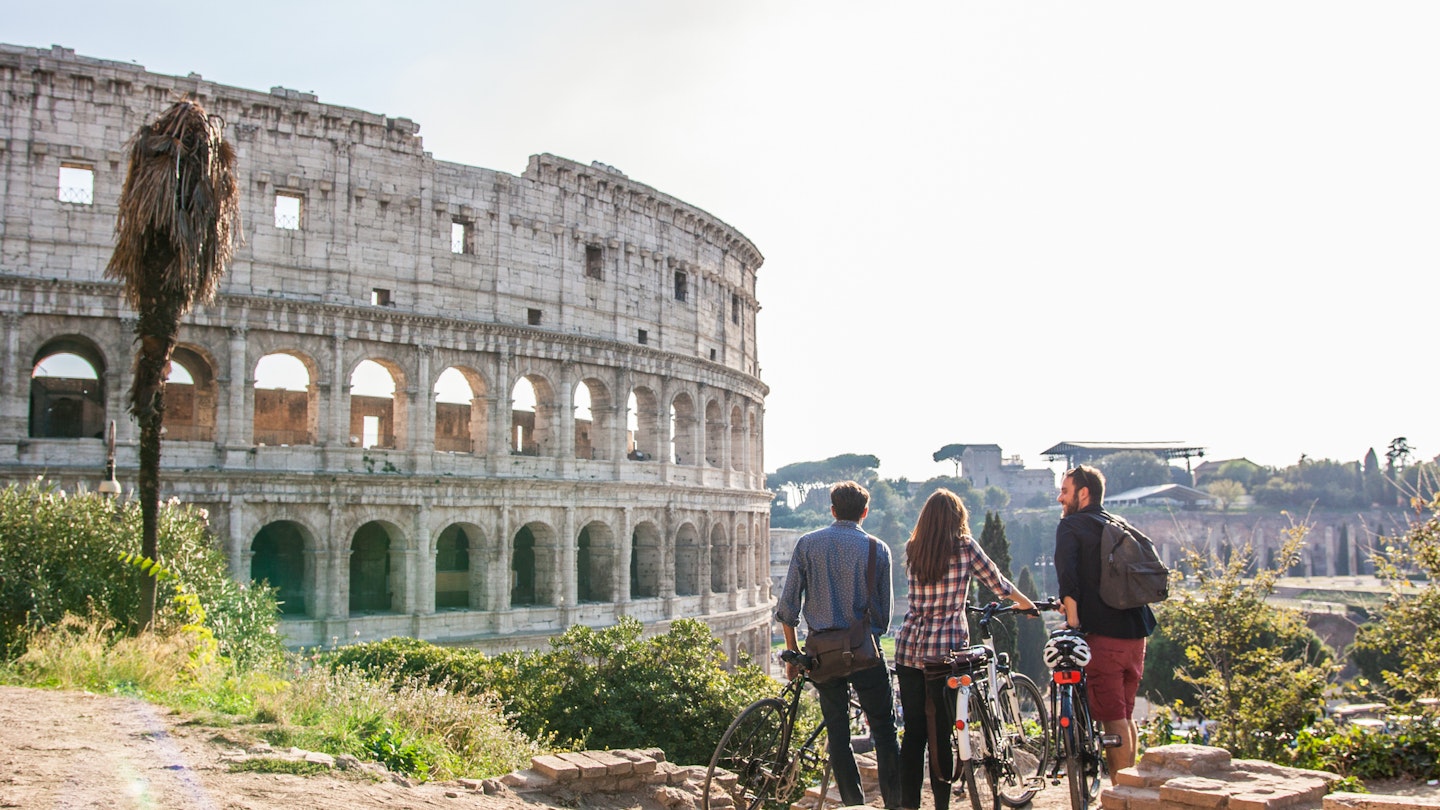
Find your way around in Rome with this guide to transportation and tickets © TFILM / Getty Images
Whether or not you find it easy to get around Rome will depend a lot on what your expectations are.
The most important thing to remember is that Rome is old. Like, old. Most of the streets have not been designed to accommodate people, buses, cars or bikes, and the underground network has been built in and around one of the most archaeologically rich locations on earth. The very things we all come to Rome to see are the very reason that it takes so long to get around it. Keep that in mind the next time you visit and remember that any confusing detours you go on may end up being the best part of your trip!
Here's what you need to know to find your way around in Rome.

Explore the city on mass transit
Just like any major city, the Eternal One has a comprehensive public transport network of buses, trams, and trains that will take you anywhere you want to go. Of course, they may also take you to a few places you weren’t planning on visiting, so it helps to get yourself familiarized before you’re on the ground. Atac, the company that operates all mass transit in Rome, has undergone a facelift in recent years and though some wrinkles are still visible, it’s a pretty convincing nip and tuck. Visitors can download maps in multiple languages from the Atac website , or download the Moovit app to get real-time info.

Metro line C is best for sightseeing
It’s helpful to remember that the two metro lines A and B mostly travel north and south, with the C line heading further to the east. The C will be one of the most familiar sights if you pass through central Rome: archaeological finds at the Imperial Forum station are so proliferate that it’s taken decades to dig for tracks. As a result, the street between the Colosseum and the Forum is lined with heavy machinery and the promise that “it’ll soon be done.” Don’t hold your breath, but don’t sweat it either, and remember that the street is still open to some traffic, so be mindful when crossing the road.
Trams run east to west
Rome’s six small tram lines are primarily useful for traveling east to west and are a good way to see the Trastevere and Monteverde neighborhoods . The trams are a fun, somewhat nostalgic, slightly nicer way to travel as they tend to avoid a lot of the car traffic. Plus, some vintage trams are still in operation, so may get the chance to catch a bit of retro cool as you go.
The tram system plays an important role in the history of modern Rome and it’s worth getting to know a bit of the background (for all of our transit history fans out there). However, an ongoing improvement project on the number 3 tram line means that you’ll need to take a bus replacement service if you want to get across the Tiber, so some of the convenience, and thus the charm of the trams, might escape you.
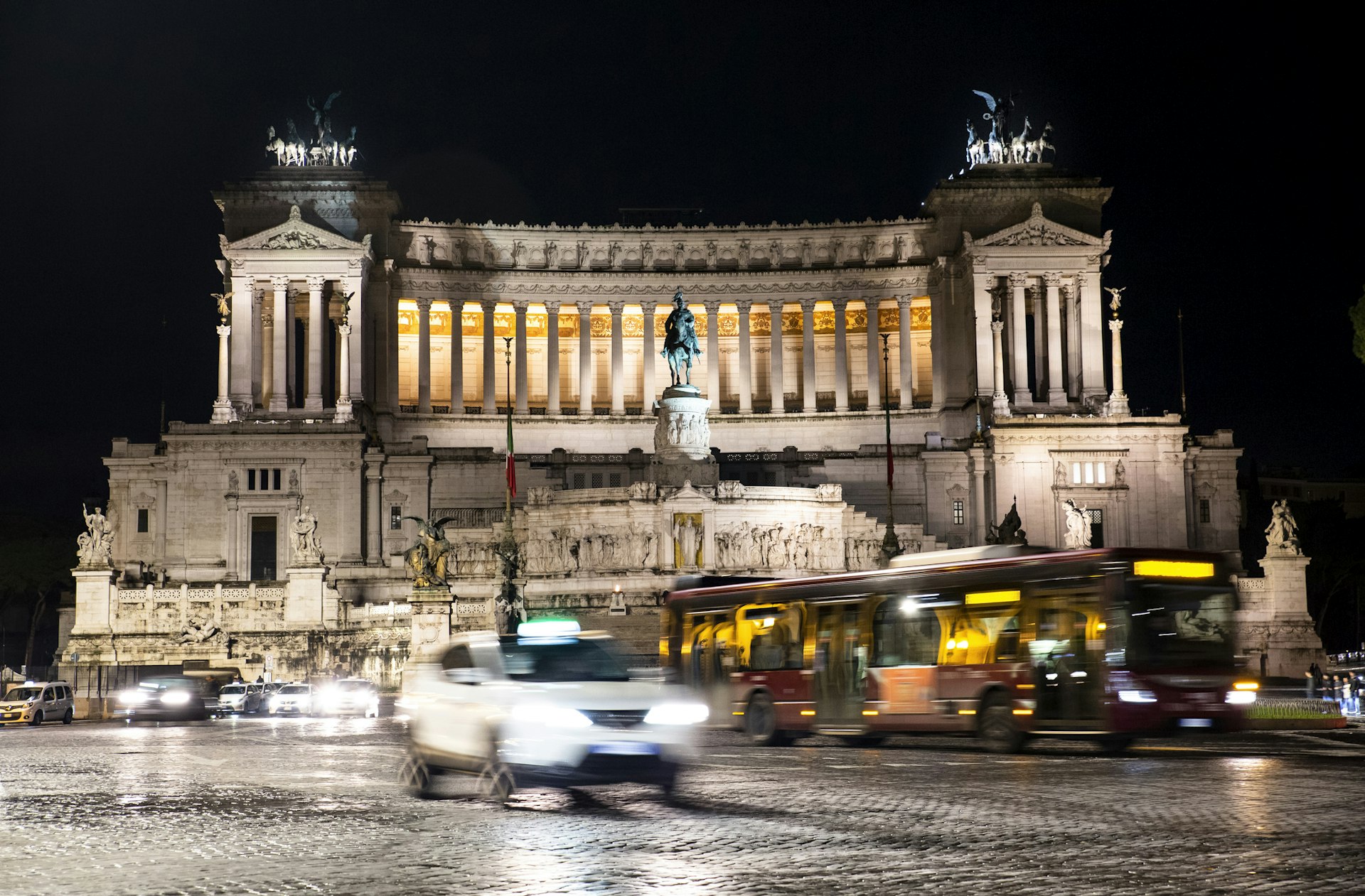
Rome's bus network is extensive
But consider that replacement bus service a good way to dip your toe in the vast bus network, which covers the most ground of any part of Rome’s mass transit system. Riding the bus is one of the best ways to immerse yourself in the cacophony of the city and though the sheer size of the network might feel intimidating, it’s worth doing.
The Atac signage at almost every bus stop can help you go in the right direction, and the Moovit app has up-to-the-minute timetables that will tell you which direction to look. And as always, don’t be afraid to ask people waiting at the same stop: you may get a few grumbles but you’re much more likely to get someone who will not only tell you whether you’re in the right place but will also make sure you actually get on the right bus.
Tickets are valid on buses, trams and metro lines
Travelers can purchase daily or weekly farecards from machines or kiosks located at the entrance to nearly every metro station, and the Tap and Go system is available to anyone with a contactless card as well as smartphones and smartwatches. You’ll be charged for single rides and each is valid for 100 minutes, as with a standard travel card. While the Tap and Go system has become quite reliable in the past year, it still has its share of hiccups and is occasionally out of service for maintenance. It doesn’t hurt to have a ticket in reserve for just such an occasion. Oh and, the ticket machines don’t give more than €6 in change so be aware before you use a €20 note to pay for a €1.50 ticket!

Walking is the best way to see some of Rome's key sites
Walking through Rome is as frenetic and romantic as you think it will be, and you’ll see icons at every turn. Much of the ancient center of Rome, which includes sites like the the Colosseum , the Forum and the Pantheon , is easily within walking distance, and on a nice day, you could cover all of these and much more.
There is always something going on and if you slow down a bit, you’ll find yourself soaking up the ambiance that makes Rome so singular. After all, it’s only by walking that you’d catch the Rose Garden hiding above the Circo Massimo , or the path that winds along the Tiber River. If you want to see Rome for what it truly can be, stop and walk for a while.
Of course, for all its magic, the center of Rome can be extraordinarily congested with foot and car traffic, so navigating these areas sometimes takes a lot of time and even more patience.
Try to avoid peak hours at places that you’re not necessarily going to enter: if you only want to walk around the Colosseum, wait until after it closes at 6pm and the crowds largely dissipate. After all, that’s the magic hour, when the light hits it just right and everything is illuminated with pink and gold hues.
Driving in Rome is best avoided
Here’s the thing. Driving in Italy is an art form, and if you can drive in cities like Rome, you've reached a new level of mastery. Romans drive with an urgency and a logic that will escape everyone else, and while it may seem that they’re aggressive (and they can be) often they’re just moving into openings in traffic that only they can see. Do not attempt to mix in this, as it will inevitably result in confusion on your part and frustration on the part of everyone around you.
Taxis are easy to find
Leave the driving to the professionals, in this case the Romans. Taxis are proliferate, and can be easily ordered via the Free Now app , which will give you fixed rates and allows you to pay through it as well. Uber is also quite reliable around the city and will give you the option of both a taxi or private hire car called an NCC, which stands for Noleggio con Conducente (hire car with driver).
Bikes and scooters are popular, but not always wise
Exercise caution with bikes and scooters in Rome. These have become a popular mode of transportation here just as in other cities around the world. Tours guides are often skilled at helping riders navigate the streets on bikes and scooters, but if you’re not used to riding in busy lanes with uneven sidewalks, you could put yourself (and others) at risk.
Rome is not very accessible
Both the national and municipal governments have been working on improving the city’s infrastructure for people with disabilities, and the ATAC website offers a comprehensive overview of the metro, tram, train and bus services for people with disabilities. According to the ATAC website, 98% of buses are equipped with boarding platforms, 70% of trams have platform level flooring, and the vast majority of metro stations have elevators as well as tactile paths and maps for visually impaired passengers, displays for those with hearing impairments, and Braille messaging. The website also has a handy search function to check whether your station has these services available, and is updated in real time for any service interruptions.
Major sites around the city offer special access to visitors with limited mobility: it’s possible to reserve a wheelchair at the Vatican museums , and the Colosseum has both ramps and elevators to facilitate movement around the monument (that said, the underground parts of the Colosseum are not wheelchair accessible). But there’s no doubt that it’s still slow going on those picturesque cobblestone streets for those with any mobility challenges, including those who might be traveling with small children and strollers. Keep it in mind as you plan your day, and if you’ve got precious cargo in hand try to schedule your iconic visits for off peak hours.
This article was first published April 2021 and updated June 2023
Explore related stories
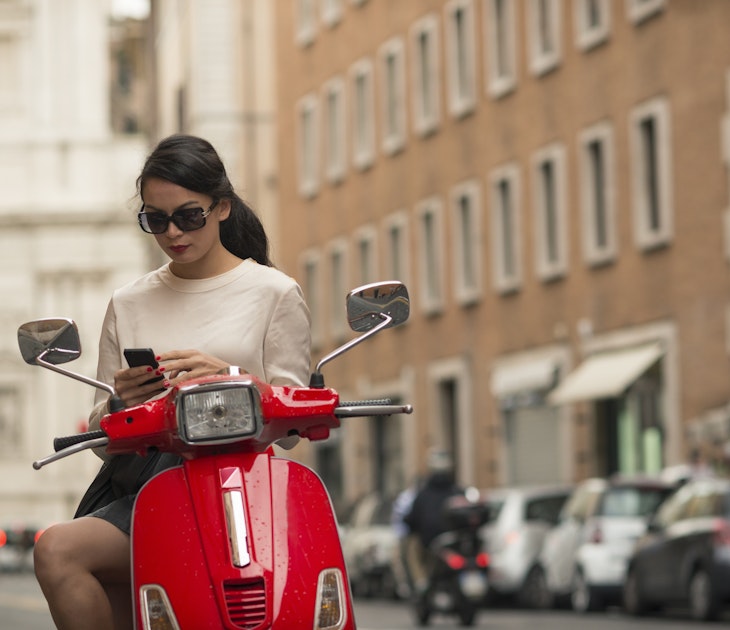
Destination Practicalities
May 30, 2023 • 14 min read
Your guide to traveling independently across Italy, from the Alps to the islands.

Apr 19, 2024 • 7 min read

Apr 8, 2024 • 7 min read
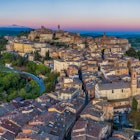
Apr 7, 2024 • 11 min read

Mar 21, 2024 • 6 min read

Mar 15, 2024 • 10 min read
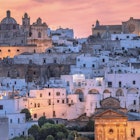
Mar 8, 2024 • 17 min read

Feb 27, 2024 • 9 min read

Feb 27, 2024 • 6 min read
How to get around Rome by metro, tram, bus and more
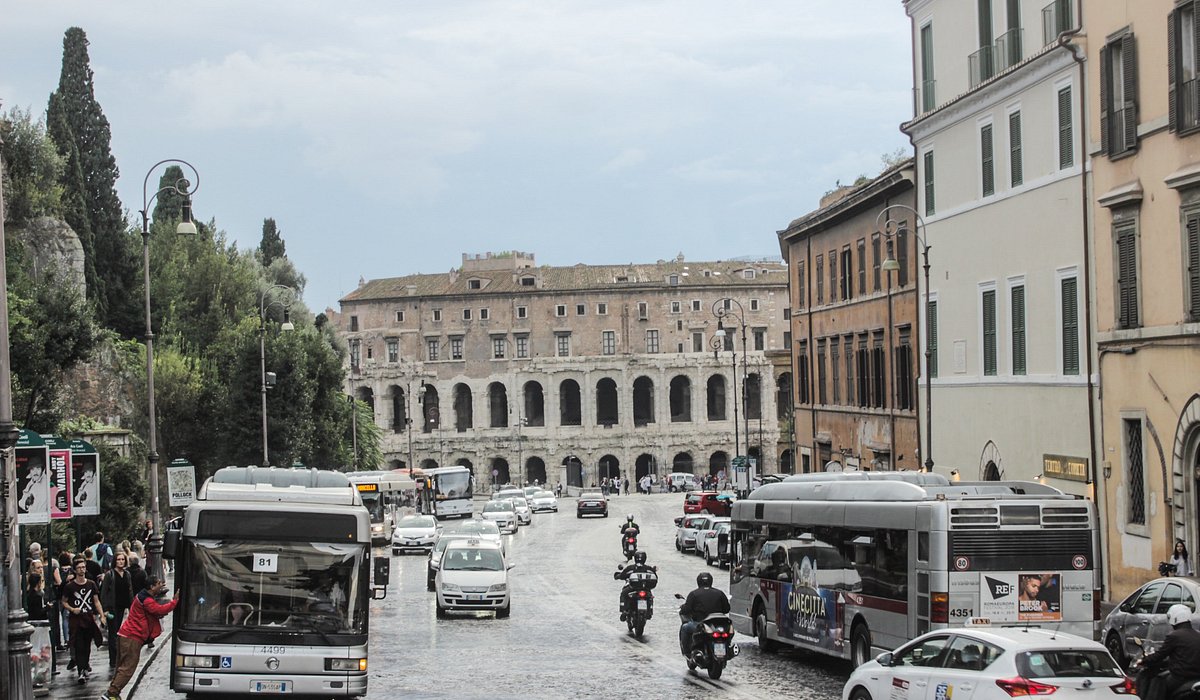
Rome is a sprawling city of over 496 square miles, which means you’ll have to navigate Rome’s transport network to travel around. Thankfully, just like most major European cities, Rome has an extensive and reliable transportation system.
Rome transport tickets and fares
Most transportation services are operated by a single company, ATAC SpA , on behalf of the local government. This makes it easy to switch between modes of transportation—the same ticket types can be used across the metro, buses, trams, and urban trains.
A BIT (one-way ticket) costs $1.58; frequent travelers can save more by getting a 24-, 48-, or 72-hour travel pass, which range from $7.39 to $18.99. Tickets can be purchased at any metro station kiosk, newsstand, or tobacco shop. ATAC has also recently implemented the contactless “tap&go” program, which automatically charges you the cheapest rate based on all your journeys over 24 hours—no mental math required.
Getting around Rome by metro

Best for: Sightseeing within the city
The metro consists of three lines that cross the city: A (orange), B (blue), and C (green). This is one of the most convenient travel options for tourists, as most of Rome’s attractions are located near metro stations, such as the Colosseum and the Trevi Fountain .
During peak hours, trains arrive almost every two to three minutes but expect to wait up to 10 minutes at off-peak timings. The metro operates from 5.30 a.m. until 11.30 p.m., with extended hours until 1.30 a.m. on Fridays and Saturdays. Check out our guide for more tips on navigating the Rome Metro .
Getting around Rome by bus
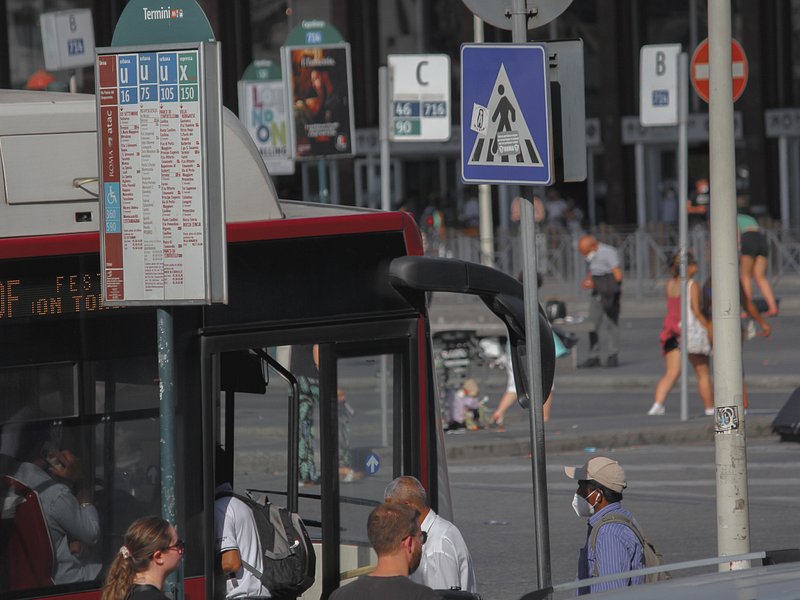
Best for: Experiencing Rome like a local
As metro routes mainly cover tourist attractions, going anywhere else via public transport will require a bus ride. For instance, if you plan on visiting the catacombs along the Appian Way , you’ll need to take a bus from Piazza Navona .
You can find bus routes and timetables at various bus stops. Most buses run from early morning until midnight, with night buses taking over the remaining hours—if you’re out late, look out for bus stops with a blue owl symbol. Plan your travel routes and stay updated on the go by downloading apps like Roma Bus .
However, keep in mind that Rome’s narrow streets tend to get congested, so public buses are often delayed and may slow to a crawl. To maximize your time in Rome, consider joining private bus tours for a more personalized journey. The Big Bus Hop-on Hop-off Open Top Tour stops at key attractions, and its open-air upper deck offers a bird’s eye view of the city.
Getting around Rome by tram

Best for: Eco-conscious travelers or families
Rome’s tram network has been around since the early 1900s, and is now fragmented and rather limited. It’s primarily used to get to residential neighborhoods like Flaminio . Parts of the tram lines are also falling into disrepair, forcing trams to slow down significantly at certain points for safety reasons.
Today, trams are gradually making a comeback as a more eco-friendly option. They also tend to be cleaner and less crowded. Get a taste of vintage Rome by hopping on the 19, which will take you to the Vatican ; gaze out the windows to watch the Tiber River and Villa Borghese flicker by outside.
Getting around Rome by urban train
Best for: Venturing out of the city
Ferrovie Urbane , Rome’s urban railway network, is useful for travelers looking to get out of the city. There are three lines, with a fourth under construction. Urban trains run every 10 to 20 minutes from 5.30 a.m. to 10.30 p.m.
Enjoy a beach getaway in Rome by hopping on the Roma-Lido railway line towards the seaside town of Lido di Ostia , where you’ll also find the Archaeological Park of Ostia Antica . This exclusive guided tour will let you skip any long lines.
Getting around Rome by taxi

Best for: Convenience
Price: Charged by distance, with base fares of $3.17 on weekdays, $4.75 on Sundays and holidays, and $6.86 at night
Whether you’re struggling with shopping bags or sore feet, sometimes a taxi ride is just what you need. The most reliable way of getting a taxi is by looking for a taxi stand , usually located near metro stations and tourist attractions. You can also call for a cab or use an app like Free Now , but the meter will start running once the driver accepts your request. While Uber is available in Rome, you’ll only be able to book an Uber Black, Lux, or Van due to lobbying by the city’s taxi drivers.
To avoid fare discrepancies, we recommend looking for licensed cabs—these are white, with a “TAXI” roof sign, meters, and the symbol of the City Council of Rome clearly visible on their front doors. Remember to ensure that the taximeter is switched on, and always ask for a receipt. Note that taxi rides to and from Rome’s airports are fixed at $50.65 for Fiumicino Airport and $31.65 for Ciampino Airport .
Getting around Rome by car

Best for: Road trips out of Rome
Price: Up to $273 per day
Thinking of taking a road trip to Pompeii or the Amalfi Coast ? Those above 21 can rent your own car or opt for car-sharing services like Share Now. However, you won’t be able to drive within the Centro Storico —where most major tourist attractions are located—and popular areas like Trastevere and Monti .
There are also plenty of private taxis and shuttles available for booking, where you can relax in an air-conditioned vehicle while your personal driver takes you on a sightseeing tour around Rome’s churches , lesser known attractions , and wineries . If you’ve done your research, you can even fully customize your itinerary . We also recommend scheduling a private transfer from the airport so that your driver will be waiting for you the moment your flight lands.
Getting around Rome by bike or scooter
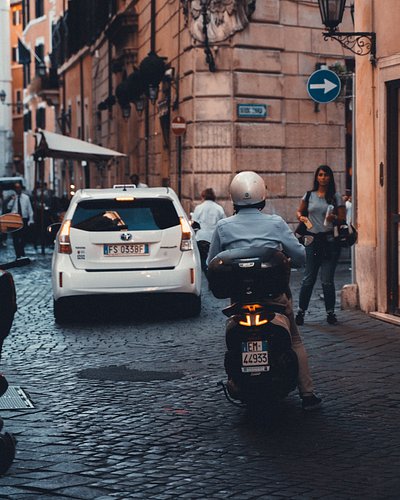
Best for: Adventurous travelers on a budget
Price: From $17 per day
Cycling in Rome is a great way to get around the city, especially as the Centro Storico is mostly car-free. If you hope to avoid bad traffic and the crowded metro, cycling is your best bet. Rome has many bike lanes, and it’s also relatively easy to find bike rental shops , especially in areas like the Circus Maximus . Bike tours are also available, whether in the city or the countryside .
Or channel your inner Audrey Hepburn and hop on a Vespa—although you’ll need a driver’s license or permit as well as a helmet to rent your own scooter in Rome. Otherwise, join a scooter tour to zip around the city on the back of a Vespa or a vintage sidecar .
Getting to Rome from the airport
1. leonardo express.

Price: $14.77
This direct non-stop train takes you from Fiumicino Airport to Termini Station in just 32 minutes. From there, you can connect to the metro. The Leonardo Express is ideal for families looking for a fast and convenient way to get into the city—children under four travel free; those under 12 travel free with every paying adult. It runs every 15 minutes, between 5 a.m. and 11 p.m. Pre-book a ticket online or buy one at the airport.
2. Airport bus
Price: From $5.28
Companies like Terravision operate shuttle buses between Fiumicino Airport or Ciampino Airport and Termini Station, each with different timings, frequencies, and fares. This is the cheapest way to get into the city, but it might take up to an hour depending on traffic.
3. Private transfer from the airport
Price: $37 per adult or $94 per group of three
Pre-book a private transfer for a hassle-free arrival. Your driver will be waiting for you once you exit the airport. Some companies charge per adult ; others charge per group .
Price: $50.65 from Fiumicino Airport, $31.65 from Ciampino Airport
Taxis are required to charge a flat fare from the airport to a location within the boundaries of the Aurelian Walls in Rome. Avoid unlicensed drivers and only get a cab from an official taxi stand.
Not sure which is the best airport for your trip? Check out our Rome airport guide for more insights.
Recommended tours and activities

More like this:
- How to see the best of Rome in 3 days for first-timers
- The best espresso in Rome: 10 of the city’s finest coffee bars
- Your guide to the best Michelin-starred restaurants in Rome
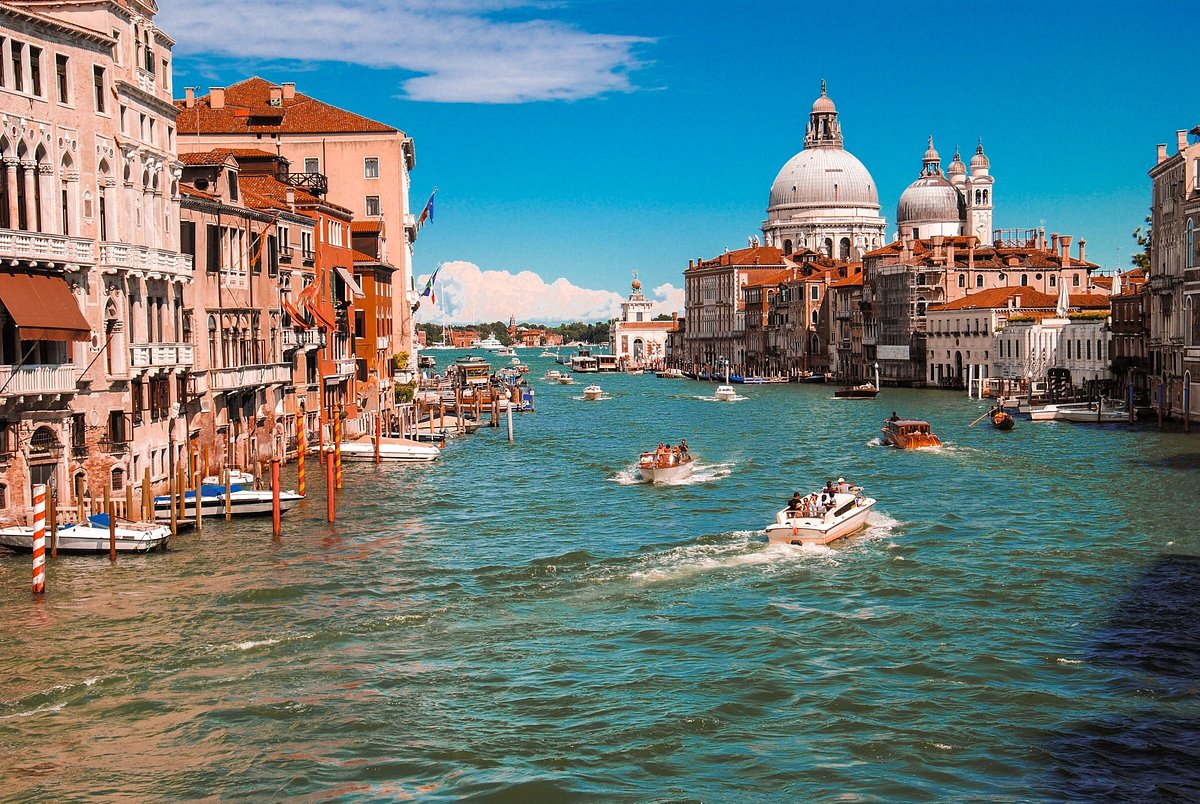

The Best Way to Get Around Rome – All You Need to Know
I’m often asked what’s the best way to get around Rome. For short vacations spent in the city center, we can agree that on foot is certainly one of the best and favorite ways to get around Rome.
The answer to this popular question, however, is not a short one. Rome is a huge city, so there is not one single way to get around, but much depends on where you are staying and where you want to go.
There are many ways to get around Rome. In this handy article, I’m going to guide you through how to get around Rome and what means of transportation to choose whether you are staying in the city center or not, and also depending on where you need to go.
Are you ready? Read on and plan your best and smoothest Rome trip!
Table of Contents
How to get around Rome – Full guide to navigating the city
This is my favorite and for sure one of the best ways to get around Rome if you have booked your room in the city center and this is where your holiday will mainly take place. Rome’s city center is pretty walkable. Even though quite large and consisting of different areas, walking around the central districts of Rome is just like visiting a museum with the perk that it’s free.
Of course, from the Vatican to the Capitoline Museums is not a short walk, but if you plan your trip properly and make daily itineraries, you will be able to do all or most of your holiday on foot. In fact, if you are staying in Rome for a day only and it’s your first, I would suggest spending 24 hours in the city center as there is plenty to see and do.
If you are staying longer, the best thing you can do is draw daily itineraries so each day you have a more compact area to visit and you can walk in between landmarks. If you are staying far from the city center, you can reach by public transport in the morning and walk for the rest of the day you want to spend downtown.

Rome buses are run essentially by two companies, ATAC and TPL. ATAC is the public company of Rome’s municipality and runs most buses, especially in the city center. Taking the bus is convenient when there is no metro or train where you are going because usually, the bus takes longer.
Unlike metro and trains, in fact, buses mostly run through general roads and often get stuck. There are also devoted bus and taxi lanes across Rome, but not everywhere, so buses are not always faster than cars and immune to traffic jams.
If you decide to use Rome’s public transport , you can purchase single tickets with a 100-minute validity, 1 full day, a week, or even a month. With a single ticket, which costs €1.50, you can do 1 train ride, 1 metro ride, and unlimited bus rides always within its validity.

Rome’s metro is one of the best and fastest ways to get around Rome. Unfortunately, it doesn’t cover a very widespread network. There are two lines, A e B, and in the past few years, they have been opening the third line, C, and gradually opening more stations.
This is great because it considerably expands the metro network, but it’s still extremely limited considering the size of Rome. Let’s just say that Rome’s metro is nowhere near London’s or Shanghai’s metros.
If your route has metro stations, this is definitely how to get around Rome if you are short on time and want to avoid traffic. Unless you have specific appointments, I suggest avoiding rush hours both in the morning and in the afternoon because the trains get extra packed and uncomfortable.
Using the tram is also a good way to get around Rome. It’s similar to taking the bus, so street level, but trams have their own stops and usually their own platforms. Trams are also faster than buses because they have their lanes, and while sometimes cars can cross them, trams have the right of way and anyway never stop to let anyone pass!
Usually, after train and metron, the tram is my go-to mean of transportation in Rome because it gets less stuck in traffic than buses. Some of the trams you will find in the city center include n. 8 from Casaletto to Piazza Venezia across Trastevere and Largo Argentina, and n. 19 connecting the Vatican and Prati areas to the neighborhoods around Villa Borghese, Nomentano, and Esquilino.

The train is another of my favorite means of transportation and one of the best ways to get around Rome. Maybe because I live near a train station and it gets me just about everywhere. The railway line that crosses my neighborhood connects us to metro lines A and B, and several other major train stations such as Tiburtina, Ostiense, Trastevere, and San Pietro.
The urban railway in Rome is great because quite widespread and connects the whole city with the suburbs. I live near an A90 highway exit and yet in 20 minutes by train, I’m in the San Pietro station, with only one train change I arrive at Termini station, and in about 30 minutes I reach Trastevere station.

If you need to get around Rome far from the city center, or at night, or to an area that’s not well served by public transport, you can call a taxi. Taxis in Rome are pretty much everywhere, either in specific stations from where they gather and depart, or running around the city.
If you see a taxi, you can wave to call it but make sure it’s not taken. If the light on top is on, it’s either already on a call or there are passengers inside the car.
You can also call a taxi in Rome at the local number 063570 and book an appointment even from the day before specifying the time and place.
I hardly recommend driving in Rome because of its mental traffic, hard time finding a parking space, and the ZTL that doesn’t allow you to access the city center, making it difficult if you want to book here your hotel.
However, if Rome is a stop in your longer Italy trip and you have rented a car, there are a few things you should keep in mind. First of all, it depends on how many days you are spending in Rome . If you stay only 1 or 2 days, you can keep your car parked and get around Rome by public transport.
On the other hand, if you are staying in Rome for 4 days or even a week , you need to think if it’s the case to drop off the car and rent it again when you are leaving for the next destination in your Italy itinerary .
Best way to get around Rome – FAQ
What is the cheapest mode of transport in rome.
The cheapest mode of transport in Rome is the train because a single ticket with Trenitalia is 1€ as opposed to the €1.50 of the ATAC tickets. However, if you buy a single ticket from Trenitalia, you are only buying a train ride while using an ATAC single ticket, you pay €0.50 more but you have 1 metro ride, unlimited bus and tram rides, and also 1 train ride.
So if you know you are going to need a bus or the metro once you get off the train, you need to buy an ATAC ticket, otherwise, you will end up paying more! To use the bus and metro, in fact, Trenitalia fares are not valid.
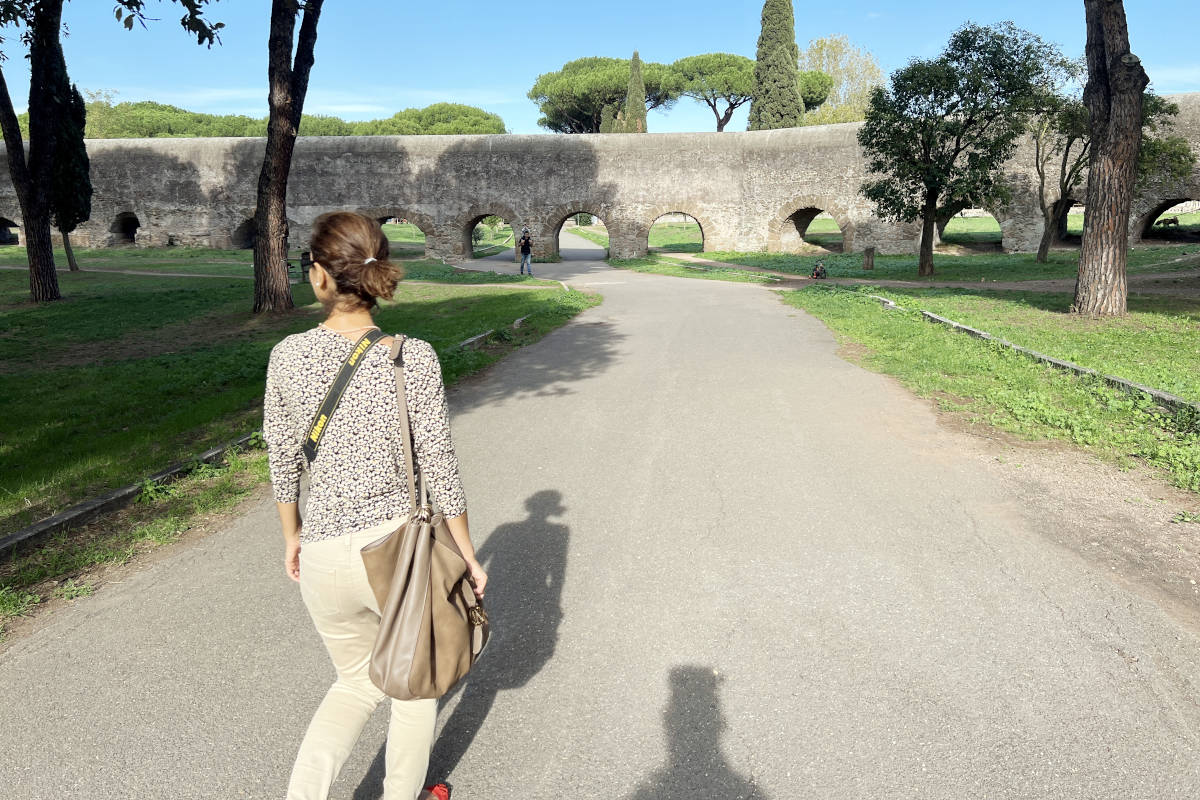
How do most people get around in Rome?
Romans drive a lot. In general, in Italy, you will notice that people love to go anywhere by car. In Rome, however, many also opt for public transport, especially if they need to go to central neighborhoods where there is the ZTL or if it’s rush hour because the traffic can get really stuck.
Often, citizens coming from the towns around Rome or the suburbs drive to the nearest train station, park their cars, and move around the city by public transport. This is a much more doable option than driving everywhere because, on weekdays, traffic gets really mad.
Does Rome have Uber?
Rome has also Uber , but it’s not the cheap lift service you know from the U.S. In fact, Uber in Italy is only allowed to use its luxury services like UberBlack, UberLux, and UberVan. The popular UberPop option where any private driver can register and provide lifts without any government-issued authorization, in Italy is not allowed.
About The Author: Angela Corrias
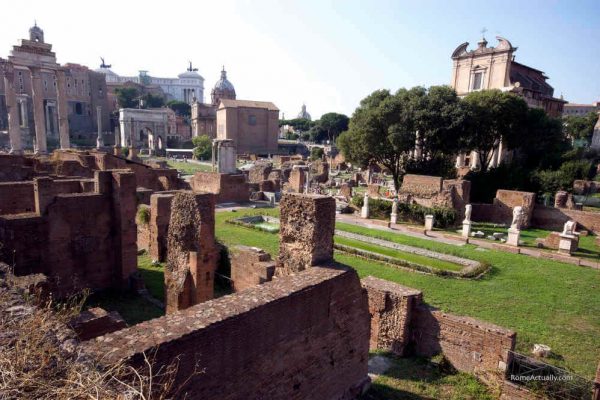
Birthday of Rome, All You Need to Know About the 21st of April in Rome (2024)
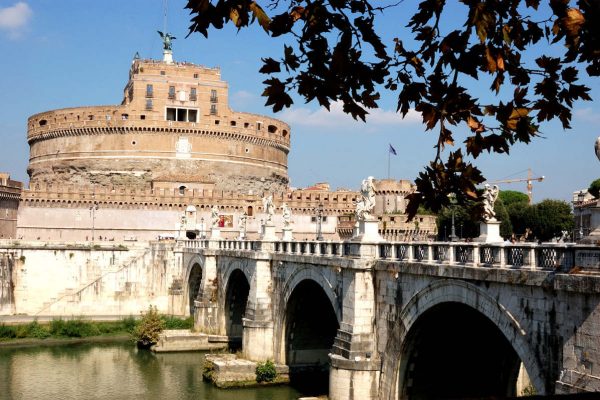
Rome in 2 Days: How to Make the Best of a Weekend in Rome

Rome Public Transport – Easy and Complete Guide

12 Best Cooking Classes in Rome – How to Make the Perfect Pasta and Pizza in Italy
Leave a Comment Cancel reply
This site uses Akismet to reduce spam. Learn how your comment data is processed .
Privacy Overview
How to get around Rome: Rome transportation guide for all types of visitors
Our Rome transportation guide shows the best way to get around Rome, with options for all types of travel including airport connections and inner city transportation.
If you are planning a trip to Rome, chances are you already have a list of Rome main attractions you know you want to see.
You may even have an itinerary, with what you intend to see when, but you may be stumped about the more practical details of your day: how do you get from one Rome attraction to the other?
Figuring out how to get around Rome, is not easy if you’re never been to the city, but I am here to help!
In this guide, you will find my best tips on how to get around Rome, when and how to use Rome’s public transport service, when to rely on taxis and additional helpful transport options in the Eternal City.
Please note: this post contains affiliate links. Should you make a purchase through them, we might make a small commission at no extra cost to you.

Table of Contents
Rome Transportation Guide options at a glance
How to get around rome: airport to hotel connections.
Rome has two airports, Fiumicino/ Leonardo da Vinci (FCO) and Ciampino (CIA).
To go from Fiumicino to Rome you can choose:
- Train Leonardo Express Airport Shuttle
- Bus shuttle
- Private airport transfer
You can read here >>> my complete guide: how to get from Fiumicino Airport to Rome city center <<<

From Ciampino, you can choose between:
- Bus + train service
You can read here >>> my complete guide: how to get from Ciampino Airport to Rome city center <<<
Once you have made your way to the city, you have several ways to navigate Rome.
The best way to around Rome: inner city transport guide – Walking around Rome
If you like to walk and have no mobility issues, by far the best way to get around Rome is on foot.
Rome city center is not small however, it is rather compact and many main attractions are close to one another.
To give you an example, you can walk from the Spanish Steps to the Trevi Fountain in about 8 minutes, and from Piazza Navona to the Pantheon in less than 5!
If you have accommodation in the city center, which I consider the best area to stay in Rome , you are likely to be able to walk everywhere: you will probably end your day clocking in well over 20,000 steps, but you won’t feel them along the way as the city will keep delivering beaitufl corners and unexpected gems every step of the way!
See here >>> How far are Rome main attractions from one another? <<<
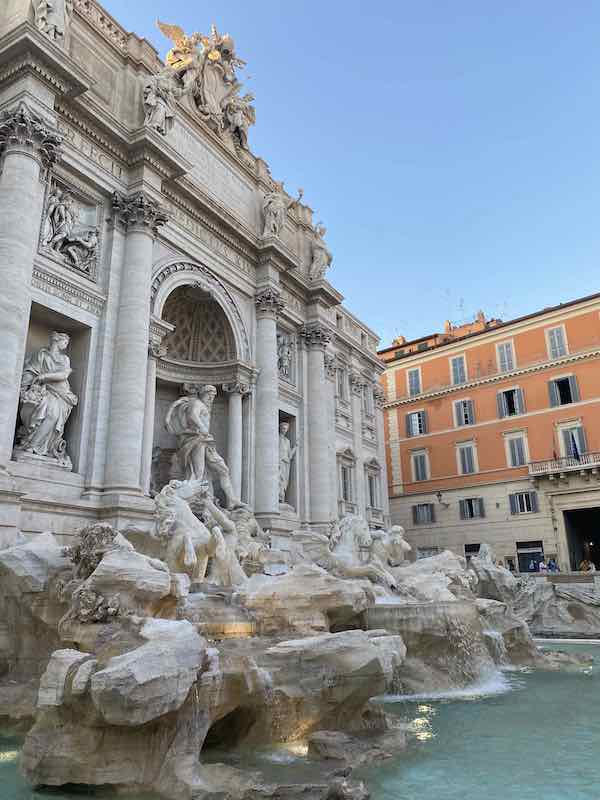
The advantages of getting around Rome on foot are:
Budget : you can spent a whole day in Rome sightseeing on foot for absolutely free
Sights : Rome city center is a true open air museums and most of its gems and secrets can only be spotted on foot, venturing into its small streets and hidden piazzas
The low environmental impact of walking and the exercise you get are of course added values too: it’s even easier to indulge in that extra slice of pizza and that gelato, after walking all day, no?
For walking in Rome, good shoes are paramount. Find here >>> the best shoes for Rome travel <<<
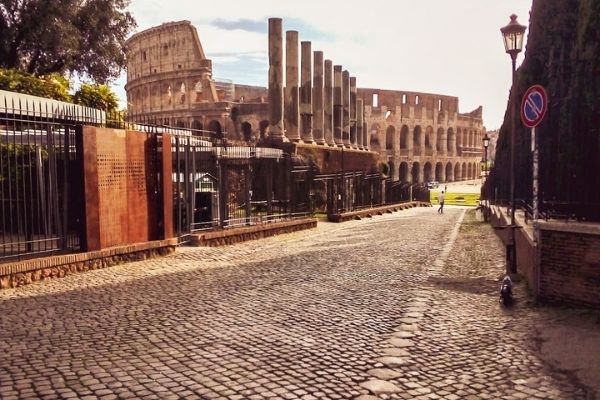
Exploring Rome by public bus or tram
Rome has a large network of buses and trams, managed by the local public transportation company ATAC.
Buses are a good option for longer inner city journeys and are cheap. However, in most cases a joinery on a Rome bus is not a pleasant experience.
Rome buses have an erratic timetable (usually not shared with the users and not respected anyway), they are often so busy you feel like you are standing in a sardine can and they are only accessible via tall steps, that make them hard for anyone without anything less than excellent mobility.
There are of course exceptions: some lines are often ok during off peak hours and if you’re not in a hurry it is often not too much of a bother having to wait for a bus.
However, the systems is far from flawless so, as much as possible, I recommend you avoid it or embrace it as ‘local experience’!
Trams are usually a little less busy and, often it is even possible to find a seat. If you have accommodation along the tram line, they are good option.
You can find here >>> my complete guide to using the bus in Rome <<<
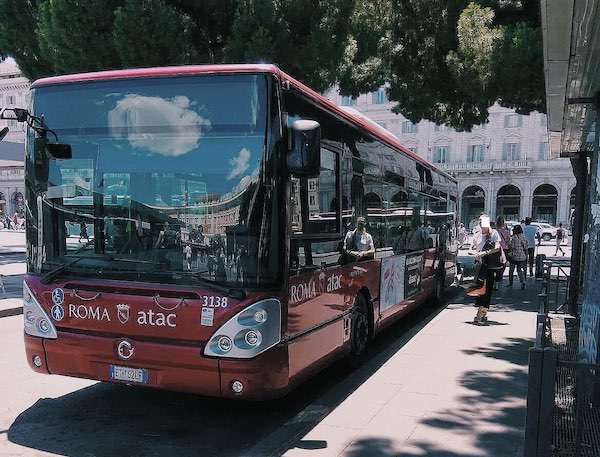
How to get around Rome by metro
Rome has a metro system which serves a few main landmarks are areas such as the train station, the Vatican and the Colosseum, among others.
Despite constant work on the network unfortunately the Rome metro system is all but flawless.
Compared with other cities in Europe, the network is limited, dirty and often erratic, with stations poorly or not at all accessible and old trains.
Despite this bleak introduction, the metro in Rome is excellent if you are staying further out of the center and close to a stop so I believe it belongs in this Rome transportation guide!
In that case, with the right expectations, you will find that the system does its job… most of the time!
I recommend you only plan on using the metro if you have no mobility issues, can walk up and down steps and you don’t have children in strollers – Rome’s metro is not stroller friendly.
Moving around Rome by hop-on hop-off buses
Hop on Hop off buses are a good option to go from one of Rome’s attractions to the next. However, they are rather pricey and they still require you to do some walking, so it is important to evaluate well if they are a good solution for your needs specifically before committing.
The main things to know about Rome hop on, hop off buses is:
There are several lines and several providers, covering different parts of the city. Since they are independent one from the other and business competitors, it is paramount to choose the line that best suits your needs as you won’t be able to use your ticket on any other.
Since buses are bulky, they are not able to reach inner piazzas, smaller streets or leave the main roads.
This means that you will often have to walk from the stop to the attractions: it may be only a few minutes, but if you have mobility issues, it is important to know they will not simply drop you in front of attractions as they usually cannot access the inner part of the city centre.
Hop on hop off buses in Rome are expensive and only really good if you take them several times in one day. in the city centre, you will often find yourself walking instead, as there are many attractions at a short distance one from another.
I recommend you plan a precise itinerary before opting for a hop on hop off bus tour as transport to make sure you make the most of your ticket.
Exploring Rome by Golf Cart Tour
Golf Carts are a popular tour option in Rome.
They are not a means of transport you can just flag on the streets and hop onto; however, they are a great way to discover the city without having to walk and without having to worry about erratic bus schedules or traffic.
They are particularly popular with families with kids, anyone who cannot walk loping distances but also people who want to spend a fun afternoon with a guide and Romes’ beautiful breeze in their hair!
The advantages of a Golf Cart Tour are:
- No walking needed: the cart will be able to reach even small streets and attractions precluded to big buses so you won’t have to walk much, to at all
- Open sides offer great views
- Suitable for all ages
- Experienced guides can help you understand what you are seeing and give you the lay of the land.
You can find here >>> our favorite Golf Cart Tour in Rome <<<
Exploring Rome by Vespa
Riding a Vespa is one of the most enjoyable ways to explore Rome. However, it is not for the faint of heart!
Photos of vespa experiences show people whizzing along the Colosseum with Rome’s warm air caressing their skin and indeed, this is just what a vespa drive in Rome feels like.

What the photos do not say though is that the experience also comes with cars beeping at your, crazy traffic from all sides, potentially slippery cobbles and the need for a lot of traffic awareness at all time.
I do not want to discourage you about vespas, they are really fun: however, if you are not used to city traffic, have never driven a vespa style scooter or you are hoping to ride with your child, please experience Rome traffic first or consider a tour with an experienced driver.
If you want to drive your own, I recommend you book a vespa with a good cancellation policy and leave the tour for day 2 or 3 in Rome, so you can first see if the traffic is manageable for you or too stressful.
Please note: to drive a vespa, you need a suitable driving licence and to be of legal driving age in Italy.
Have a look here >>> at vespa booking prices and rules in Rome <<<
Moving around Rome by bike
Bikes are getting more and more popular in Rome, mostly in response to unmanageable car traffic.
However, Rome is not a bike friendly city, especially in the city centre.
Built on seven hills, Rome has a lot of uphill areas that make cycling rather tiring.
On top of this, many areas of the city center have cobbles, which are dangerous on bikes, and the traffic is so busy and fast, it requires bikes to be extra careful at all times.
Like for the Vespa, I recommend you come to Rome and see the traffic and landscape situation before committing to exploring by bike. At quieter times it can be a fun way to see the city; at busier times you may find it overwhelming.
In general, I only recommend using bikes in Rome if you are an experienced city cyclist: I do not recommend renting them with kids, unless you to car free areas to areas served by cycling lanes (ask your bike rental shop for cycling maps of Rome).
Find here >>> example of Rome bike rental with prices <<<
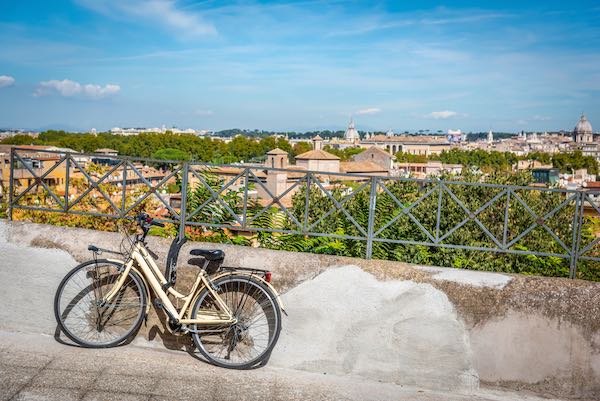
Getting around Rome by E-bike
E-bikes are going though a surge in popularity in Rome and are indeed a better way to explore the city than standard bikes as they will assist you on the many hills of Rome!
Like bikes and vespas, e-bikes in Rome are potentially dangerous for traffic.
As said above, bike lanes in Rome are few and far between, especially in the center, and cars are not gentle – they will beep at you, try to overtake you and, in the mess of Rome’s traffic, they may also not see you so you have to be alert and super careful at all times.
Need to know: e-bikes are motorized and therefore follow minimum age requirement for driving just like scooters and vespas. If visiting Rome with kids, ask your e-bike rental place what the requirement are to avoid disappointment.
Find here >>> Rome E-bike rental example with prices <<<
How to get around Rome by Taxi
Taxis are the most convenient option to get around Rome for distances you cannot cover on foot.
Official taxis in Rome operate with a meter and you never have to discuss or haggle with the driver as all fares as available in the cab, so you always know what you get.
While not the cheapest option, taxis are a great solution especially in the evening.
You can find here >>> our guide to using taxis in Rome <<<
At the time of writing, Uber is only available in Rome in the expensive ‘Uber Black’ option, which offers no advantages vs an official taxi.
However, Uber recently announced a new agreement reached with Rome taxi drivers so this may change soon. I will update this Rome transportation guide as soon as standard Uber in Rome becomes available and I can report based on personal experience.
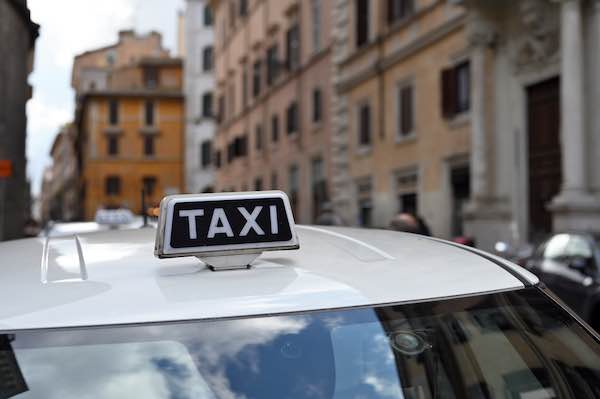
Moving around Rome by electric scooters
A Rome transportation guide would not be complete with a mention of electric scooters, a means of transport you will encounter often in Rome city center, usually unruly parked on pavements!
Electric scooters became available in Rome a couple of years ago and have received mixed reactions.
On one had, they are convenient and fun; on the other hand, the mix of cobbles, traffic and poor regulations have made them one of the most dangerous means of transport in Rome, for number and seriousness of accidents.
Like for vespas, mopeds and bikes, I recommend using caution if planning on using an electric scooter in Rome and see in person what Rome traffic feels like before committing.
If you decide an electric scooter if for you, you can find into on how to rent one in Rome here .
So, what’s the best way to get around Rome?
As you can see from all the examples above, the best way to get around Rome is on foot and by taxi.
However, several alternative options are available to suit most types of travelers so you know that, no matter what, you can explore Rome at your own pace.
I hope you enjoyed this Rome transportation guide and it helped you plan your stay.
Safe travels to Rome!
Rome Transportation guide: pin this!
Keep this Rome transportation guide with you at all times by saving it on Pinterest!

My name is Marta, I am a travel-loving mama born and bred in that messy, wonderful, infuriating, awe-inspiring unbelievably beautiful city that is Rome. A classics graduate and professional travel blogger, on this site I share my insider tips to help you plan your dream trip to Rome, Italy.
Six days in Rome with kids: how to plan your stay – day by day itinerary and tips
Viaggio nei fori, rome: all you need to know about rome’s most exciting light show, you may also like, what to wear in rome in june: full..., rome scavenger hunts for kids you’ll love (with..., how to enjoy rome on a budget: 22..., how to see the best of rome in..., visiting rome with kids: tips + all you..., the pasta making class in rome you’ll love:..., 9 fantastic kids’ attractions in rome they’ll love, how to buy tickets to the colosseum in..., how to buy colosseum tickets from the official..., piazza navona christmas market: all you need to..., privacy overview.
The Best Time to Visit Rome
Weather & Climate
Rome Airport Guide
Tipping in Rome
Rome's Top Neighborhoods
Public Transportation in Rome
Itinerary: 3 Days in Rome
Day Trips From Rome
Rome's Top Attractions
Free Things to Do
Things to Do With Kids
Beaches Near Rome
Top Museums in Rome
Where to Shop in Rome
Events in Rome
The Best Food to Try
The Top Restaurants in Rome
Nightlife in Rome
Your Trip to Rome: The Complete Guide
TripSavvy / Christopher Larson
:max_bytes(150000):strip_icc():format(webp)/ElizabethHeath-Headshot-horiz-e7525e97616245958bf3d94e8db7f119.png)
Rome, Italy, commonly referred to as the Eternal City, is a top travel destination that draws millions of visitors each year. An exuberant and modern world capital, Rome offers travelers fascinating reminders of its imperial past at every turn. It's also an international hub for contemporary fashion, design, art, and culture.
Encounter glorious monuments and ancient ruins dating as far back as at least the 3rd century B.C. Marvel at the stunning Romanesque- and Gothic-style architecture, medieval churches, picturesque squares, Baroque fountains, and world-class museums . Besides having an almost unlimited number of sights and attractions to see, Rome is famous for its traditional Roman food and wine and its vibrant nightlife , as well as pretty urban parks and peaceful nature reserves.
Planning Your Trip
Things to know before you go:
- Best Time to Visit : Since Rome has a Mediterranean climate, there's really no bad time to visit . If you want to avoid the crowds and the heat of summer, we recommend coming to Rome in the late spring or early autumn when the weather is mild and lines tend to be shorter. For average daily temperatures and rainfall, month by month, see our article.
- Language: Italian is the official language , but you'll find that many people speak some English, especially those who work in the tourist industry. That said, it's always a good idea to bring along a pocket-sized phrasebook or download one of the many free language translation apps on your smartphone, just in case.
- Currency: As a member of the European Union , Italy uses the Euro (€). Prices include tax and credit cards are widely accepted in restaurants, hotels, and shops. But when purchasing small items like a cup of coffee, a slice of pizza, or a glass of wine, plan on paying cash.
- Getting Around: Although Rome is a big metropolis, the historic center, or centro storico , is fairly compact, making it a highly walkable city. Public transport in Rome is run by ATAC , which operates the buses and trams linking riders to most areas in the city. The Metro subway system is affordable and quick.
- Travel Tip: You might find shorter lines if you visit the most popular attractions in the early afternoon when most people are at lunch.
Getting Around
Rome has an extensive public transportation system that consists of the Metro (subway), buses, trams, and three suburban railway lines (FS). Convenient and relatively inexpensive, the network connects to Rome's most popular tourist attractions but can be sometimes unreliable and overcrowded, especially during the summer months.
Things To Do
With so much to do and see in Rome, we recommend you start by hitting the major tourist attractions first—especially if this is your first visit. Regardless, do make sure to leave time in your schedule for people watching on an intimate piazza or strolling down Rome's many charming streets and cobbled alleyways.
Here are just some of Rome's top attractions:
- The Colosseum or Colosseo is the largest monument from Imperial Rome still in existence today. The enormous amphitheater once housed fierce gladiator contests and wild animal fights. It's best approached from Via dei Fori Imperiali to get the full effect of its grandeur. Entrance lines can be long, so check out our tips for buying Colosseum tickets and avoid waiting .
- The Pantheon , one of the world's best-preserved ancient buildings, this masterpiece of Roman architecture began as a pagan temple before becoming a church in the 7th century AD. Located on Piazza della Rotonda, the Pantheon has a cylinder-shaped, hemispherical dome featuring a round hole in the top, the oculus, that allows natural light to stream in, as well as raindrops. Admission is free.
- Vatican City, the home of Saint Peter's Basilica and the Vatican Museums, is the world's smallest city-state. Geographically located within Rome, but not actually part of it, St. Peter's is the largest church in the world and houses important works by Michelangelo and Bernini. The Vatican Museums ( Musei Vaticani ) is a massive complex that contains an impressive art collection spanning 3,000 years—from Classical to modern eras. It's here that you can see the Sistine Chapel featuring Michelangelo's renowned frescoed ceiling.
For more information and details about Rome's sights and attractions see our 3 Days in Rome: What to See and Do or The 25 Top Things to Do in Rome.
What to Eat and Drink
Traditional Roman cuisine is based on inexpensive cuts of meat like offal and simple pasta recipes such as cacio e pepe (pecorino cheese and black pepper) and spaghetti carbonara (egg, cheese, and pork cheek). Other Roman favorites include deep fried artichokes ( carciofi alla giudia ), supplì (stuffed balls of rice with tomato sauce), and thin, crisp-crusted pizza.
Frascati is a white wine blend made in an area just south of the city. Artisanal and craft beer has become quite popular recently with pubs cropping up all over the city. In speakeasies and chic hipster bars, cocktails are flowing after hours.
Where to Stay
With so many diverse and interesting neighborhoods in Rome, it's hard to choose where to stay. For easy access to the airport and public transportation, staying in a cozy B&B or friendly hostel near Termini Station makes a lot of sense. If you want to be where the action is, there are a myriad of lodging options in Trastevere , Monti, and the centralissimo (very central) area, though these quarters can be rather noisy at night. If romance is what you're after, consider staying at a historic luxury hotel along the famed Via Veneto or near the Spanish Steps, but expect to pay a premium for such stellar locations. If you're on a budget, self-catering Airbnbs and inexpensive hotels are available all over the city, offering a great solution.
Getting There
There are two airports serving the Rome metropolitan area: Fiumicino (also known as Leonardo da Vinci) is the main international airport and Ciampino is a smaller, regional one. The best way to get into the city from the Fiumicino is by train to the main railway station closest to the historic center, Stazione Termini . You can also take airport buses to either Termini or Tiburtina station. We recommend you avoid driving in Rome if at all possible.
The Port of Civitavecchia is where cruise ships dock in Rome. See Civitavecchia to Rome Transportation for information about getting to the city or airport from here.
Culture and Customs
If you want to "do as the Romans do," then follow the bit of advice below.
- You must have your ticket before boarding any public transportation—buy them at station kiosks, newsstands ( edicole ), and tabacchi (tobacco shops). At boarding, be sure to stamp your ticket to validate them or you could get hit with a steep fine.
- You can't hail a cab on the streets of Rome, but can pick up one at the many official taxi stands scattered throughout the city.
- In restaurants, remember that tipping isn't obligatory, but is much appreciated. The rule of thumb is to leave €1 for each diner in your group or round up the check a few euros. If you get exceptional service, feel free to leave up to, but no more than 10% of the total bill.
- When perusing Rome's many boutiques and fashionable shops know that handling items is frowned upon, therefore it's best to ask the shopkeeper for assistance.
- Rome is a relatively safe big city, yet it does have its share of petty crime. Be aware of pickpockets, especially at train stations, on the Metro, and in crowded tourist areas.
For more information regarding the art of tipping in Italy, check out our article, When & How Much to Tip in Italy: The Complete Guide .
Money Saving Tips
For budget-conscious travelers, here are a few ways to save a little coin without skimping on the fun.
- Rock the Aperitivo (pre-dinner drink): When you order a glass of wine or cocktail, it usually comes with a plate of yummy food (cold cuts, squares of pizza, etc.) at no extra charge.
- Forgo summertime and opt to visit during the winter, early spring or late fall. Temperatures are mild and travel packages and discounts are available.
- If you're going to be in Rome for three or more days, the OMNIA or RomaPass pass is a great value. Along with offering free admission to several sights, you don't have to wait in line thanks to the "fast-track" entrance feature included in the price.
Find out more about the cheapest ways to have fun by exploring our guide on visiting Rome on a budget.
Central Intelligence Agency. "The World Fact Book."
European Union. "The 27 member countries of the EU."
Encyclopedia Britannica. "Colosseum."
The 25 Top Attractions in Rome, Italy
Paris Guide: Planning Your Trip
The 14 Best Day Trips from Rome
The Top 23 Things to Do in Italy
Your Trip to Florence: The Complete Guide
Your Trip to Denver: The Complete Guide
France Guide: Planning Your Trip
Tuscany Guide: Planning Your Trip
3 Days in Rome: What to See and Do
Your Trip to Mexico City: The Complete Guide
Siena Guide: Planning Your Trip
Your Trip to Munich: The Complete Guide
Your Trip to St. Lucia: The Complete Guide
Getting Around Rome: Guide to Public Transportation
Your Trip to Hong Kong: The Complete Guide
Your Trip to Switzerland: The Complete Guide
- Skip to primary navigation
- Skip to main content
- Skip to primary sidebar
- Skip to footer

The Mindful Traveller
Eco Travel Blog & Photography
5 Perfect Days in Rome, Italy: Complete Itinerary
1 April 2022 · In: City Guide , Italy , Rome

Welcome to the Eternal City and vibrant capital of Italy! From the Colosseum to the Pantheon and Vatican City, this Rome 5-day itinerary is perfect for first-timers and is ideal for any time of the year . It will show you all the best things to do and guide you through everything you need to know to make your Italian city break unforgettable.
I visited Rome at the end of December with my partner Matt, and I truly fell in love with this city. It was a beautiful discovery, and I was amazed by its culture and history and loved wandering through its narrow streets. I could not recommend you visit it enough, even for a few days!
In this 5-day travel guide, I share the best itinerary covering the top attractions in Rome so you can make the most of your time away. I also provide you with easy eco-tips for travelling responsibility . Enjoy!
Disclosure : Some of the links below are affiliate links, meaning that at no additional cost to you, we will receive a commission if you click through and make a purchase. For more information, read our full affiliate disclosure .
4- Admire the Trevi Fountain
2- explore st peter’s basilica, 5- stroll through piazza navona, 2- visit villa borghese, overview: how to see rome in 5 days.
- Day 1: Colosseum, Altare Alla Patria & Trevi Fountain
- Day 2: Vatican Museums, Chapel Sistine & St Peter’s Basilica
- Day 3: Roman Forum, Pantheon & Piazza Navona
- Day 4: Trastevere, Piazza Santa Maria & Janiculum Hill
- Day 5: Piazza di Spagna, Piazza del Popolo & Villa Borghese
READ MORE: 40 Best & Prettiest Cities to Visit in Europe
Rome 5-day itinerary – Map
Click on the top left of the map to display the list of stops and locations.
Rome travel tips: things to know before you go
- Book tickets for popular attractions in advance.
- Avoid tourist restaurants.
- Always carry cash.
- Wear comfortable shoes to walk around.
- Bring a reusable water bottle to refill anywhere.
- Prepare your itinerary, but do not over plan.
- Do not try to see the Vatican and Colosseum on the same day.
- Keep museum closures in mind.
- Buy bus tickets before boarding.
- Museums are free every first Sunday of the month.
Shop the printable travel itinerary
Plan your dream city break & live a unique green experience in Rome.

Detailed itinerary: 5 days in Rome
This Rome guide covers all the best things to do and see in 5 days and is perfect for travelling with family, friends or as a couple, whether it is your first time in the city or you have been there before.
On the other hand, remember that this itinerary is only a guide with recommendations. You can spend more days in the Italian capital or add other stops to your trip.
READ MORE: Rome Winter Guide: 10 Magical Things to Do
Day 1 – The Ancient Rome
1- visit the colosseum.

We began our journey with the Colosseum (Colosseo). I was super excited to discover this impressive monument, and I could not stop thinking about the film Gladiator (we watched it the next night).
Also known as the Flavian Amphitheatre, the Colosseum is an iconic ancient Roman structure located in the heart of Rome. Built during the Flavian dynasty, it was completed in 80 AD.
This colossal amphitheatre, made of concrete and sand, could accommodate 50,000 to 80,000 spectators and was renowned for hosting gladiator contests, animal hunts and other public spectacles .
With its distinctive oval shape and imposing exterior adorned with arches and columns, the Colosseum is a testament to the skills of Roman engineering and is a globally recognised symbol of ancient Rome – a must-visit on your city break!
UNFORGETTABLE EXPERIENCES I RECOMMEND
Once there, I was not disappointed – the outside looked incredible! However, even though we had booked our tour tickets in advance, we had to wait in a long queue to collect them, so I recommend arriving early in the morning.
Inside, we used audio guides to help us better understand the history of the Colosseum. You can also book a tour with a guide, but we wanted to do that ourselves. Plus, the audio guide will explain which way to go.
The inside of the Colosseum was just as impressive as the outside. I could not believe gladiators were fighting there more than 2000 years ago! I also could not believe the monument was still in such good condition – it is something you must see!

2- Discover Vittorio Emmanuelle II Monument
After finishing our tour, we went to eat and, unfortunately, it was too late for the Roman Forum (Foro Romano). Instead, we visited the Vittorio Emmanuelle II Monument (Altare alla Patria), an impressive building in terms of size, especially considering how long ago it was built!
The Victor Emmanuel II Monument, also known as Altare della Patria, is a grandiose national monument . Completed in 1925, it was erected in honour of Victor Emmanuel II, the first king of a unified Italy.
The monument is characterised by its massive white marble structure, grand staircase and an imposing central equestrian statue of Victor Emmanuel II. It is also home to the Tomb of the Unknown Soldier , symbolising the Italian soldiers who lost their lives in World War I.
With its neoclassical design, the Victor Emmanuel II Monument is a prominent landmark you should not miss. In addition, it offers panoramic views of the city from its terraces – especially great at sunset!
🎟️ Book your entrance to the terrace: Panoramic Glass Elevator Ticket with Audio App .
I was amazed each time we passed it during the week. We did not visit the museum part but went up into the building to admire the view.
You can also go on the roof with an elevator, but we found it a bit expensive for what it was (10€), especially when you already have a beautiful view for free.

3- Marvel at the Forums
We then walked down Via dei Fori Imperial to discover other Forums, including the Forum of Trajan, Forum of Augustus and Forum of Nerva . You can not go inside them, but you can often get quite close, and it was still lovely to see. It is something completely different from things you can see in other cities!
Via dei Fori Imperiali is a grand boulevard in the heart of Rome, connecting the Colosseum to Piazza Venezia. Built by Benito Mussolini in the early 20th century, it runs alongside the ancient Roman Forum and passes by several important archaeological sites , including Trajan’s Forum and the Imperial Forums.
I would recommend taking the time to see the Trajan’s Forum , a monumental complex built by Emperor Trajan between 107 and 113 AD. It consists of a large open space surrounded by a series of impressive buildings, such as the Basilica Ulpia , Trajan’s Column and Trajan’s Market .
The entire complex is a remarkable example of Roman imperial architecture and is considered one of the most significant and well-preserved forums from antiquity.
🎟️ Book your tour: Trajan Markets Experience with Multimedia Video .

Finally, we ended our day with the magnificent Trevi Fountain . On our way, everything was quiet, and suddenly it was there, in a small place.
The Trevi Fountain is a renowned Baroque masterpiece located in the historic centre of Rome. Completed in 1762 by architect Nicola Salvi, the fountain is a grandiose structure adorned with elaborate sculptures and reliefs .
The central figure represents Oceanus , the god of the sea, riding a chariot pulled by seahorses and tritons. The fountain is not only a captivating artistic display but also a popular and iconic attraction for travellers from around the world.
The blue colour of the water and the white status made it really special. Unfortunately, it was so crowded, but we still managed to make our way to the fountain. We did not throw a coin in, but you can do it – it is a tradition and brings luck!
🎟️ Book your tour: Uncover the Trevi Fountain and Underground Tour .

Day 2 – Vatican City
Vatican City is one of the emblems of Rome. We started to walk to the Piazza San Pietro, and the crowd was very impressive. Fortunately, we pre-booked tickets for a guided tour of the Vatican Museums and The Sistine Chapel , which made us skip the queue.
1- Tour the Vatican Museums & Sistine Chapel
The Vatican Museums constitute one of the most extensive and impressive art collections in the world. Established by Pope Julius II in the early 16th century, the museums house an array of masterpieces, sculptures and historical artefacts accumulated by different popes over the centuries.
Notable highlights include the Sistine Chapel with the iconic frescoes by Michelangelo , the Raphael Rooms and the Gallery of Maps . The Vatican Museums are undoubtedly an experience to add to your bucket list, as they offer a rich journey through the history of art and culture.
UNFORGETTABLE TOURS I RECOMMEND
Our guided tour was very helpful. Without it, I would have had no idea where I was or what I was observing. Moreover, it was not too long – I love museums but in small doses.
The Museums were gorgeous, and we were lucky enough to see some beautiful masterpieces by Michelangelo.
The Sistine Chapel was a masterpiece in itself. I did not even know where to look. And I was delighted to admire The Last Judgement by Michelangelo – a wonder. Unfortunately, you can not take photos.

After the tour, we continued our way to St Peter’s Basilica , a key religious and cultural landmark worth the visit, despite the crowd!
Small tip : where you are inside the Sistine Chapel, instead of turning left at the end, turn right and continue to the Basilica (for free).
St. Peter’s Basilica is one of the largest and most significant churches in the world. Designed by architects including Michelangelo and Gian Lorenzo Bernini, it constitutes a masterpiece of Renaissance and Baroque architecture .
The basilica is built atop the traditional burial site of Saint Peter, one of the twelve apostles of Jesus, and is a major pilgrimage site. Its notable features include the iconic dome , the Baldacchino canopy over the papal altar and numerous works of art , including the Pieta by Michelangelo.
We started our visit with the top: the Dome , designed by Michelangelo. You have the choice to take the elevator and some stairs, or only the stairs (good luck). The effort was totally worth it, and the view of Rome and the Piazza San Pietro was gorgeous.
After enjoying the scenery, we went back down and visited the inside of the Basilica, which was also beautiful.
We finished our day with the Piazza San Pietro by night: the colours were magical with the Christmas atmosphere.

Day 3 – The Roman Forum & Pantheon
1- visit the roman forum.
Since we did not have time to do the Roman Forum on the first day, we decided to go back on the morning of the third.
The Roman Forum, located in the heart of ancient Rome, is a vast archaeological site displaying the remains of a once bustling centre of political, religious and commercial activities. It served as the focal point of the city for over a millennium, with structures such as the Temple of Saturn , the Arch of Titus and the Senate House .
Surrounded by ruins, columns and triumphal arches, the Forum provides a vivid glimpse into the civic life and architectural grandeur of ancient Rome . It stands as a remarkable testament to the historical and cultural significance of the city.
I was amazed at all these ruins and how people lived before us. We used a map given at the entrance to understand what was there and where we needed to go. We also had a stunning view of the Colosseum and hiked on top of Palatine Hill.

2- Enter the Pantheon
We then headed to the Pantheon , a testament to the ingenuity and skill of ancient Roman builders. It is free and an attraction you need to see!
The Pantheon is a magnificent ancient temple and one of the best-preserved buildings from antiquity . Originally built by Emperor Hadrian around 126 AD, it was dedicated to all the gods of ancient Rome.
It is renowned for its massive dome with an open hole at the top , allowing natural light to illuminate the interior. Its classical design and engineering marvel make it a significant architectural landmark , and it continues today to be used as a Roman Catholic church, known as Santa Maria ad Martyres.
BOOK YOUR ENTRANCE
It was impressive to admire an Ancient Rome monument (the best-preserved) in the heart of the capital. The inside was also unique, with its architecture and hole in the middle of its cupola (we could not help but wonder how they made it).
The hole in the cupola (7,8m in diameter) is the only source of light and represents the connection between the temple and the Gods above (the Pantheon has a Greek origin, in fact, the word Pantheon means “honour all Gods”).

3- Stop by Church Saint-Louis-Des-Français
We continued walking to Piazza Navona and stopped on the way to the Church Saint-Louis-Des-Français (San Luigi Dei Francesi), a Catholic church dedicated to Saint Louis IX, the King of France
Built in the late 16th and early 17th centuries, the church is a fine example of Baroque architecture . One of its notable features is the Chapel of Contarelli , which houses three famous paintings by the Baroque master Caravaggio , depicting scenes from the life of Saint Matthew.
The interior was beautiful, like most churches in Rome. I recommend you go inside as many as you can, this is not something I usually do, but there is something special and unique about Romain churches. We were continuously amazed by their rich architecture and beauty.
4- Relax at Caffè Sant’Eustachio
On the way to Piazza Navona, we also stopped at a historic coffeehouse renowned for its traditional and high-quality espresso: Caffè Sant’Eustachio .
Founded in 1938, it has maintained a reputation for serving some of the best coffee in the city . The café is famous for its unique blend and preparation techniques , including the Gran Caffè method, using a special machine to create a smooth and rich espresso.
With its vintage ambience and a central location near the Pantheon, Caffè Sant’Eustachio is a popular destination for travellers seeking an authentic Roman coffee experience .
We enjoyed our café on the terrace as the weather was lovely – something I recommend.

We then finally reached Piazza Navona , a picturesque square known for its Baroque architecture and vibrant atmosphere . Built on the site of the ancient Stadium of Domitian, the square is home to 3 beautiful fountains, including the famous Fountain of the Four Rivers by Gian Lorenzo Bernini.
Surrounded by charming cafés, restaurants and historic buildings , Piazza Navona is a popular gathering place for locals and tourists alike. The square is also often animated by street performers, artists and musicians, adding to its lively and festive ambience !
The atmosphere was great: children were playing, and there was a cute Christmas market in the middle. I also found in this place a great leather shop named Cartoleria Pantheon dal 1910 that I recommend you visit for the superb quality of its products.
We ended our day by wandering through the little streets toward the Tiber. It was one of my favourite things to do, just because of how beautiful and authentic these streets were, with small shops and lights everywhere – such a great atmosphere.

Day 4 – Trastevere
Trastevere is a charming and historic neighbourhood , located on the west bank of the Tiber River. Known for its narrow cobblestone streets, colourful buildings and lively atmosphere, it retains a distinct medieval character .
The area is popular for its vibrant nightlife , with its many restaurants, bars and artisan shops . It is also home to several remarkable churches, such as the Basilica of Santa Maria in Trastevere , contributing to its cultural and architectural richness.
I recommend taking the time to explore the area. Trastevere offers a delightful mix of local Roman life and bohemian vibes , making it a perfect place for a relaxing stroll.
🎟️ Book your tour: Trastevere Guided Food and Wine Tour with 20+ Tastings .
Trastevere was the area where we were staying, and one of the best for its active life and beautiful streets. We decided to have a chill day there, and for sunset, we walked on a hill by following the road Passeggiata del Gianicolo to have a beautiful view over the entire city.

Day 5 – Piazza di Spagna & Villa Borghese
1- explore piazza di spagna.
We started our day at the Piazza di Spagna , an iconic and bustling square dominated by the famous Spanish Steps , a monumental staircase designed in the 18th century.
At the foot of the steps is the Barcaccia Fountain , designed by Gian Lorenzo Bernini’s father, Pietro.
Piazza di Spagna is also surrounded by luxury boutiques, cafés and art galleries , making it a lively and fashionable area, particularly ideal for shopping lovers!

We went down the stairs and walked to Piazza del Popolo . We could not find anything special to do there, so we went up to the Villa Borghese , a large public park.
Originally a private vineyard and garden of the Borghese family in the 17th century, it was later transformed into a public park in the 19th century. It now features lush greenery, walking paths, fountains and a lake , providing a peaceful retreat from the hustle and bustle of the city.
Within Villa Borghese, you will also find the Galleria Borghese , which houses an impressive art collection , including works by Caravaggio, Bernini and Raphael, making it a cultural haven amid the natural beauty of the park.
In addition, the park is a great place for families with children, as you can row boats on a small lake, visit a zoo or watch a play in front of a replica of Shakespeare’s Globe Theatre. We also had a lovely coffee on the terrace of Casina del Lago.
For sunset and our last evening, we again went to the top of the Vittorio Emmanuelle II Monument. The beautiful colours over Rome made it the perfect way to end our trip and say goodbye to this incredible city.

Cooking experiences I recommend
My top 6 pizzerias in rome.
As you may know, Italy makes incredible pizzas, so we challenged ourselves to eat one daily and rate them.
Here are our favourite 6 pizzerias in Rome:
- Bottega Rocchi, near the Pantheon
- Dar Poeta, in Trastevere
- Il Bersagliere
- La Bruschetta E, near the Borghese Park
- Ristorante Pizzeria Imperiale, near the Colosseum
- CasaRita, in Trastevere
How to get to Rome
The best way to get to Rome will depend on where you come from and your budget, but there are many options to reach the Italian capital.
One of the quickest ways to get to Rome is by plane . If you are travelling from another country or a distant city, you will likely arrive at Leonardo da Vinci Fiumicino Airport (FCO), the primary international airport well-connected to major cities in Europe and the world.
Another airport serving Rome is Ciampino Airport (CIA), mainly used by budget airlines. From both airports, you can take a taxi, bus or train to reach the city centre.
One of the most eco-friendly ways to get to Rome is by train . Italy has an extensive and efficient rail network, and Rome is well-connected to major European cities by train. Its main train station is Termini Station, which you will find in the city centre.
Finally, the most affordable option for getting to Rome is by coach . It is a great way to reach the Italian capital if you are exploring Europe on a budget, but it may take longer. Several international and national bus companies operate services to and from Rome via its main terminal, Tiburtina Station. In addition, check out the Eurolines bus service.

How to get around Rome
The great thing about Rome is that it is not a big city so you can easily do everything on foot . That is what we did during our five days there, and it was perfect. And because it can get hot in summer, bring a reusable water bottle to stay hydrated! Rome has plenty of free fountains offering fresh and cold water.
Rome also has a vast public transportation network consisting of buses, a subway and trams. For example, we used the bus once to reach the Colosseum with the app Moveit . You can also use TicketAppy . It will help you book your ticket on your phone and avoid wasting paper.
Another great way to travel around Rome is by bike . It is ideal for slowing down and appreciating your surroundings. And if you need a boost, rent an electric bike.
Finally, if you want to explore outside of Rome, I would look at buses, trains or small guided tours – depending on where you want to go and for how long.

Where to stay in Rome
The best neighbourhoods in rome.
Are you looking for the best place to stay in Rome? Here is an overview of the top neighbourhoods in the Italian capital:
- Centro Storico: the best area for first-time visitors
- Trastevere : the best area for couples
- Piazza di Spagna : the best area for luxury hotels
- Monti & Colosseum : the best area for history lovers
- Prati & Vatican : the best area for a quiet stay
- Esquilino & Roma Termini : the best area to stay on a budget
- Testaccio : the best area for food lovers
- San Giovanni : the best area for local vibes
🏨 READ MORE: Where to Stay in Rome: 8 Best Areas (& Green Hotels)
My experience
My partner Matt and I booked an apartment on Airbnb for five days in Trastevere , an ideal location with everything within easy walking distance. Plus, the view was incredible! We were also lucky to have a small terrace on the roof to enjoy the view of Rome on sunny days.

Best time to visit Rome
Spring (April to June) and autumn (September to October) are the best times to visit Rome, as the weather is mild and pleasant with fewer crowds, which is ideal for sightseeing.
In spring, the city comes alive with blooming flowers and diverse events, making it an excellent time for exploring and enjoying outdoor activities. Autumn also enjoys beautiful colours and is a great time to experience the city without the intense heat of summer.
Summer (July to August) in Rome can be hot, with temperatures often exceeding 30°c. It is also the peak tourist season, so popular attractions can be crowded. But despite the crowds, this season offers longer daylight hours, allowing for extended sightseeing and enjoying outdoor cafés.
Winter (November to March) is relatively mild compared to some northern European cities, but it can be chilly and rainy. And whilst it is the low season, you can discover the capital without the crowds – except around Christmas! In addition, some attractions may have shorter opening hours.
I visited Rome at the end of December with my partner Matt, as we wanted to experience the unique city of Rome in winter and spend New Year’s Eve. I loved it! The atmosphere was incredible, and the temperatures were not cold (around 13 degrees). It was busy, and we struggled a bit from time to time, for the Colosseum, for example. Otherwise, everything was perfect. Just book your tickets in advance, and you will be fine!

Sustainable travel in Rome
Sustainable travel means exploring the world whilst being aware of your surroundings and having a positive social, environmental and economic impact on the places you visit.
But how to make your next trip to Rome more sustainable?
Here are some sustainable tips for responsible travel in Rome:
- Book direct flights and offset your carbon footprint . But, do not use carbon offsetting as a complete solution. Combine it with other sustainable practices, like avoiding single-use plastic on the plane and mindfully packing your suitcase to be ready for your green adventure.
- Choose direct flights to reach Rome as it generally requires less fuel than indirect flights. ( Skyscanner has an option that only shows flights with lower CO₂ emissions).
- Select an eco-friendly accommodation . It is not always easy to determine whether a hotel has eco-conscious practices, but try to look on their website for green credentials. You can also use Bookdifferent to help you decide.
- Use public transport as much as possible or walk ! Rome is easily accessible on foot, and you will not produce any emissions.
- Eat at local Roman restaurants that use produce from the region. It will contribute to the local economy and reduce the carbon footprint by supporting restaurants where food does not come from long distances.
- Always respect the local heritage . Treat people and their surroundings with respect. Sustainable travel is not only about the environment but also about the local communities. So, always be respectful and try to learn a few Italian words!
WANT TO KNOW MORE?
- The Complete Guide to Sustainable Travel
- 10 Best Reusable & Eco-Friendly Travel Mugs
- How to Plan the Ultimate (Eco-Friendly) Road Trip
- 10 Best Sustainable Backpacks for Eco-Travel
Download your free sustainable travel checklist ↓

Rome travel planning guide
Yes, buying insurance is always valuable when travelling abroad. Enjoy your city break to Rome stress-free with one of my favourite providers, Nomad Insurance .
Yes, tap water is safe to drink all over Rome. However, I also recommend travelling with the UltraPress Purifier Bottle , a lightweight filtered water bottle perfect for reducing plastic and staying hydrated.
Yes, renting a car in Rome is easy and is a great way to explore outside of the city freely. I recommend booking yours with Rentalcars.com – they offer a variety of operators for all budgets.
The best way to book your accommodation in Rome is with Booking.com – my favourite platform to compare and reserve places to stay each night, from affordable guesthouses to luxury hotels.
I recommend booking your plane with Skyscanner . It has been my favourite platform for years, as it allows me to book the cheapest flights whilst lowering my carbon emissions.
5 days in Rome, Italy – FAQ
4 days are the perfect amount of time to discover Rome and see the core sights of the city. It will allow you to spend time at the Colosseum, Vatican City, Trevi Fountain, Spanish Steps and the vibrant Trastevere – without rushing. Visiting big sites like the Colosseum or Vatican City takes time and energy – and we often had to push back what we had planned afterwards.
Rome has become one of the most expensive tourist destinations in Europe due to its high number of visitors and attractions. However, it also all depends on how much you decide to spend, and there are still a lot of local and authentic places for small budgets.
Spring (March to April) and autumn (September to November) are the best times to visit Rome. These months offer nice mild weather (summer is hot!) without too many tourist crowds, which is the perfect combination to enjoy the best of Rome.
The best way to get around Rome is on foot. Rome is a very accessible city, and many of the best attractions are concentrated together in traffic-free areas. If some places are a bit far from your accommodation, the other best modes of transport would be buses or taxis.
Yes, Rome is considered a safe destination for tourists, including in the evening. Of course, it is always a good idea to stay informed and use common sense. But Rome is a popular and much-visited city, and many tourists take advantage of their evenings to explore its bustling streets and dine in its charming restaurants.
Shop the Rome eco-travel bingo
Learn how to live an unforgettable experience in Rome whilst respecting places and locals.

And you, have you ever visited Rome or would you like to go one day? Let me know in the comments below!
With love ♡ Lucie
- Share on Twitter Share on Twitter
- Share on Facebook Share on Facebook
- Share on Pinterest Share on Pinterest
You will also love

STAY INSPIRED
Join our community today to receive exclusive travel tips & behind-the-scene stories that will inspire your next adventures, directly to your inbox. Can't wait to see you inside ♡
Reader Interactions
13 December 2022 at 18:19
Thanks for this post. I am planning an anniversary trip to Rome next year and I’ve been planning what I want to see. Your posts have some many tips and spots worth to see!
Leave a Reply Cancel reply
Your email address will not be published. Required fields are marked *
Save my name, email, and website in this browser for the next time I comment.

The Lake District Sustainable Travel Guide
Follow the journey.

On the Blog
- Privacy Policy
Become an insider!
And receive exclusive travel tips & behind-the-scene stories ♡
Copyright Lucie Charpentier © 2024 · Theme by 17th Avenue

Getting Around in Rome
Rome Metro – by Phillip Capper (creative commons)
Rome is a sprawling beast of a city, and its marquee attractions lie dotted all over the map – so even if you’re intent on walking to get to most of the sights, you’d be smart to get acquainted with Rome’s public transportation system as well. Taking the bus or the Metro now and then will not only save you time, it’ll save your feet as well.
In Rome you’ve got a few options to choose from, and which transportation method is best will depend on your starting point and your destination. And because the Metro network isn’t extensive in any sense of the word, it’s a good idea to learn the basics of multiple ways of getting around Rome so you don’t feel stuck.
To get you started, particularly with orienting your hotel and major attractions in the city, you can use this fabulous map on the official site of ATAC , Rome’s transportation company. It’s a daunting map to look at online, but you can zoom in as needed to see neighborhoods in more detail. This map is hard to bring with you, however, so one of your first tasks upon arriving in Rome is to pick up a city map with transportation routes listed (usually available at newsstands).
Tickets for Public Transportation in Rome
Tickets for buses, trams, and the Metro are interchangeable, which is handy. There are monthly and annual transportation passes, but those are mainly for residents. You can buy tickets from newsstands, tobacco shops (called tabacchi – you’ll see a big T on a sign), and automated machines at Metro stops.
You must validate your ticket when you first use it. Validation machines are on board buses and trams, and at the turnstiles when you enter the Metro. And yes, I’ve heard about people who have played the part of the “dumb tourist” and not validated their ticket, claiming ignorance so they could keep using the same cheap ticket over and over again. I’ve also heard about people who get caught – and fined €50 or more – for doing that. So, it’s up to you. Me? I validate my tickets.
Your ticket options are:
- BIT (Integrated Time Ticket) – €1.50 – A ticket good for a single trip. It’s valid for 100 minutes, including only one Metro trip but as many bus or tram trips as you can fit into that time.
- BIG (Integrated Daily Ticket) – €6.00 – A pass good for 24 hours (on all transit methods) from the first validation.
- BTI (Integrated Tourist Ticket) – €16.50 – A pass good for three days (on all transit methods) from the first validation.
- CIS (Integrated Weekly Ticket) – €24.00 – A pass good for seven days (on all transit methods) from the first validation.
A Note About Transportation Safety in Rome
There are some routes that serve tourist attractions which are known (informally, of course) as “pickpocket express lines.” They can be really crowded, which just makes it easier for a thief to grab wallets or other valuables from tourists who are distracted by bus maps or what’s outside the window. No matter what you’re taking – bus, tram, or Metro – keep a close watch on your surroundings and your valuables. If it’s crowded, be even more alert. And if you’re uncomfortable, get off and wait for the next bus or train.
And now? Here’s an overview of your transportation options in Rome.
Buses in Rome
Buses in Rome – by ludovic (creative commons)
When you don’t know the landmarks of a city, nor the language, buses can be sort of intimidating. Unlike the Metro, they don’t automatically pull over at every single stop – you have to request a stop. Still, the bus system in Rome is the most intricate network of any of its public transit methods, so it’s a very good idea to learn the basics. And when you do figure it out, you’ll feel like you’ve just been given the keys to the city.
As mentioned above, you will need to get a Rome map that includes bus lines on it when you arrive in the city. Newsstands carry them, but be sure the map you’re buying has bus routes on it before you walk away – the word “autobus” (pronouned OW|toh|boos) is Italian for bus, so you can ask for “Una mappa con le linee autobus?” (OO|na MAHP|pah con leh lee|NEH OW|toh|boos) if the vendor doesn’t speak English.
I’d advise you to pick up this map before you actually need it – well before, in fact. Buy the map before lunch, so you can spread it out on the table and make sense of it in a leisurely fashion. Because there are so many bus lines, the stops themselves are only indicated by tiny numbers – there are not lines between them, however. You have to play connect-the-dots yourself, tracing a route from one of its numbers to the next to see where it goes. Once you know what you’re looking for, it’s not hard to figure out where you need to go. But you’ll be glad you did that over lunch as opposed to fretting about it at a bus stop.
On the streets of Rome, bus stops are indicated by a placard at the top of a signpost with the bus lines listed in columns, along with each stop that bus makes listed below it. Usually, the name of the stop at that sign is highlighted somehow – a red box around the stop name, for instance – so you know where you are. It’s also likely to be listed at the very top of the placard. The bus stops are always listed in an order that shows where they’re going, so names that are below the stop you’re looking at are coming up on that route – names above your stop are the ones that bus has already been to. If you’re at the Colosseo stop, for instance, and you see the Termini stop above the Colosseo one, you’ve got to cross the street and find a bus going the opposite direction in order to get to Termini. If Termini is listed below Colosseo, then you’re headed in the right direction.
Bus stop sign in Rome – by Jessica Spiegel, all rights reserved
Don’t rely on your bus driver or signage inside the bus to know when to get off the bus. Drivers don’t always take kindly to being asked to help you figure out where you’re going, and the buses don’t usually have signs that indicate which stop is up next. You’ll need to either know a landmark you’re looking for, follow the bus route on your map (understanding that the bus won’t stop at every point unless someone requests a stop or someone is waiting), or ask another passenger who seems friendly. The worst case scenario is that you see your stop just a wee bit too late, you request the next stop, and walk a little further than you thought you’d have to. Not a big deal.
Most buses are in operation starting at 5:00am and running until midnight, with a few routes operating Night Buses (marked with an N before the bus number) from midnight until 5:00am. The Night Bus routes aren’t identical to the regular bus routes, although they serve the busiest parts of the city.
Update: If you’ve got a smartphone…
Reader Laurel left a comment about another way to navigate the bus system in Rome, which I wanted to include here for anyone who plans to actually use his/her smartphone in Italy. Please do check with your mobile provider before you leave home, however, to make sure your phone is set up to work in Italy and to find out what it will cost you!
Laurel says:
“If you have a smartphone, use the browser and bookmark http://www.muovi.roma.it . There is a route planner, and you can also click on “bus waiting times and routes” to see when the next bus is supposed to arrive at your stop. Can also be used on desktop or laptop. You can actually follow your bus real time as you ride, noting which stop is coming up next. I use it all the time when I take an unfamiliar route.”
She also notes that some of the newer buses in Rome now have on-board signs that list the next stop, which is extremely helpful when you don’t have a smartphone!
Rome Metro – by rob kim (creative commons)
Rome’s Metro network consists of only two lines – Metropolitana Linea A and Metropolitana Linea B. Why no more, for a city this size? Because every time anyone digs underground to build anything in Rome, they inevitably run into ancient ruins. Construction on a Line C started so many years ago, only to be quickly halted and essentially turned into an archaeological dig, that it’s a running joke in Rome now. So even though subways are usually my favorite way of getting around any city blessed with an underground rail network, the Metro is not my first choice in Rome.
Having said that, if your hotel is near a Metro stop, it can be really useful for getting to some of the major attractions. And since you can use the same tickets on the Metro, buses, and trams, you won’t have to worry about buying a bunch of Metro tickets that you don’t end up using.
Metropolitana Linea A is the red line, and Metropolitana Linea B is blue. They intersect at only one place – Termini Station. On transportation maps and in the city itself, Metro stops are marked with red squares with a white M in the middle. Line A includes stops near the Vatican, the Piazza del Popolo, and the Spanish Steps. Line B includes stops near the Pyramid of Cestius, the Circus Maximus, the Colosseum, and the EUR. The Metro starts running at 5:30am and runs until 11:30pm Sunday-Thursday, and until 1:30am Friday-Saturday.
Trams in Rome
Tram in Rome – by RaSeLaSeD (creative commons)
Rome also has an above-ground light rail system, called trams. There are only seven tram lines in Rome, but they can be useful if you’re headed to a few key places – particularly the Trastevere neighborhood. And they’re on the same ticketing system as the bus and Metro, so that makes it easy to use them when they’re convenient.
Tram lines are marked on those same Rome maps with the bus lines, and they’re basically indistinguishable from the bus lines. How do you know it’s a tram you’re looking for and not a bus? It’s a small number – the tram lines only go up to line number 19.
Trams, like the Metro, stop at every station, so you don’t need to worry about missing yours. In addition to the Trastevere, trams also serve the Colosseum, the Vatican, and the Pantheon.
Taxis in Rome
Colosseum Taxis – by Robert Lowe (creative commons)
Taxis are plentiful in Rome, as are stories about people being swindled by taxi drivers. To me, they’re a last resort when getting around in Rome. They can be a safer option than the Night Buses if you need to get around in the middle of the night, but they’re not cheap, no matter when you use them.
If you’re planning to go anywhere by taxi, note that you don’t typically wave down a taxi the way you might in New York. There are taxi stands around the city, and if you need a cab you line up at a nearby stand. You’ll find taxi stands at major attractions like the Colosseum, the Vatican, and Termini Station, as well as major intersections and piazzas.
Also keep in mind that Roman taxi drivers have a somewhat deserved reputation for ripping unsuspecting tourists off, so if you think you’ll be taking a taxi at any time during your trip to Rome, I recommend you read my friend Shelley’s great article on How to Take a Taxi in Rome and Not Get Ripped Off .
4 responses to “Getting Around in Rome”
Another important way to get around Rome is walking. That would be good to include with this article, or, if you cover it elsewhere to link it. Tips might include how to cross the street (since traffic signals are sparse): Make eye contact with the approaching car and hold up your hand.
Oh, you’ve got a good point, Larry. The focus of this article was on public transportation, but now? Now I’m thinking an article on how to walk through busy cities in Italy is in order. Great call. Thanks!
Hi Jessica. A few other resources/ideas from a resident:
– The new red buses have signs like the Metro telling you the next stop. Priceless! – If you have a smartphone, use the browser and bookmark http://www.muovi.roma.it . There is a route planner, and you can also click on “bus waiting times and routes” to see when the next bus is supposed to arrive at your stop. Can also be used on desktop or laptop. – You can actually follow your bus real time as you ride, noting which stop is coming up next. I use it all the time when I take an unfamiliar route. – ProBus app takes the feed from ATAC and makes it a little friendlier, but I have found the app a bit quirky….
Thanks for the updates, Laurel! I’m so glad to hear that they’re moving in the direction of having on-bus information about the next stop. That’s invaluable. I wonder what percentage of the buses currently have that system?
The thing I worry about with recommending smartphone use is if people haven’t gotten an international plan (or they don’t know they need to) & then wind up with a whopper of a cell phone bill when they get home. I get an international data plan when I travel, but I know plenty of people who plan to leave their cell phones off (unless they’re connected to wifi) – so for them, paper maps are still the way to go. I’m going to update the post now with the information you provided, though, for people like me who can’t quite live without a smartphone, even while traveling. 🙂
Leave a Reply Cancel reply
Your email address will not be published. Required fields are marked *
This site uses Akismet to reduce spam. Learn how your comment data is processed .
Get our Newsletter
Sites i love.
- At Home in Tuscany
- Bleeding Espresso
- Ciao Amalfi
- Cook in Venice
- Dream of Italy
- Driving Like a Maniac
- Italy Beyond the Obvious
- Jessica's Personal Site
- Ms. Adventures in Italy
- My Bella Basilicata
- My Bella Vita
- Napoli Unplugged
- Revealed Rome
- Sacred Destinations in Italy
- The Bittersweet Life Podcast

Rome Travel Guide
Courtesy of joe daniel price | Getty Images

Getting Around Rome
The best way to get around Rome is on foot. And because many of the best attractions are clustered together in traffic-free zones, walking makes the most sense. However, some places, like Vatican City, are pretty far from the central historic district, necessitating the use of the metro or a taxi. A nonstop express train (the Leonardo Express) can take you from the Leonardo da Vinci-Fiumicino Airport (FCO) to the Rome Termini railway station in a little more than 30 minutes; one-way tickets cost 14 euros (about $17). Buses are also available, but these aren't recommended because of crowded conditions aboard and heavy traffic outside. If you must bring a car to Rome, you should park it as soon as possible once you enter the city limits. Otherwise, you'll find heavy traffic, impatient drivers and pedestrian-only areas make driving around virtually impossible.
Explore More of Rome

Things To Do

Best Hotels

You might also like

# 2 in Best Honeymoons in Europe for 2024

Tuscany, Italy
# 1 in Best Wine Vacations

Amalfi Coast
# 1 in Best Honeymoons in Europe for 2024
If you make a purchase from our site, we may earn a commission. This does not affect the quality or independence of our editorial content.
Recommended
The 18 Best Napa Valley Wineries to Visit in 2024
Lyn Mettler|Sharael Kolberg April 23, 2024

The 25 Best Beaches on the East Coast for 2024
Timothy J. Forster|Sharael Kolberg April 19, 2024

The 50 Best Hotels in the USA 2024
Christina Maggitas February 6, 2024

The 32 Most Famous Landmarks in the World
Gwen Pratesi|Timothy J. Forster February 1, 2024

9 Top All-Inclusive Resorts in Florida for 2024
Gwen Pratesi|Amanda Norcross January 5, 2024

24 Top All-Inclusive Resorts in the U.S. for 2024
Erin Evans January 4, 2024

26 Top Adults-Only All-Inclusive Resorts for 2024
Zach Watson December 28, 2023

Solo Vacations: The 36 Best Places to Travel Alone in 2024
Lyn Mettler|Erin Vasta December 22, 2023

26 Cheap Beach Vacations for Travelers on a Budget
Kyle McCarthy|Sharael Kolberg December 4, 2023

The 50 Most Beautiful White Sand Beaches in the World
Holly Johnson December 1, 2023

Awesome, you're subscribed!
Thanks for subscribing! Look out for your first newsletter in your inbox soon!
The best things in life are free.
Sign up for our email to enjoy your city without spending a thing (as well as some options when you’re feeling flush).
Déjà vu! We already have this email. Try another?
By entering your email address you agree to our Terms of Use and Privacy Policy and consent to receive emails from Time Out about news, events, offers and partner promotions.
Love the mag?
Our newsletter hand-delivers the best bits to your inbox. Sign up to unlock our digital magazines and also receive the latest news, events, offers and partner promotions.
- Things to do
- Restaurants
- Los Angeles
Get us in your inbox
🙌 Awesome, you're subscribed!

20 travel tips every first-time Rome visitor should follow
Whether you are a Roman novice or expert, these travel trips for Rome should be followed at all times

Don’t get us wrong, Rome is a very friendly place. But it’s not always the easiest to navigate. And unless you want to find yourself waiting for a coffee for three hours or queueing for the Vatican for three hours, there are some things you should know before you go.
And don’t panic. Our local writer Livia Hengel has the inside scoop on every rule, custom and hack for the big city. If you want to absolutely smash a weekend in Rome, read this list (and read it before you go. Trust us). Here is every travel tip you’ll need to do Rome as the Romans do.
RECOMMENDED: 📍 The best things to do in Rome 🍝 The best restaurants in Rome 🏛️ Unmissable attractions in Rome 🛍️ Where to go shopping in Rome 🏨 The best hotels in Rome
Livia Hengel is a writer based in Rome. At Time Out, all of our travel guides are written by local writers who know their cities inside out. For more about how we curate, see our editorial guidelines .
An email you’ll actually love
Travel tips for visiting Rome

1. Don’t order a cappuccino after noon
You may or may not have seen this one crop up on TikTok from time to time. But basically, don’t you dare order a cappuccino after noon. Cappuccinos are thought of as heavy drinks more suitable for breakfast, and paired with a cornetto. If you’re craving one in the afternoon, order a caffè macchiato instead.

2. …But gelato is acceptable any time, any season
Great news for gelato lovers. You can order one of these bad boys anywhere, anytime. Before lunch, after lunch, whatever you desire. The gelato world is your oyster in Rome, and their flavours change seasonally, so you’ll never get bored. Think ciccolato fondente (dark chocolate), pistacchio and mandorla (almonds). Delicious.

3. Buy Vatican tickets online to skip the line
Housing one of the world’s greatest collections, the Vatican Museums are one of Italy’s most popular attractions, visited by over 5 million people annually. Though you’ll inevitably face a crowd, you can skip the long lines by purchasing your museum tickets on the Vatican website. The extra Euros for booking online are well worth the time you’ll save by not waiting in line.

4. Free museums on first Sundays
Rome’s state-owned museums, galleries, archaeological sites, parks and gardens are free on the first Sunday of each month, so be sure to drop by and soak in some art if you’re in town these days. Lines quickly form outside the main attractions, so plan to show up early or visit a lesser-known destination (warning: you’ll still need to pay a fee to browse through special exhibitions).

5. Note museum closures
Many of Rome’s city and state-owned museums, like Galleria Borghese and Palazzo Barberini, are closed on Mondays, so plan your schedule accordingly. The Vatican Museums are closed on Sundays instead, so they’re very crowded on Saturdays and Mondays; if you can, try to visit Tuesday through Friday.

6. Order coffee at the bar
Have you guessed the Italians are quite particular about their coffee yet? Coffee etiquette actually makes up a fair few of the biggest culinary crimes you can commit in the capital. You might notice people in Rome tend to order an espresso and drink it standing up, before even leaving the bar. That’s the way things are done. Italians don’t order coffee from the table and have it brought to them, and in fact, that’ll likely slap you with service charge and almost double your bill. Do as the Romans do, and neck that espresso before you go anywhere.

7. Buy bus tickets ahead of time
Rome’s public transportation leaves much to be desired, but if you need to take a bus in the city centre, stock up on bus tickets ahead of time because you can’t buy them on the bus. You can buy tickets at any tabaccheria in the city, little convenient shops that are designated with a large T. Tickets are €1.50 each, or opt for a 24-hour, 48-hour or weekly ticket for a discounted price. Tickets are valid for all forms of public transportation in Rome (bus, metro, tram and local train).

8. Take your bus ticket straight to the beach
Speaking of public transportation, your €1.50 ticket is also valid on the local commuter trains in Rome, including a line that goes straight to the beach. You can catch a train at the Piramide Metro Station that will take you directly to Ostia Lido, Rome’s local beach. Although it’s not the most glamorous beach near Rome, Ostia is perfect for an inexpensive day trip, with some sunshine and fresh seafood.

9. Dress modestly in church
Rome has over 900 churches that house some of the city’s most beautiful works of art, so don’t miss stepping inside to marvel at their treasures, whether you’re devout or not. Just be sure to dress appropriately to enter these holy spaces: women’s shoulders should be covered, and skirts should hit at or below the knee, while men should wear pants or shorts that extend to the knees. Linen pants are a great option for the summer, and a scarf is a perfect last-minute cover-up if you’re wearing a tank top.

10. Watch your bags
Always be mindful of your bags on public transportation and around key tourist attractions. The city is safe, but petty crime is rampant, especially on crowded buses and metros. Thieves in Rome are stealthy, so always keep your bags zipped and held in front of you; wallets should ideally be tucked in your inner jacket pockets. Some thieves also snatch bags, so keep them in close reach at all times.
[image] [title]
Discover Time Out original video
- Press office
- Investor relations
- Work for Time Out
- Editorial guidelines
- Privacy notice
- Do not sell my information
- Cookie policy
- Accessibility statement
- Terms of use
- Modern slavery statement
- Manage cookies
- Advertising
- Time Out Market
Time Out products
- Time Out Worldwide
- Android app
Rome Public Transport
Rome’s public transportation system consists of buses , trams , metro , and train lines conveniently connecting every corner of Rome.
Although Rome is a very walkable city, sometimes you need to rest your feet up or travel a little further afield. Public transport is a great, cost-effective way to get around the Eternal City – here’s what you need to know.
Types of Public Transport in Rome
For an ancient city, Rome has excellent modern public transportation.
Receive the Rome Travel Card at home
You can now receive your 72-hour Rome Travel Card (+ audioguide) via mail at home. Read more on the website of Mobizz
The metro is an efficient and cost-effective way to get around Rome, even if it isn’t the most extensive system. Rome’s metro is the smallest in Europe, but almost a million people use it daily.
There are three lines, A (orange/red), B (blue), and the smallest, C (green), but only the former two are likely to be used by visitors. You can get to the Vatican , Spanish Steps , and Colosseum easily via the metro, but it doesn’t connect to areas in the southwest of the center, making it slightly limited.
A train will arrive approximately every 5-10 minutes, from 5:30 am until 11.30 pm.
Buses are the most widespread means of public transportation in Rome, with 338 bus lines and over 8000 stops. They’re frequent, but I wouldn’t expect them to always come on time. You can reach practically every corner of the city via bus, so if you’re venturing out of the historic center, it’s likely you’ll become familiar with the system.
Hop-on hop-off buses are not part of the public transport system, so don’t expect your ticket to be usable on them.
Trams aren’t as widespread in Rome, but there is a small network consisting of 6 lines and 192 stations. It’s a smooth and quick way to travel, perhaps the most comfortable of the four types.
Both buses and trams run from 5:30 am until midnight every day, but there is a scaled-back night bus service available after these hours.
There are urban trains in Rome, besides the inter-city lines stopping at Termini. The overground trains aren’t going to be used by people wanting to travel around the historic center, but are great for reaching outer boroughs or the cruise port of Rome, Civitavecchia.
How to Use Public Transport in Rome
How to buy tickets.
Buying tickets for buses and trams in Rome is a little different to most cities in Europe and, in many ways, a bit outdated. You don’t normally purchase tickets on the bus, for example – and there’s no contactless card system as of yet – but buy them beforehand from places such as:
- Newsagents (tabaccai or bar tabacchi)
- Newspaper kiosks
- Ticket machines are located next to main bus stops and at metro stations
- Atac booths in metro stations
The Atac booths in the following metro stations sell the weekly CIS ticket and others:
- Line A: Anagnina, Battistini, Lepanto, Ottaviano/San Pietro, Piazza di Spagna , Termini.
- Line B: Laurentina, Eur Fermi, Ponte Mammolo,Porta San Paolo, Termini.
Buying tickets for the metro is very straightforward; the ticket machines are at each station, and you have to pass through a gate to enter, which immediately validates the ticket. There’s also a contactless system in place, meaning you can just tap your card when you enter and exit to pay.
For the buses and trams, however, it’s important to buy your ticket in advance from one of the places mentioned previously – you don’t want to be caught out rushing to catch a bus only to realize you forgot to buy a ticket. Many people will buy multiple single-use tickets at once for this reason (if they’re not buying a pass with a longer duration).
How to Plan Routes
It’s easier than ever to plan your route around the Eternal City. Gone are the days of staring at maps and asking for help in broken Italian – if you have a phone, you’re good to go.
Google Maps is a simple choice, as many of us already have it installed on our phones or can easily access it. You can get around Rome easily just by using Google Maps, as it will show you the quickest way to reach your destination through public transport, whether that involves a single journey on the metro or catching a bus, tram, and metro all in one trip.
It isn’t the best choice available, however, as it doesn’t give real-time updates on times and delays to the same degree of accuracy as some other apps.
Moovit is a great alternative to Google Maps, which helps you to plan your route while staying updated with any delays, while Probus Rome is another useful app for keeping an eye on time.
When on the metro, you may find it useful to have a downloaded version of the metro map. This will help you keep an eye on the number of stops left until you get off after you inevitably lose your connection to the internet.
How to Navigate the City
Using an app is the easiest way to navigate the city, but it’s important to remember just how walkable Rome is.
It’s probably not worth jumping on the metro for one or two stops, and if you’re going from the Pantheon to the Trevi Fountain or another central site, it is far quicker to walk. Public transport in the city is great whenever you need it, and it’s easy to find your way around – but don’t rely on it completely and utterly.
Rome’s Public Transport Passes and Fares
Public transport fares are very reasonable in Rome – it’s one of the cheapest ways to travel around the city.
Types of Tickets and Fares
Besides finding a place to purchase your ticket (and later validating it), you’ll find that the ticket system in Rome is actually quite straightforward. You can buy a ticket that allows you to use the bus, metro, trams, and some urban trains, rather than having to buy a separate ticket for each.
Ticket Options Available in Rome
- Single-use (BIT) ticket : usable on buses, trams, and metro lines for up to 100 minutes from the first time it is stamped.
- 24-hour ticket: unlimited use of buses, trams, and metro lines, as well as some urban train lines for ticket duration; valid from the first time it is stamped for the next 24 hours.
- 48-hour ticket: same as above, except for a validity of 48 hours.
- 72-hour ticket: useful if you want to make the most of public transport for a long weekend.
the three-day option has an alternative worth considering: the Roma Pass. Also valid for three days of unlimited travel in the city, it additionally offers entry to two sites and reduced prices on many sights, museums , theatres , and cinemas. There’s also a 42-hour Roma Pass available.
Week Pass (CIS)
Starting on any weekday, usable on buses and metro lines from the first day, it is stamped until 24:00 of the seventh day.
For a next-level tourist pass, look to the Omnia Card . It’s expensive but includes access to several popular tourist sites , as well as unlimited use of public transport for 72 hours.
Ticket Validation
Always remember to validate your ticket. There are hefty fines if you’re found to be without a validated ticket – just having an unvalidated ticket on your person often isn’t enough.
On the metro, this isn’t a concern, as you will validate your ticket by simply passing through the turnstiles. The only thing worth noting with the metro is that if you’ve bought a single-use ticket, you can swap lines, but once you have exited through a turnstile, you won’t be able to get back in on the same ticket.
For buses and trams, you will have to remember to stamp the ticket in the machine onboard to validate it. The validity will depend on your ticket type, but a standard single-use ticket lasts for 100 minutes (and you can swap buses within that timeframe). Transportation to the airport isn’t included in the travel passes.
Navigating Popular Tourist Sites Using Public Transport
Getting to major tourist sites like the Colosseum, the Vatican, and the Pantheon is simple using public transport. Remember that downloading an app like Moovit will help you plan.
You can catch a bus that will take you either right outside or very close to practically every popular tourist site in Rome, while the metro also leads to a handful of the most notable spots.
The Colosseum has a metro station, Colosseo, which is on Line B, as well as a tram stop (lines 3 or 8) and several buses that arrive just outside (including 38, 75, 175, and 271). This is also the best way to get to the Roman Forum and Monti neighborhood.
To get to the Vatican, you can catch metro Line A to Ottaviano or, again, several buses, including 62, 64, and 81. There is also an overground train that stops at the nearby train station, St Pietro, but this would be more useful for people traveling in from Civitavecchia.
Many of the other sites in Rome are very close to one another – the Pantheon, Trevi Fountain, and even the Spanish Steps are within easy walking distance of each other. You can catch metro Line A to Spagna station for the steps and walk down to the others from there. A few buses that stop near the Pantheon are 51, 60, and 62, but you should check an app for the best option.
Keep an eye out for the bus 40 Express, which is a special bus for tourists going through most of the famous sights:
- Vatican area and St.Peter’s Basilica – stop Borgo Sant’Angelo (beginning/end of the line)
- City center (Pantheon, Spanish Steps, Piazza Navona , Trevi Fountain) – stop Piazza Argentina
- Colosseum (Imperial and Roman Forum) – stop Piazza Venezia
- Termini Train Station (beginning/end of line)
Sometimes it’s better to walk if places are close to one another. Equally, if you’re hoping to avoid crowds – for example, if you’re going from the Colosseum to the Spanish Steps – public transport will allow you to skip the busy streets.
Best Times to Use Public Transport in Rome
Everyone knows that rush hour is a less-than-ideal time to travel, wherever you are. Rome is no different, so the mornings and evenings around the typical working day will see buses, trains, and all public transport rammed full of commuters.
An app like Moovit can give you updates on how crowded a train or bus is, making it a useful tool for avoiding the busiest periods. Generally, though, any time outside of these commuter hours is fine to use public transport – except perhaps in mid-afternoon in the height of summer, when these buses and trains tend to get very hot.
Accessibility and Inclusivity
Public transport in Rome is relatively accessible, though some modes of transport are better than others. The buses are the best option for disabled passengers, with 98% of the fleet equipped with a boarding platform and wheelchair area. Newer buses are also equipped with next-stop announcements to aid the visually impaired.
Trams and the metro are a bit more mixed in terms of accessibility. Line B is accessible, but Line A is less so: stops Spagna, Barberini, Repubblica, Vittorio Emanuele, and San Giovanni all do not have lifts or stair lifts connecting with the platforms. 70% of trams have a platform-level floor to ease boarding, but many have steps instead.
The trains of the Termini-Centocelle line are also not accessible to passengers with reduced mobility, though there are some buses that run the same route.
Parents with strollers will also want to avoid the metro where possible or use a sling to carry small children as it can get quite crowded. Buses are a better alternative.
Benefits of Using Public Transport in Rome
While not always the most luxurious way to travel, there are some great benefits to using public transport in Rome:
- Cost-effectiveness – besides walking, this is by far the cheapest way to travel around the city.
- Convenience – you can get pretty much anywhere in Rome with public transport, as you’re never too far from a bus stop or station.
- A time-saver – the metro comes regularly and skips all the traffic on the roads. The same trip in a taxi would take much longer.
- The environmentally -friendly way to travel – public transport is more eco-friendly, making it the greener choice.
Buses , trams , the metro (a subway system), and trains are all available in Rome.
You purchase tickets from any Tabbachi shop (newsagents), newsstands, Atac booths in metro stations, and ticket machines, which can be found at metro stations and larger bus stations. The ticket in Italian is biglietto .
Yes, besides the 24, 48, and 72-hour passes, there is a weekly pass. Limitless use of public transport is often a feature of tourist passes , including the Roma pass .
Download an app like Moovit to help you plan your route, see live times, and know when transportation is crowded.
The peak times are similar to most countries: morning and evening when commuters are traveling to and from work. Avoid traveling between 8 and 9 am and 5 and 6 pm when possible; use an app to see live updates on passenger density.
The options aren’t fantastic, but the buses are generally accessible. 98% of buses are equipped for wheelchair users. Metro Line B is another option, but Line A should be avoided.
Like any major city, you should have your wits about you in Rome and on public transport, as there is always a slight risk of theft. Keep your valuables in a zipped cross-body bag to avoid pick-pockets.

How To Get Around Rome: 10 Modes Of Transport (2024)
Wondering how to get around Rome?
You’ve come to the right article as I’ve written a complete guide on getting around Rome.
Before visiting Rome , I wondered how to get around Rome.
What is the best way? Is it possible to walk everywhere? Are taxis easy to find?
I had so many questions about getting around, and I imagine you have these questions too.
Now, after visiting Rome myself , I feel confident to provide a guide on the best way to get around Rome.

🇮🇹 When planning a trip to Rome, I recommend using: ✈️ Flights: Skyscanner 🏨 Hotels: Booking.com 💵 Hostels: Hostelworld 🗺 Tours: Walks Tours & Devour Tours 👨👩👦👦 Activities: Viator and GetYourGuide 🚗 Car Rental: Discover Cars 🚌 Transport: Flixbus 🏥 Travel Insurance: Safetywing 📱 E-SIM: Airalo 💻 VPN: Surfshark
How To Get Around Rome
For getting around Rome, you have quite a lot of options. There are 10 main ways. Some are better suited to tourists, some are better suited to locals and some I would not recommend at all.
The 10 ways to get around Rome are:
- Private Transfer
Best Way To Get Around Rome
To decide the best answer to the question “How to get around Rome?” I have evaluated the 10 methods of transport on both versatility and cost.
Versatility: how easy is it to go anywhere you want, to get from A to B directly? For example, can you get directly from your hotel to the Colosseum?
Cost: This is the scale I’ve used. Free: Free, €: 1-9 Euros, €€: 10-99 Euros, €€€: 100-999 Euros
From the table above, we can see that the best modes of transport for versatility are Walking, Taxis, Private Transfers, Bicycles and Electric Scooters.
This is because they can take you exactly where you want to go , whereas public transport systems restrict you to the designated routes.
Overall, the best way to get around Rome is by walking. It’s versatile and also completely free. The second best would be cycling.
Getting Around Rome: Walking
In my opinion, the best way to get around Rome is by walking. Most of the main attractions are within walking distance of each other.
For example, the Colosseum is less than 20 minutes walk away from the Trevi Fountain, which is within 10 minutes of walking from the Pantheon.
Therefore, if you are able to walk, I would highly suggest you use walking as your primary way of getting around Rome.
It is so convenient and allows you to see a lot of Rome as you are walking down streets that you might not otherwise see.
All of Rome is pretty and one of my favourite things to do is simply walk about and explore, especially when visiting Rome for the first time .

Not to mention that walking is completely free , so if you are visiting Rome on a budget , you’ll be able to save good money by walking. It’s so convenient and definitely the best way to get around Rome.
Getting Around Rome: Bus
Getting around Rome by bus would be the best alternative to walking in my opinion. The buses run pretty smoothly and can get you around Rome pretty well.
I would also recommend getting the bus from Rome Fiumicino to Rome’s City Centre , it’s the best value for money.
And similarly, I would suggest getting the bus from Rome Ciampino to the centre of Rome .
Note that in Italy, you pre-pay for public transport and do not pay once you are on the bus, metro etc.
On the other hand, a positive is that tickets are valid across buses, trams and the metro. You can buy tickets online or at Roma Termini , which is also in the best area to stay in Rome.
I took the bus once during my 4 days in Rome and I found it to be very crowded , with many people standing.
Also, it was quite unorderly and there wasn’t a proper queue when getting on the bus. So please bear these details in mind when getting the bus in Rome.

You can find out more about the buses in Rome including how to buy tickets and how to validate them, by clicking here .
Getting Around Rome: Train
Getting above-ground trains in Rome won’t make up much of your travel. In fact, the only time it would make sense to get a train is from the airports to Rome’s centre on your first day, or if you are taking a day trip from Rome.
However, I would only suggest taking a day trip if you spend more than 3 days in Rome, which is the number of days in Rome that I would recommend.
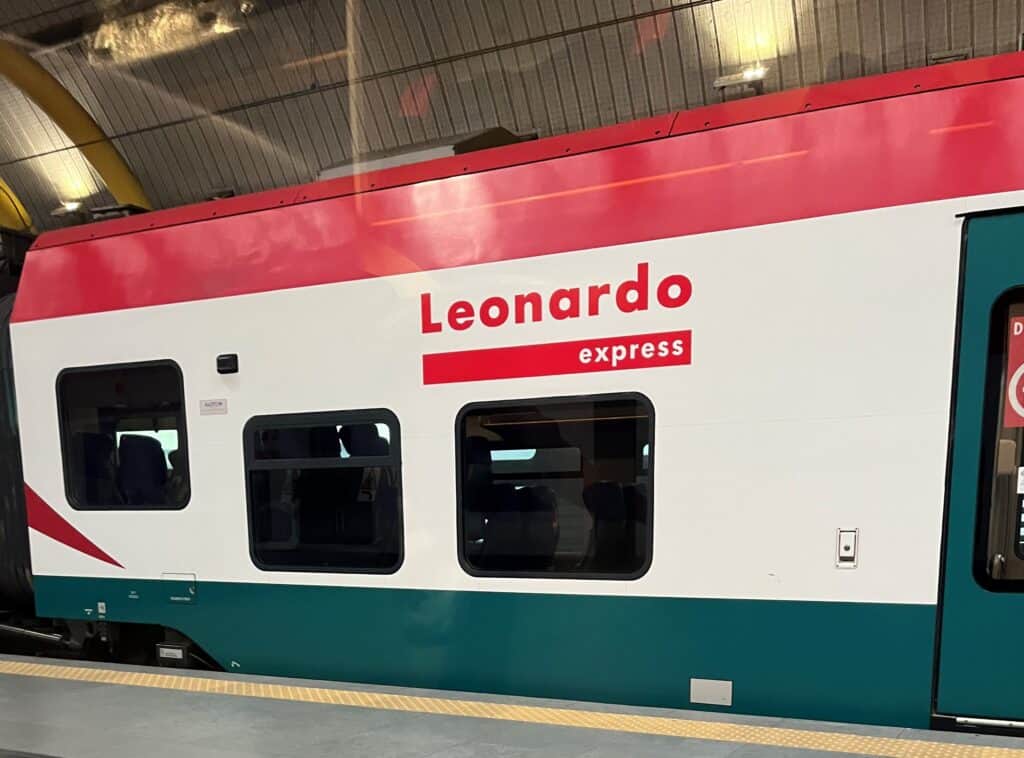
The train system in Rome only really leads out of Rome. As a city, there are no trains for within the city. So although convenient for getting in and out of Rome, if you are staying in Rome for your trip, you won’t be using the trains too much.
And it wasn’t overly crowded either, I visited Rome in December which is actually a pretty busy month for Rome, but the trains were so frequent from the airport that they weren’t overcrowded.
Getting Around Rome: Metro (subway)
The metro (below-ground trains) in Rome is average at best. There are few lines, but they do cover some of the main tourist attractions. For example, there is a metro station right outside the Colosseum.
As with the bus, you need to pre-pay and cannot pay while on the metro. However, I would not suggest taking the metro in Rome. Buses are more convenient and easier to navigate.

You can find a map of the metro lines in Rome by clicking here , along with further information about the metro.
Getting Around Rome: Tram
Unlike the metro, the trams in Rome don’t go through the heart of the city , meaning many of the main attractions are not reachable by tram. Again, I would not suggest getting the tram in Rome.
However, it is an option and if you do choose to use the tram, you will once again need to pre-buy your ticket. The tram mainly runs through the outskirts of Rome so you may find it useful if you are going beyond the touristy centre of Rome.

You can find out more information about Rome’s tram lines by clicking here . It has a map of the tram lines for the city too.
Getting Around Rome: Taxi
Taxis in Rome are convenient in the sense that they can take you directly from A to B. However, they are extremely expensive . A 15-minute journey is going to cost €15, for example.
I didn’t find Rome overly expensive , but one thing which was expensive was the taxis. Even using Uber, I found them to be pretty pricey.
The traffic in Rome is also extremely heavy , it’s a very busy city. There were plenty of occasions where a 10-minute drive was possible in a 12-minute walk; I know which I would rather choose.
However, if you choose to get a taxi, ensure you get in an official taxi , as their fares will be regulated. You can also get a taxi very easily, there are many taxi bays throughout the city, particularly at the main attractions. It is also possible to wave one down on the street.

Getting Around Rome: Car Rental
Car Rental in Rome is another option, it is as convenient as taxis in the sense of you can go from wherever you want to wherever you want.
The only issue is you will need to find somewhere to park the car while you are seeing the attractions. In other words, where will you leave the car when you take a tour of the Colosseum as there isn’t a designated car park.
It’s also worth noting again that the traffic in Rome is bad. However, if you do choose to rent a car in Rome, I highly recommend Discover Cars . They are very reliable and allow you to pick up a car straight away at the airport.
➡️ Rent a car in Rome through Discover Cars by clicking here . You can pick your car up at the airport! Hire a car now .

Getting Around Rome: Private Transfer
Another option for how to get around Rome is a private transfer. Although this only really works for to and from the airports.
Private transfers are like taxis but more luxurious and VIP-like, and therefore are more expensive.
That being said, it can work out cheaper if you have a big group . Nonetheless, you won’t be using a private transfer while getting about Rome, unless you hire a driver.
➡️ Book your private transfer from Rome Fiumicino to City Centre by clicking here . A great option for families and friend groups. Book now .

Getting Around Rome: Bicycle
Cycling is a great way to get around Rome. In my opinion, it would be second behind walking.
It’s cheap and allows you to go anywhere you want. It’s like walking but faster .
If you do cycle in Rome, be aware of cars. The roads in Rome are pretty hectic and the locals drive dangerously, to say the least, so make sure to take care! It’s the only thing about Rome I found unsafe .
Aside from this, bikes are an excellent option for getting around Rome. I wish I rented one while in Rome.
➡️Hire a bicycle (or eBike) by clicking here . Bikes are a great way to avoid traffic and get around Rome quickly. Rent now .

Getting Around Rome: Electric Scooter
The newest and most modern way of getting around Rome comes in the form of electric scooters. These can be found on the side of roads all across Rome, and many other cities all around the world.
Numerous companies rent electric scooters in Rome. You simply download the app and rent the scooter and you can ride wherever you want. Not only is it efficient, but it’s also pretty fun!

You can rent a scooter through a company called Lime , it’s owned by Uber. I’ve used them all across Europe and I’ve found them to be pretty reliable and affordable.
How To Get Around Rome: FAQ
Here are some related questions about how to get around Rome, along with my answers.
The best way to get around Rome is by walking. All of the main tourist attractions are within walking distance. It’s also free, compared to having to pay to use the crowded and average public transportation.
Not at all! You can easily walk between the main tourist attractions and the most you will walk at one time will be 30 minutes.
Definitely yes. Rome is without a doubt a walkable city. You can easily and quickly walk between the main attractions. For example, the Colosseum to Trevi Fountain is approximately a 20-minute walk.
Yes, in fact, the best way to get around Rome is by walking. Everything in Rome is close together, it is quite a compact city. You can easily walk between the main tourist spots.
The best way to get around Rome is by walking, even at night. Rome is also very safe, so walking at night is as safe as walking during the day.
Rome is incredibly easy to get around. The best way to get about is by walking, but if you do choose to use public transport, buses are available that stop near the main attractions.
How To Get Around Rome: Conclusion
And there you have it, a complete overview of how to get around Rome.
Remember, in my opinion , the best way is to walk . Everything is pretty close together so walking is definitely convenient, and of course, it’s also free!
Rome is a beautiful city to explore. So walking allows you to discover hidden gems in the city.
Enjoy your trip to Rome, it’s a magical place. Now that you know how to get around the city, it’s time to start planning what to do. I recommend starting with choosing which Colosseum tour to take – there are a lot of options!
Josh Band is the founder of A Backpacker's World. He is a full-time traveller currently on a mission to visit every country in the world. As a full-time traveller, Josh knows exactly how to make the most of any trip and shares these tips with his readers. Josh mostly travels as a backpacker on a budget, so he is also an expert when it comes to getting the most of your money while travelling.
Advertiser Disclosure
Many of the credit card offers that appear on this site are from credit card companies from which we receive financial compensation. This compensation may impact how and where products appear on this site (including, for example, the order in which they appear). However, the credit card information that we publish has been written and evaluated by experts who know these products inside out. We only recommend products we either use ourselves or endorse. This site does not include all credit card companies or all available credit card offers that are on the market. See our advertising policy here where we list advertisers that we work with, and how we make money. You can also review our credit card rating methodology .

The Ultimate Travel Guide to Rome – Best Things To Do, See & Enjoy!
Amar Hussain
Senior Content Contributor
777 Published Articles
Countries Visited: 63 U.S. States Visited: 9
Keri Stooksbury
Editor-in-Chief
32 Published Articles 3126 Edited Articles
Countries Visited: 47 U.S. States Visited: 28
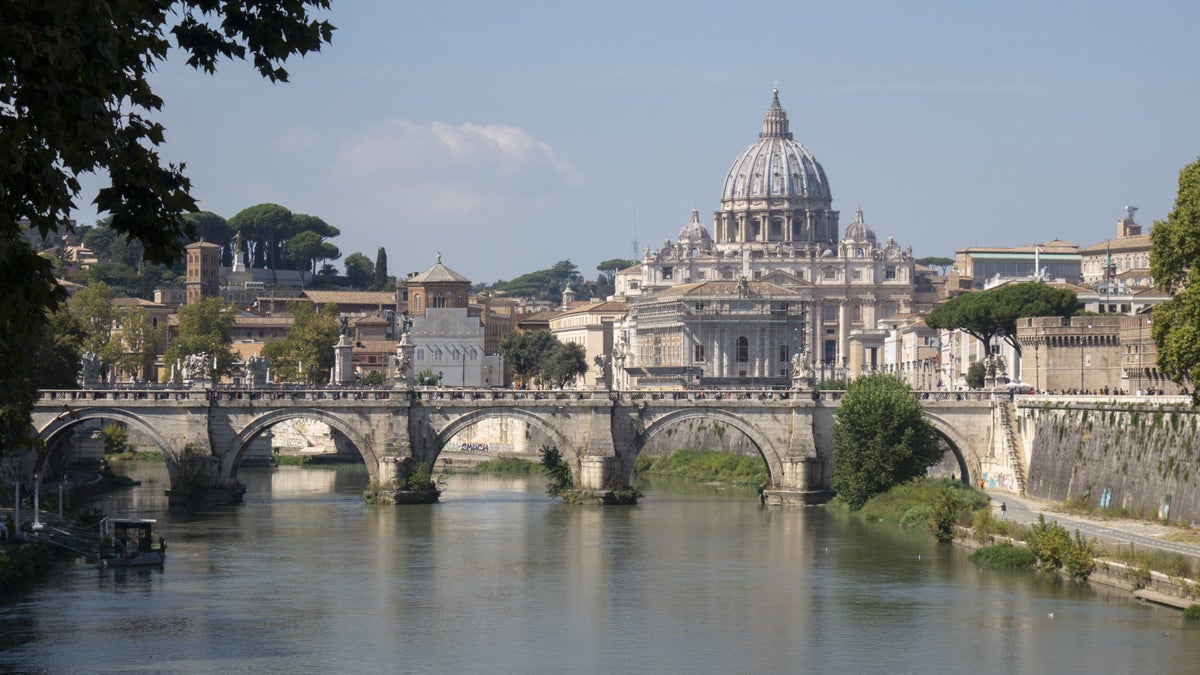
A Brief History of Rome
Fact file , getting around rome, san giovanni, centro storico, san lorenzo.
- Roman Forum
St. Peter’ s Square and Basilica
The pantheon, the spanish steps.
- Trevi Fountain
The Vatican and Sistine Chapel
Piazza navona, galleria borghese, castel sant’ angelo, pyramid of cestius, street art in ostiense, house of owls, largo di torre argentina, teatro marcello, capuchin crypt, the appian way, circo maximus, vintage fiat 500 tour, villa borghese, villa doria pamphili, botanical garden, vatican garden, orange trees garden, villa torlonia, parco degli acquedotti, palazzo venezia, villa celimontana, rose garden, basilica of santa maria del popolo, santa maria in trastevere, basilica of santa maria maggiore, santa maria in aracoeli, san giovanni in laterano, santa maria sopra minerva, basilica di san pietro in vincoli, santa maria in cosmedin, san clemente, saint paolo fuori le mura basilica, via condotti, via del corso, via cola di rienzo, porta portese, via del babuino, v ia del governo vecchio, flaminio market, fontanella borghese market, 15 rome travel tips & hacks, romulus and remus, the trevi fountain, you can drink the water, there are lots and lots of fountains, no cappuccino after 11:00 a.m., the aventine keyhole, secret passageway to the vatican, there are a lot of cats that live here, shop ‘til you drop, the pasta museum.
- Ostia Antica
Hadrian’s Villa in Tivoli
Beware of pickpockets, keep your valuables out of sight, avoid some areas at night, keep electronic copies of your documents, know who to call in an emergency, don’t look too much like a tourist, take advantage of the hotel safe, final thoughts.
We may be compensated when you click on product links, such as credit cards, from one or more of our advertising partners. Terms apply to the offers below. See our Advertising Policy for more about our partners, how we make money, and our rating methodology. Opinions and recommendations are ours alone.
The capital city of Italy is one of the most romantic and historic places in the world. Rome has a lot for you to explore and discover with its plethora of cobbled streets, beautiful architecture, Ancient ruins, and relics dating back over 2000 years.
Rome is packed with cultural experiences around every corner and is the home to some of the most awe-inspiring historical artwork in the world, including Michelangelo’s masterpieces in the Sistine Chapel. Affectionately known as the Eternal City, Rome is situated within the 7 hills on the banks of the Tiber River.
Many visitors return to Rome time and time again as there is more to do than you could fit in 1 trip. When it comes to downtime, you’ll be spoiled for choice with quaint restaurants and cafes serving delicious traditional Italian food and high-quality wines. If you want to dance the night away, Rome has a truly Mediterranean party scene that will suit all tastes.
Legend has it that the city was founded by twin brothers Romulus and Remus in 753 B.C. Raised by a she-wolf, the brothers fought over who should be ruler, and Romulus eventually killed Remus and named the city after himself. In the centuries that followed, Roman civilization shifted from a monarchy to a republic and then an empire.
The very first headquarters of the Roman Empire was based in the city of Rome itself, and the Roman Catholic Church was also founded here. Julius Caesar, the famous dictator of the Roman Empire, became Rome’s first emperor (in everything but name) and one of the city’s most historically important residents.
It is not just Italy that has felt the powerful force of Rome either, as the city has at times ruled over other countries such as Greece, and during the reign of Napoleon, it was officially part of France. Rome became the capital of the newly reclaimed Italian Republic in 1870 and is today considered to have been one of the most influential cities in history.
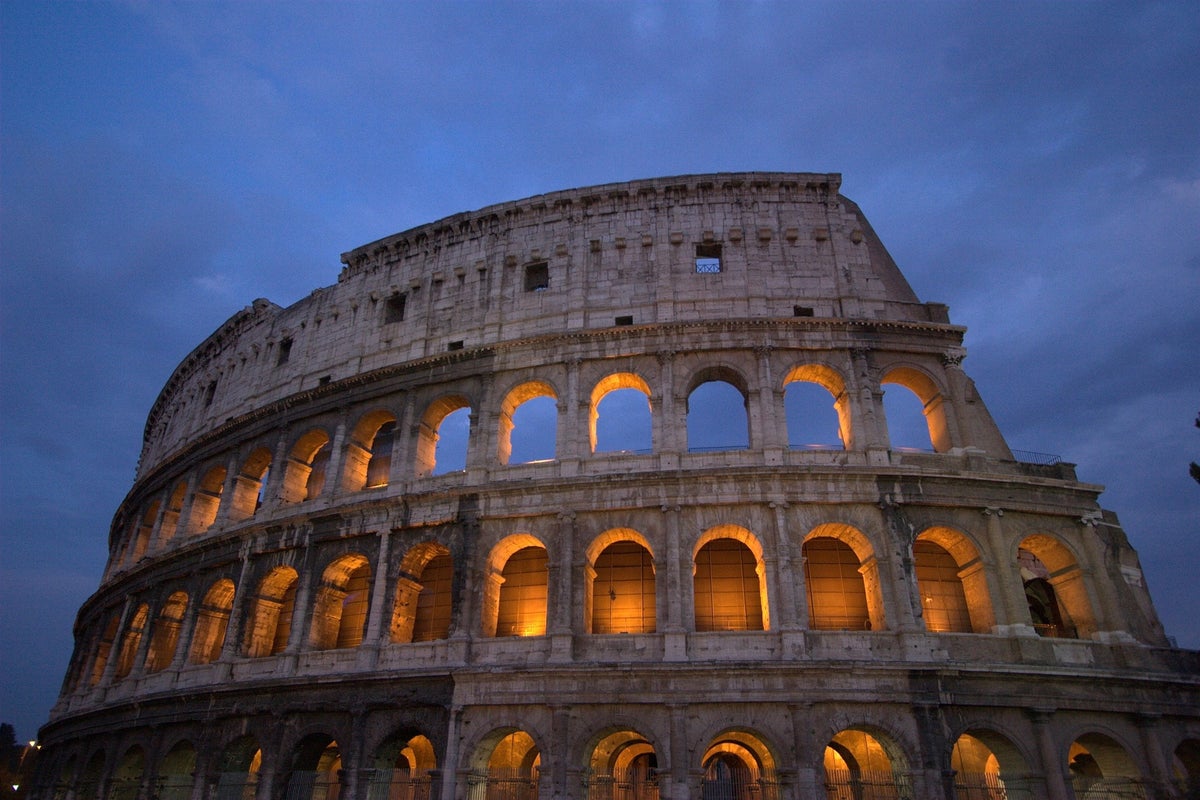
Rome has been the capital city of Italy since 1870 and is located within the center of the Italian Peninsula. Rome is around 15 miles inland from the Tyrrhenian Sea and sits along the Tiber River.
Population : 2.7 million
Population Density : 2.1 per km²
Area : 1285 km²
Official language : Italian
Rome has residents originating from many other countries, so a diverse range of other languages can be heard in the city including French, Greek, German, Sardinian, Albanian, Croatian, and Slovene.
Religion : The main religions in Rome are Roman Catholic and Christianity.
Current President : Sergio Mattarella
Patron Saints : Saint Peter and Saint Paul
Weather : Mediterranean climate with warm, dry summers (peak temperatures in August are around 82°F/27°C) and cold, humid winters (average of 37°F/3°C in January).
Time Zone : CEST + 2hrs UTC (Central European Summer Time)
Currency : Euro
Country Dialing Prefix Code : +39
Emergency Numbers : 113 for Police, 115 for Fire Department, 118 for Medical Emergencies
Green Spaces : Parks and gardens make up 3% of Rome
Churches : There are over 900 churches in Rome!
Getting There and Getting Around
Rome has 2 airports, Leonardo da Vinci Airport (FCO) and Ciampino Airport (CIA).
Leonardo da Vinci Airport, also known as Fiumicino Airport , handles mostly scheduled flights and is connected to the city via a direct train service, The Leonardo Express train. This train is a non-stop service which takes approximately 30 minutes from Fiumicino Airport into the central station in the city, Rome Termini, and costs around $16 (€14).
Alternatively, you can get a shuttle bus service from Fiumicino Airport into Rome’s city center. These buses take on average 1 hour and tickets are available from $8 (€7). If you prefer to travel by private taxi, they are available outside Fiumicino Airport and charge approximately $49 (€44) to take you the half-hour journey into the center of Rome.
Hot Tip: See our in-depth guide on the best ways to fly to Italy, using points and miles.
Ciampino Airport mainly receives chartered flights and those from the budget European airlines. To get from Ciampino airport to Rome’s city center, you can get a bus into Ciampino town center and then a regional train to Rome. In total this would only cost you around $3 (€2.50).
Alternatively, you can get the SITBus Shuttle service, which is a direct route from $6 (€5). Ciampino Airport is only 9 miles from Rome city center, and taxis are waiting outside the airport to take you privately for around $28 (€25).
Once you are in Rome itself, your best travel options are to walk, use the ATAC buses, or the Metro.
Many visitors choose to travel around the city on foot so that they can appreciate everything on offer. Many of the winding streets are cobbled, though, so be sure to pack proper shoes if you are planning to head from 1 attraction to another.
The bus service in the city is very reliable and offers excellent value for money with stops at almost all the major points of interest. There are also night bus services which will run to 5 a.m. The average single bus journey costs around $2 (€1.50) and bus tickets can easily be purchased from any Metro station, newsstand, and many convenience stores.
If you are planning to take several bus journeys during your stay, then you may wish to purchase a travel card which will save you money. There are also 3-day, weekly, or monthly tourist cards on sale for this bus network.
The metro is a useful way for tourists to travel around the city as it is predominately set up for commuters to travel in and out of the city. The metro system crosses the city in a big ‘X’ and has stops near most of the main attractions. From Termini, you can travel to some of the main attractions with train stations, such as the Colosseum, Piazza Barberini, and the Spanish Steps.
The metro runs from 5:30 a.m. to 11.30 p.m. and tickets can be purchased from metro stations, newsstands, or convenience stores. You will be able to save money by purchasing a travel card if you are planning to travel by train for more than a couple of journeys.
Although private taxis are available to take you around the city center, these are not very popular with tourists as they are notorious for over-charging. If you plan to take a taxi, then it is advisable to discuss the cost of the fare with the driver before getting into the cab.
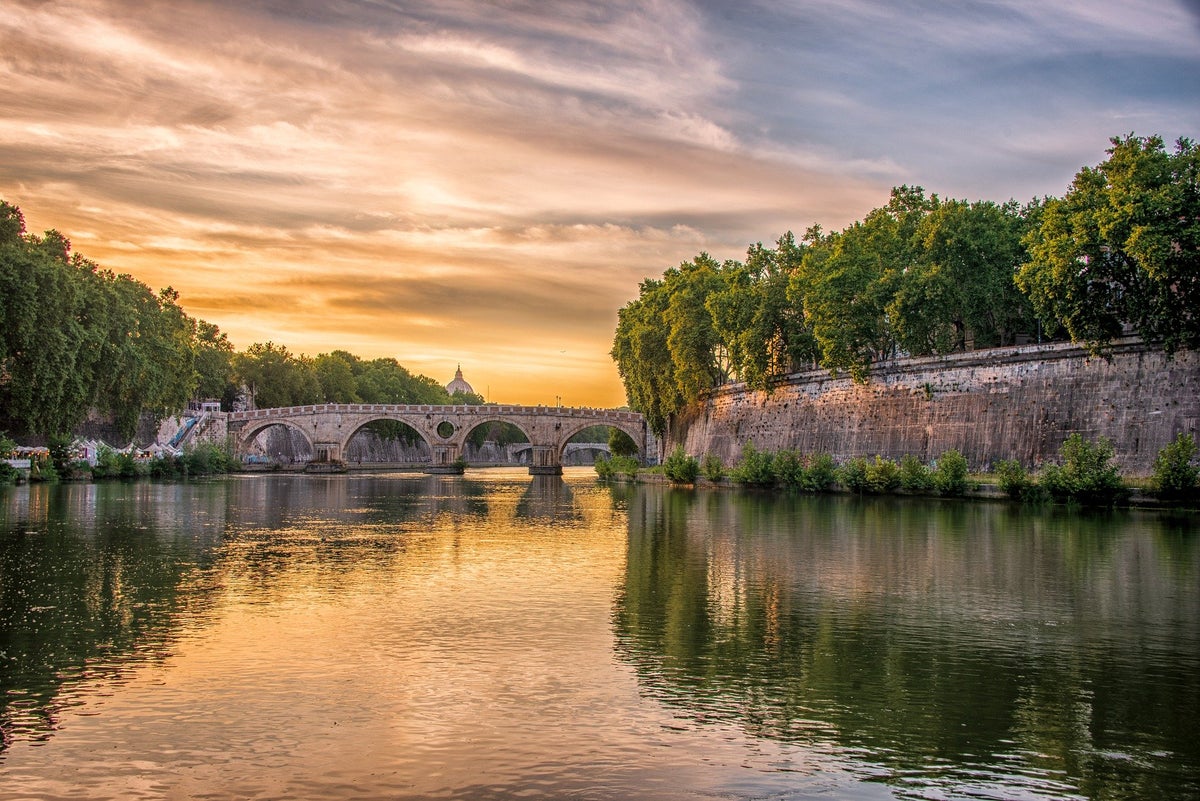
Top 10 Neighborhoods to Visit in Rome
Rome is a city that is spread across 22 different districts (known as “rioni”) and made up of 35 urban quarters (known as “quartieri urbani”), each with a diverse community atmosphere.
Some are set just within the walls of the city and some just outside. The following is an outline of these 10 areas — some are well known on the traditional tourist routes, and others are more up and coming.
Sitting just across from the Tiber River is the area known as Trastevere (which means “across the Tevere”). This area has a trendy, student vibe with an array of restaurants, trendy shops, and lively bars. From Trastevere, you can access river walkways to the historic center that meet and cross at Ponte Sisto and Ponte Garibaldi.
The historic center has a main square which is home to Piazza di Santa, one of the oldest churches in Rome. Trastevere as an area is situated at the bottom of Gianicolo Hill (also known as Janiculum Hill), and from here you can take spectacular walks and hikes until you eventually reach Rome’s largest park, Villa Pamphili.
Hot Tip: Along the way, you can see the 17 th -century marble fountain Fontana dell’Acqua Paola, as well as breath-taking views of the Capitoline and Palatine hills, the imposing Vittorio Emmanuele II monument, and Pantheon’s dome.
San Giovanni is overflowing with beautiful Renaissance buildings and elaborately decorated cathedrals. Unlike other areas of Rome which have the cobbled streets and narrow winding pathways, San Giovanni is made up of modern avenues and is home to many of Rome’s residents.
Although there are local restaurants, the majority of food is sold via community markets, and people sit in the parks for entertainment rather than bars. San Giovanni has brilliant public transport links and is also within walking distance of the Colosseum.
In this quiet, residential area of Rome stands the city’s oldest major Christian basilica, intertwined with modern high street shops and department stores, as well as the popular bimonthly second-hand market.
Despite having a modern vibe, San Giovanni is still a great choice for visitors interested in ancient ruins, cultural city walks, and historic fountains.
Monti gives you a taste of an authentic classic Roman neighborhood. Nestled between the Roman Forum and Basilica of Santa Maria Maggiore, it has a relaxed, lived-in vibe where you can meet the locals and admire the stunning scenery. The beautiful hillside landscape is scattered with pretty historic buildings set in cobblestoned paths and streets.
There is a wide variety of hip restaurants and trendy cafes, and from the southwest side of the neighborhood, you can see across to the Colosseum. Many tourists love visiting Monti where they can sit back and enjoy chilling out around the fountain in the main square known as Piazza della Madonna dei Monti.
Monti was historically an impoverished slum that has evolved to become a picturesque area bursting at the seams with character, attracting young bohemian-type residents and travelers.
Aventino is located on one of Rome’s 7 ancient hills and is a beautiful, green area within the city. Wealthy Roman families own imposing villas in this area, and a wander along the prestigious tree-lined avenues is an experience in itself.
While you are in Aventino, be sure to visit the Bocca della Verita, the chariot track at Circus Maximus, and the historic ruins at the Baths of Caracalla. There are fantastic views of the Tiber River to be had from the hillside of Aventino, and many tourists choose to sit in the orange garden to soak up the stunning vista.
Hot Tip: If you get the chance to visit the Magistral Villa of the Knights of Malta, you will get the opportunity to view St. Peter’s dome from a totally different perspective through the keyhole on the gate.
The streets that make up Centro Storico are some of the most historic parts of Rome where tourists flock to see the Campo de’ Fiori, the Piazza Navona, and the Pantheon. These areas are brimming with the charming narrow streets and ancient architecture that Rome is so famous for. In Centro Storico you will see some spectacular examples of classical Roman- and Baroque-style buildings.
The main square is busy every night and has a plethora of lively restaurants and bars, all of which serve up good quality Italian dishes and fine wines. The famous food and flower market at Campo de’ Fiori is not to be missed and should be on every tourist’s experience list.
Bottom Line: Centro Storico’s location makes this a popular neighborhood, so be prepared for the crowds.
San Lorenzo is situated outside of the city walls and sits between Termini and Tiburtina stations. This area was traditionally a working-class industrial center whose roots remain today with plenty of warehouse buildings and factory-style architecture on every corner.
San Lorenzo has a young, hipster, and student vibe and is close to Sapienza University. As you wander around San Lorenzo you will be able to admire the creative and artistic murals dotted on the side of buildings.
The progressive alternative music scene attracts free-spirited hipsters to the many live music events which take place in the vibrant bars. There are also plenty of opportunities in San Lorenzo to purchase some of the best street food in the city.
Testaccio was historically a slaughterhouse and butchers’ district up until the 1970s. These traditions are still active today, and many tourists enjoy a visit to the Testaccio Market to purchase gourmet street food and fresh meats.
Testaccio is an area is situated along the Tiber River, just south of Aventine Hill. The main attraction in Testaccio is the Pyramide of Cestia, which is the Protestant Cemetery where non-Catholics were buried.
Even though Testaccio is a trip away from Rome’s center, many visitors report that it is well worth the journey. It is considered to be one of the prettiest areas in the city and is within walking distance of the Pirimide metro station and the Colosseum.
Bottom Line: Testaccio is a quaint and quiet area as it is off the tourist path, but has great restaurants and cafes for a relaxing day away from the main drag.
Tridente is in the northern part of central Rome and gets its name from the fact it is made up of 3 main streets. These 3 streets (Via di Ripetta, Via del Corso, and Via del Babuino) all filter off from the Piazza del Popolo. This area is one of the most sophisticated parts of Rome and is home to designer boutiques, fine dining restaurants, and magnificent 5-star hotels.
In Tridente you can visit wonderful attractions such as the Spanish Steps, the Trevi Fountain, and the flagship Fendi store. This area is an iconic and popular destination for tourists and is usually on people’s must-see tick list.
Tridente is a bustling area and one where you can experience the posh, high-end Italian lifestyle during your visit to Rome.
Pigneto is a diverse and artistic area of Rome where many locals live. The former working-class neighborhood on the outskirts of the city is now considered to be a trendy, up and coming area that attracts creative and free-thinking residents and visitors.
There’s a plethora of trendy cafes, ethnically diverse shops, and vibrant bars, as well as an abundance of street art for you to admire as you wander around this unique neighborhood.
Pigneto has a market each morning in Via del Pigneto which is a pedestrian-only street with its own metro station. In this shopping part of Pigneto you have the chance to buy original artwork, street food, and cruelty-free, vegan-friendly clothing.
Bottom Line: Hipsters congregate in this area to enjoy the live music and art scenes which the colorful Pigneto has to offer.
Prati is the Italian word for “meadows” and is a charming, historic area of Rome on the west side of Tiber River. Here you can wander alongside elegant buildings in a quieter and calmer part of Rome. It is here in Prati that you can visit the elaborate Palace of Justice which has an expansive bronze sculpture on the rooftop of a chariot being drawn by 4 beautiful horses.
Other must-see things in Prati are the charming Piazza Cavour and Via Cola di Rienzo, which is one of Rome’s most famous streets for high-end, designer shopping. Prati borders the north of the Vatican State, providing easy access to the Vatican Museum, St. Peter’s Square, Vatican City itself, and Castel Sant’Angelo.
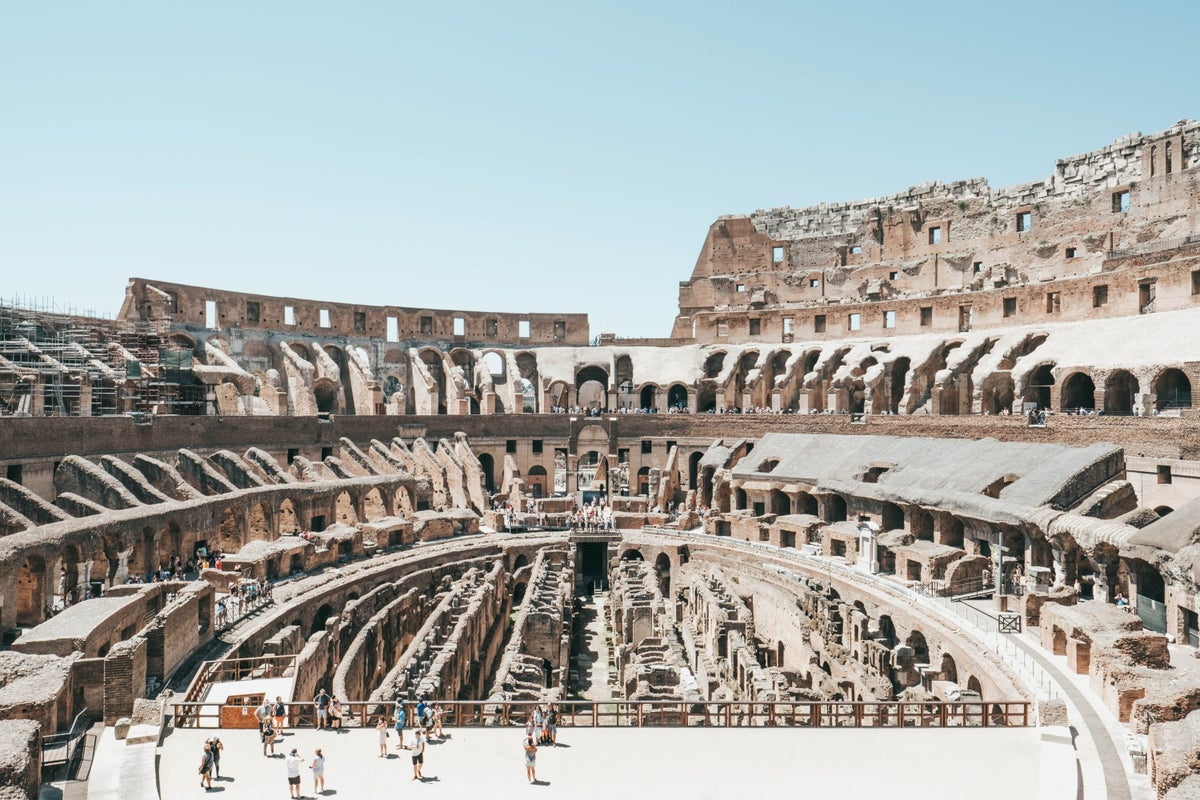
Top 10 Rome Attractions
Here are 10 of the best attractions to visit in Rome.
The Colosseum is usually the top of all tourists’ must-see tick list. It is the largest amphitheater ever built and is situated in the center of Rome. This oval amphitheater is an imposing 157 feet (48 meters) high and is open from 8:30 a.m. – 7:00 p.m. every day. For a standard admission ticket costing $13 (€12), you can walk freely between the Colosseum, the Roman Forum, and Palatine Hill.
The nearest metro station is Colosseo on Line B.
The Roman Forum is the central rectangular space surrounded by the ancient ruins of Rome’s government buildings. This popular tourist attraction is open from 8:30 a.m. – 7:15 p.m. daily, and the admission cost is $13 (€12). However, this is the same ticket as the Colosseum, so if used on the same day, you can access both attractions for 1 ticket price. This is easily achievable as the entrance gate is very close to the Colosseum.
St. Peter’s Basilica is one of the most iconic landmarks in all of Rome. The Italian Renaissance church is situated in an expansive square in Vatican City that dates back to 1506. Tourists can visit St. Peter’s Square and Basilica from 7:00 a.m. – 6:00 p.m. every day except Wednesday. Entrance is free, but if you wish to go to the dome at the top, it’s $11 (€10) by elevator or $9 (€8) on foot.
Take Line A on the metro and San Giovanni station is only a 5-minute walk from St. Peter’s Square.
The Pantheon is now a church but was historically a Roman temple dedicated to all the ancient gods of pagan Rome. Admission to the Pantheon is daily from 8:30 a.m. – 7:30 p.m., except Sundays when the opening times are 9:00 a.m. – 6:00 p.m.
This is a public site that is free to visit and within walking distance of Barberini on Line A of the metro.
The Spanish Steps were initially built to link the Trinità dei Monti church with the Spanish Square beneath in Piazza di Spagna. It is free to visit the Spanish Steps, and it is well worth the climb to view the spectacular church at the top.
You can use Line A of the metro and get off at Spagna station close to Trinità dei Monti church. From there you can take the steps down to the Spanish Square.
The Trevi Fountain is possibly one of the most famous fountains in the world. It is Rome’s largest Baroque fountain, and legend has it that you throw 1 coin into the fountain to ensure another trip to Rome, 2 coins for love, and 3 coins for wedding bells. It is free to visit Trevi Fountain, and it only a 10-minute walk to the Spanish Steps if you are looking to combine sightseeing experiences.
Alternatively, the nearest metro station is Barberini.
The Sistine Chapel in Vatican City is the official residence of the Pope and is a must-see for all tourists when they are in Rome. The chapel dates back to 1473 and hosts the amazing artwork of Michelangelo on the ceiling. The opening hours are 9:00 a.m. – 4:00 p.m. every day except Sundays when the chapel is closed and is only around 5 minutes’ walk from Spagna metro station.
It costs $16 (€14) to enter and visitors should allow 3-4 hours to wander around the rooms.
Piazza Navona is a square that was first built in the 1 st century A.D. and is considered to be one of the largest and most beautiful piazzas in Rome. This is a very popular free tourist attraction with 3 stunning fountains, including la Fontana dei Quattro Fiumi and its imposing central obelisk.
The nearest metro station is Spagna which is just a 5-minute walk away from Piazza Navona.
Galleria Borghese is a famous art gallery which is open between 9:00 a.m. and 7:00 p.m. every day except Mondays and costs $14 (€13) for a ticket. During your visit to Galleria Borghese, you will be able to see beautifully preserved sculptures, ancient mosaics, and paintings that date back to the 15 th -18 th centuries. The museum is set within the Villa Galleria gardens which are free to enter.
The easiest way to travel to Galleria Borghese is by bus which stops within walking distance.
Castel Sant’Angelo was originally built as a mausoleum for the Roman Emperor Hadrian and his family in 135 A.D. It has since been used as a fortress and castle by different popes over the years, but nowadays it is open as a museum. You can visit this amazing example of Ancient Roman architecture every day between 9:00 a.m. and 7:30 p.m., and admission costs $16 (€14).
The easiest public transport for this attraction is a bus from the main center of Rome or metro Line A to Lepanto.
Hot Tip: Looking for more tour and tour information? Explore our guide to the best tours in Rome .
10 Unique and Quirky Things to Do in Rome
Outside of the usual tourist attractions, there are some unique things to see and do. Here are 10 to add to your list.
The Pyramid of Cestius was built in 12 B.C. as a tomb for Gaius Cestius. This pyramid was sealed when built but has since had one of the entrances plundered. The Pyramid of Cestius is open to the public on Saturdays between 10 a.m. and 12 p.m. and only costs $6 (€5.50) to go inside.
The nearest station is Piramide, which is only a 2 minutes stroll from the pyramid — the only attraction of its kind in Rome.
The Ostiense district of Rome is located just to the south of the city center. Here you can view some impressively creative street art across a plethora of urban contemporary artwork and spectacular murals. There are lots to see so allow plenty of time when visiting Ostiense if you want to stroll and appreciate the street art in this area.
The easiest way to travel to Ostiense is by metro and walk from Piramide station.
The Little House of Owls is a quirky museum that some visitors describe as the hidden gem of Rome. Nestled within the ground of Villa Torlonia is this little fairy-tale looking house dedicated to owls. The house is away from the usual touristy sightseeing lists but is well worth the entrance fee of $13 (€12).
The Little House of Owls, also known as Casina delle Civette, is open between 9:00 a.m. and 7:00 p.m. every day except Mondays, and can easily be reached by bus from the city center.
Largo di Torre Argentina is a square which includes 4 Roman Republican temples as well as the famous ruins of Pompey’s Theatre. The excavation work is ongoing and is an inspiring discovery since the 20 th century. It is within Pompey’s Theatre in this square where Julius Caesar was thought to have been assassinated.
This is a public site that is free to visit. Although you can’t directly access the ruins, you can closely view them from the street. There is no metro station nearby, but this attraction is within walking distance of bus stops which run from all main areas.
These ancient underground burial places , or catacombs, can be viewed for only $9 (€8) and there are around 40 catacombs to experience. Some of them were only discovered a few decades ago. Ancient Roman law stated that the dead must be buried outside the walls of the city and these catacombs were built so that Christians could be buried as Christian symbols could be used underground.
The nearest station to the Catacombs is Appia Pignatelli.
Teatro Marcello is a stunning open-air theater which was built in 13 B.C. for Julius Caesar and Marcus Marcellus. In the summer, concerts are held within the ancient theater, and it is a truly magnificent setting which many visitors report to find as breathtaking as the Colosseum.
Ticket prices vary depending on the concerts being held. It is free to walk the perimeter of Teatro Marcello to experience the historic Roman site, which is 85 years older than the Colosseum.
This theater is only a 1-minute walk from Teatro station.
The Capuchin Crypt is a collection of tiny chapels that sit beneath the Santa Maria della Concesione dei Cappuccini church. Here is where the bodies of Capuchin monks were buried, and their skeletal remains are still held. The Capuchin Crypt is open every day between 9:00 a.m. and 6:30 p.m. and the admission fee is about $9 (€8.50).
The nearest station for visiting this attraction is Barberini.
The Appian Way is a historic Roman road built in 312 B.C. Today this is one of the most famous ancient Roman roads where you can walk or cycle (bike hire is available at the site). On average, tourists spend around 6 hours traveling the length of the Appian Way and generally find it to be a peaceful experience just outside the city walls.
It is easy to travel to the Appian Way by bus from Piramide station.
Circo Maximus is an ancient chariot-racing stadium which would have been a major entertainment venue in its day. Situated between Aventine and Palatine Hills, this attraction is becoming ever more popular with tourists visiting Rome.
The remains of this inspiring Ancient Roman architecture form the archaeological site which stands today after fire and flood damage. Circo Maximus is open every day except Mondays and pre-booking is essential as it is for organized tour groups only.
Use Line B of the metro and get off at Piramide station for this attraction.
This is a fantastic way to tour around the historic sites of Rome! These vintage Fiat 500 cars set off in convoy, and you will spend 3 hours driving around Rome. You’ll travel where some larger tour buses cannot access and cruise along the Tiber River. For just $142 (€128) you can be seated inside one of these iconic open-top vintage cars. Tours start from just outside the Colosseum.
Hot Tip: Need a great place to stay? Check out these 15 great hotels in Rome.
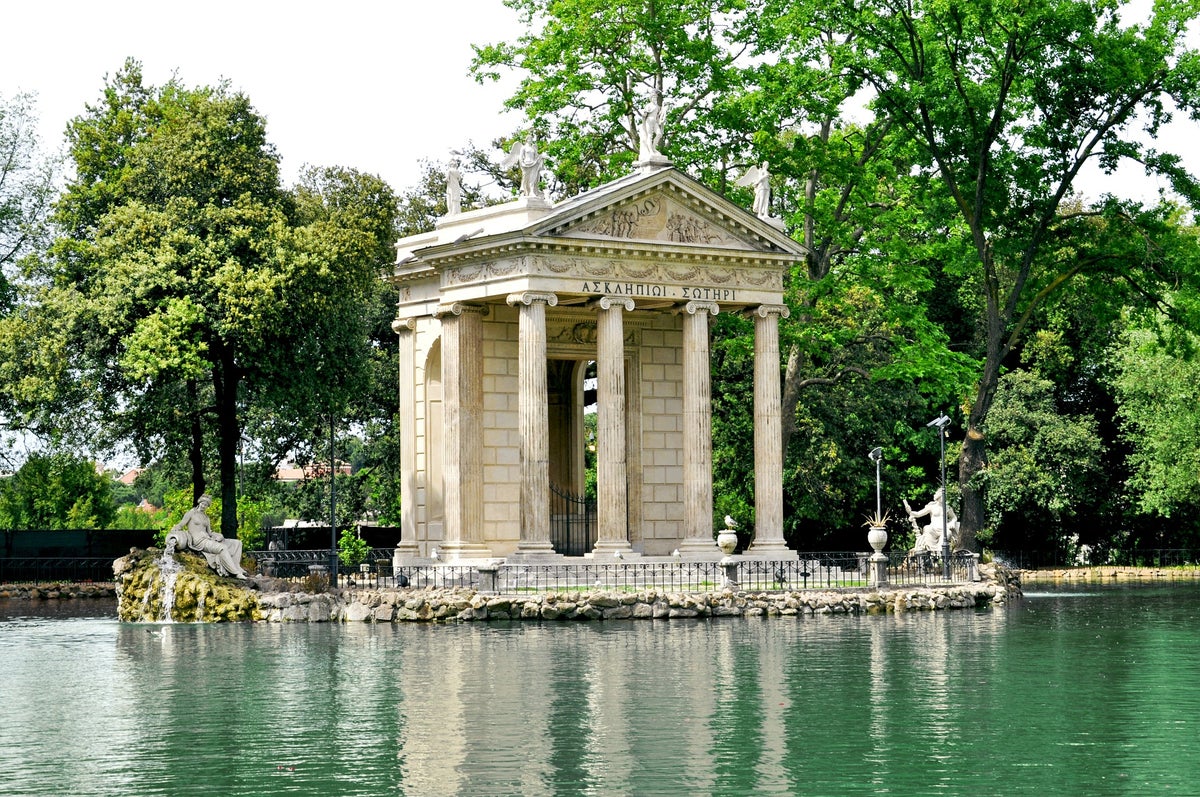
10 Green Spaces and Gardens in Rome
It’s not just about the architecture in Rome. The city is also home to some beautiful green spaces and gardens. Here are 10 of the best.
Villa Borghese is the third largest park area in Rome. It is a landscaped area with English-style manicured gardens. Villa Borghese is open 24 hours a day and is free to explore. This park is situated on Pincian Hill, close to the Spanish Steps, and is known by locals as the “green lung” of Rome. It can be accessed from Spagna or Flaminio stations.
Villa Doria Pamphili is Rome’s largest and most impressive park which was built around a 17 th -century villa, now the sole location for the Italian government. This stunning landscaped park is free to visit and nearby to Termini station. Villa Doria Pamphili is thought to be one of the best places for walking in Rome.
The Botanical Garden, Orto Botanico, is situated in the Trastevere neighborhood. Visitors to these gardens can see over 3,500 species of plants. There is also a rock garden, bamboo grove, “Scent & Touch” visually impaired sensory garden, greenhouses, and the Japanese gardens.
A day spent strolling around Orto Botanico is definitely time well spent. This attraction is open daily from 9:30 a.m. to 6:00 p.m., the admission fee is only $9 (€8), and the nearest metro station is Piramide.
The Gardens of Vatican City are owned by the Pope, and there is public access from 9:00 a.m. – 6:00 p.m. every day except Wednesdays and Sundays. These beautifully manicured gardens can be toured by bus for $36 (€32). This may sound expensive until you realize that the admission ticket also allows you access to the Vatican Museum and Sistine Chapel.
You can take the train to Ottaviano-S. Pietro to access the gardens.
Savello Park, also known as the Orange Trees Garden, is on Aventine Hill, and from this garden, you have the most wonderful views of the city. You can wait in line to peek through the keyhole on the gate of Magistral Villa of the Knights of Malta and view St. Peter’s dome from above. These gated gardens are free to visit and are open from 7:00 a.m. to 6:00 p.m. in winter and 7:00 a.m. to 8:00 p.m. in summer.
Piramide metro station is the closest to the garden gates.
Villa Torlonia and its surrounding grounds are a hidden gem in Rome. You can see magnificent neoclassical architecture set within English-style manicured gardens. Villa Torlonia is open daily from 9:00 a.m. – 7:00 p.m. and admission tickets cost $11 (€10).
Guidubaldo Del Monte is the nearest station to the park.
Parco degli Acquedotti is a beautiful, expansive park within the Appian Way area on the outskirts of Rome. In this park, you can see the ancient ruins of 2 massive Roman aqueducts. This public park is open 24 hours a day, and entrance is free.
Capannelle is the nearest station.
Formerly the Palace of St. Mark, Palazzo Venezia is a spectacular example of Renaissance architecture. The gardens are pretty and open from 8:30 a.m. – 7:30 p.m. every day except Mondays. Admission is $9 (€8.50) and it’s only a 10-minute walk from Termini station.
The grounds of Villa Celimontana are considered by some visitors to be the prettiest hidden gardens of the city. Stroll through these immaculate gardens, which were once a vineyard, and discover the obelisk dating back to the mid-16 th century. This free public park is located just above the Colosseum and is open from 7:00 a.m. until sunset.
Rome’s Rose Garden was formerly a Jewish cemetery that has been constructed in the shape of a menorah. This public park on Aventine Hill is open to the public from April to June, and there’s no admission fee. Allow plenty of time when visiting these gardens as there’s a huge area to cover.
The gardens are just a short walk from Termini station.
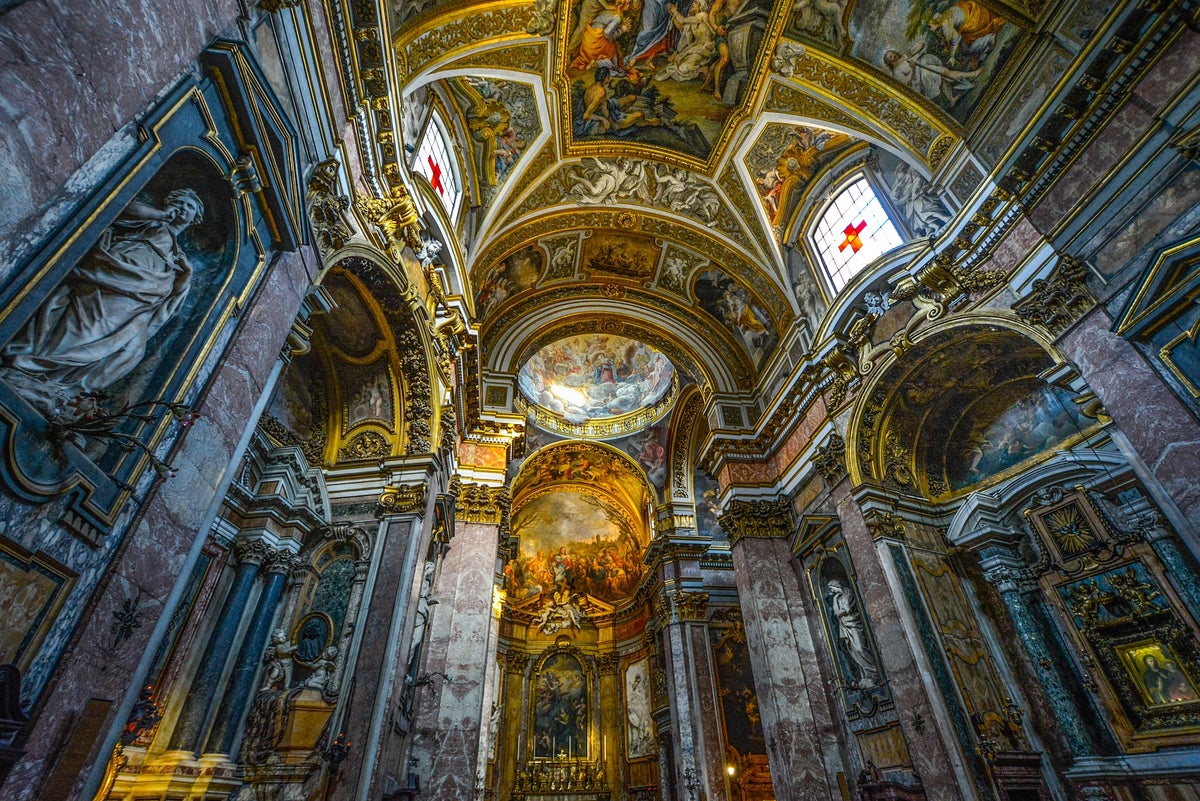
10 Churches You Should Visit in Rome
Rome is home to over 900 churches, so it is a challenge to choose a top 10. Nevertheless, we gave it a go and here are our top picks.
Basilica of Santa Maria del Popolo is a 15 th -century church which sits within Rome’s famous square Piazza del Popolo. Visitors report that this tiny temple is unlike any other church in Rome, with its delightful Renaissance decoration inside. Basilica of Santa Maria del Popolo is open every morning from 7:15 a.m. – 12:30 p.m., then every afternoon from 4:00 p.m. – 7:00 p.m.
The nearest station to the Basilica of Santa Maria del Popolo is Civitavecchia.
Santa Maria in Trastevere (Our Lady of Trastevere) is one of the oldest churches in Rome. There are beautiful mosaics on the exterior, and it is a dazzling sight to behold at night when the tower is illuminated. The church is open to the public from 7:30 a.m. to 9:00 p.m. daily and admission is free.
Santa Maria in Trastevere is only a few minutes’ walk from Mameli station.
Basilica of Santa Maria Maggiore is the largest Catholic Marian church in Rome dedicated to the Virgin Mary. It is breathtaking with a 15 th -century wooden ceiling, a hidden spiral staircase, gorgeous mosaics, and a display of part of Jesus’ crib brought from Bethlehem. It’s open from 7:00 a.m. – 7:00 p.m. daily except Sundays and bank holidays when it is closed in the afternoon.
Basilica of Santa Maria Maggiore is only a short walk from Termini station and admission is free.
Santa Maria in Aracoeli was built in the 6 th century and is still today the designated church of Rome’s city council. It’s a popular church, particularly at Christmas, as inside there is a wooden baby Jesus which is thought to have healing powers. The entrance is free, and the church is open from 7:00 a.m. – 7:00 p.m. daily.
Ara Coeli station is less than 3 minutes’ walk away.
San Giovanni in Laterano is open to the public from 7:00 a.m. – 6:30 p.m. daily. This impressive monumental church was the most influential building within the Christian faith for over a thousand years. Visitors always report that they are amazed by the rich history, art, and architecture of this church.
Use Lines A and C of Rome’s metro for the nearest station, San Giovanni.
Santa Maria Sopra Minerva is a popular church for tourists to visit to take in the heady blend of Gothic and Medieval architecture. It is still one of the major churches in Rome’s Catholic Order of Preachers and this 13 th -century attraction is open from 7:30 a.m. to 7:00 p.m. daily with free admission.
Santa Maria Sopra Minerva is a 20-minute walk from Termini and around the corner from the Pantheon.
Basilica di San Pietro in Vincoli is a Renaissance-style church and basilica that is famous for being home to Michelangelo’s statue of Moses. This Roman Catholic church is open in the mornings from 8:00 a.m. – 12:30 p.m., and then in the afternoons from 3:00 p.m. – 7:00 p.m.
Entrance is free, and this is only a short walk from the Colosseum for tourists wishing to combine experiences.
Santa Maria in Cosmedin is a minor basilica built in the Middle Ages which attracts visitors wanting to see the “mouth of truth” inside the porch. There is also plenty of medieval art to admire throughout the church. The church is open from 9:30 a.m. to 6:00 p.m. daily.
Bocca Della Verita’ station is only 1 minute away and admission is free.
San Clemente is a minor basilica dedicated to Pope Clemente I. This church is considered significant among religious scholars as it outlines the history of Christianity right from the beginning of the faith through to the Middle Ages. This temple is decorated internally with old mosaics and is open to the public from 9:00 a.m. – 12:30 p.m. and then 3:00 p.m. – 6:00 pm.
The church is a short walk from either Colosseo or Manzoni stations.
Saint Paolo Fuori le Mura Basilica is one of Rome’s 4 major basilicas and is located outside the city walls. This 9 th -century church with Neoclassical architecture is a popular year-round tourist attraction. Saint Paolo Fuori le Mura Basilica is open daily from 7:00 a.m. – 6:30 p.m.
Saint Paolo Fuori le Mura Basilica is easily reached via the bus network service.
10 Shopping Areas & Markets in Rome
Rome is a fashionista’s dream, but it’s not all high-end fashion. The city is home to some great markets, too. Here are 10 of the best places to shop.
Packed full of beautiful designer big name brands including Gucci, Dior, and Dolce & Gabbana, Via Condotti is the place to be for the largest selection of designer outlet shopping in all of Rome. It is an absolute must for lovers of designer Italian leather handbags and upscale fashion and accessories. The pedestrian walkway is also dotted with cafes and restaurants for regular shopping breaks.
This retail heaven can be found close to the Spagna metro station.
As one of the most popular shopping spots in the city of Rome, the Via del Corso is home to designer dresses and big brand fashion. Offering affordable fashion at its finest, you will find some of the most highly regarded names in Europe here including H&M, Zara, and Sephora.
You can easily walk to Via del Corso from the Spagna Metro station, or bus lines 170 and 175 both stop close by.
The Via Cola di Rienzo is the main thoroughfare that cuts through Rome’s Prati neighborhood. It is also one of the very best destinations in the city for laid-back, leisurely shopping with fewer crowds than some of the more upmarket areas. The Via Cola di Rienzo offers an impressive blend of international brands like Coin, Tiffany’s, Kiko, and Diesel, as well as a wide variety of bars, cafes, and restaurants.
Close to the Cola Di Rienzo/Terenzio subway stations, the Via Cola di Rienzo is a great place to explore after visiting the Vatican.
Porta Portese is the biggest flea market in Rome and is the perfect place to enjoy a lazy Roman Sunday strolling through the ancient streets of the Trastevere district. Cheerful vendors offer a wide selection of secondhand clothing, antiques, brand name knockoffs, bric-a-brac, household products, vinyl records, and much more. The market is just as popular with the locals giving it a truly continental feel.
The nearest station is Porta Portese.
Tucked away behind the city gates close to the cathedral of San Giovanni in Laterano lies this enchanting outdoor market that is perfect for those who are happy to rummage for bargains. Vendors show their wares on old tables and tatty looking stalls, but for those who have the patience to sift through the piles of stock, the rewards can be incredible. Secondhand and vintage designer gear by the bucketload is here — you just need to find it first.
Surrounded by super cool cafes and record shops, the nearest subway is San Giovanni.
Via del Babuino is a historic cobbled street that connects Piazza di Spagna and Piazza del Popolo. Chock full of beautiful old buildings, it is also one of the city’s premier upmarket shopping districts. This elegant pedestrianized thoroughfare is dotted with luxury brands including the likes of Armani Jeans, Tiffany, Tory Burch, Gente, Maison Margiela, and Valentino.
This is a great place to have a latte while enjoying a spot of people-watching; the nearest station is Spagna.
Via Giulia has some of the city’s finest examples of authentic Roman architecture and is an utterly enchanting place to spend the day. Via Giulia is also a residential area for rich Romans, meaning that there are plenty of fantastic independent shops that line the cobbled street. These include art galleries, antique shops, and quirky homeware stores, as well as fashion boutiques, bars, and cafes.
You can reach this part of town using the Circo Massimo station.
Just off the Piazza Navona, the Via del Governo Vecchio offers something for everyone. From the super cute secondhand book stores and biggest vintage clothes shops in the city to the modern-day fashion boutiques and grocery stores, this a popular part of town with a great atmosphere. Take a stroll along the cobbled street until something takes your fancy, then sit back and relax in one of the many coffee shops and bars.
The nearest subway station is Chiesa Nuova.
Set at the heart of the Piazza del Popolo, Flaminio Market is packed full of cool market traders selling pre-owned and vintage clothing, accessories, and jewelry. This is one of those flea markets similar to those you find in many European cities, but this being Rome, you are likely to come away with a pair of pre-loved Gucci sunglasses or a Fendi bag.
Set in a bus station, there is an entrance fee of $2 (€1.60), and you can get there using the 88, 204, or 231 buses or trams 2 and 19.
Nestled between the Tiber and the Via del Corso, the Fontanella Borghese Market is a gorgeous piazza market that offers a selection of bijou box shops. These sell a variety of small antiques including antique maps, etchings, posters, books, photographs, and even cameras. The area is always popular with tourists, as the wares on sale are usually just the right size to bring home.
The nearest station to the market is Spagna.
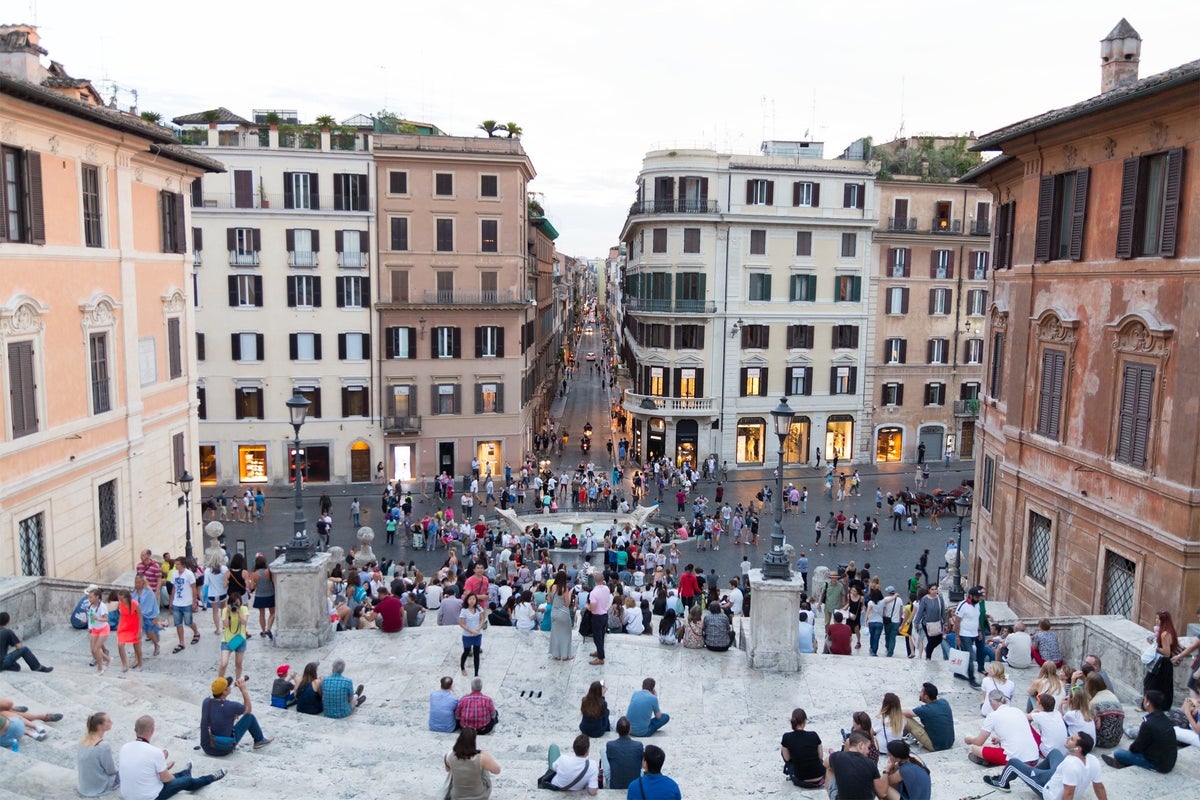
House Wine is the Best Wine
When in Rome, drink like the Romans. In a city that appreciates fine wine, the house bottle or “vino della casa” is often as good as, if not better, than more expensive brands. Buy it by the glass or share a carafe or 2 with friends old and new.
Experience the Culture for Free
On the first Sunday of each month, some of the best museums and archaeological sites can be enjoyed for free. If you are on a tight budget, plan your dates accordingly, and visit world-famous sites like the Colosseum, the Roman Forum, and the Galleria Borghese for free. Read our comprehensive guide to discover some of the best museums in Rome .
Be Travel Savvy With Taxi Drivers
The city of Rome operates and enforces set fees for most taxi journeys to, from, and within the city walls. Taxis registered outside of the city are not bound by the same rules but can travel the same routes. This makes it easy for unsuspected tourists to be stung with huge fares. Always check your taxi fares before you begin your journey.
Imparare a Parlare Italiano (Learn to Speak Italian)
Learning a few key phrases and common words will not only help you in everyday situations, but it will also help to ingratiate you with the locals. Learn a little before you leave, and take a phrasebook with you.
Go C ontinental
Much like the French, the Italians are famous for their love of late-night meal times. 8:00 p.m. is a good starting point for eating your evening meal, but be prepared to enjoy long, laid-back affairs that last well into the small hours.
Travel Light
When wandering around the city, leave your super-size backpack back at the hotel. European cities tend to get very crowded, and most tourist attractions will ask you to check bulky bags in the cloakroom. Keep your money, phone, camera, and other essentials close at hand with a fanny pack , sling backpack , or mini backpack instead.
To Tip or Not to Tip?
Most restaurants in Italy will automatically apply a “service charge” to your bill. If you are in a smaller cafe or independent restaurant, you may like to leave a few euros for your waiter as you leave. The same rules apply to taxi drivers and bartenders, too. Tipping is not necessary, but of course, no one will complain if you do.
Cash is King
Rome is a city with plenty of ancients wonders to see, and in some places, this even extends to your payment options. To avoid being caught out, be sure to carry enough cash on you to pay for your entry tickets to attractions, as well as food, drinks, and any travel while you are away from your hotel.
Look Out for Fake Gelato
Even here in Italy, not all gelato is created equal. Being one of the most refreshing and delicious national dishes you will ever taste, it is important that you find an authentic scoop or 2. The brightly colored, fluffy looking ice cream served across town is often packed with artificial colors and sweeteners.
Real gelato, however, takes its color and flavor from the ingredients within it. As a rule of thumb, compare your frozen treat with how it would appear if the ingredients were blended.
Enjoy a Drink at the Bar
Italians have a unique way of enjoying their coffee, and they see it simply as fuel to keep them going. If you would prefer to sit down and relax with a hot coffee and a good book, you are welcome to by all means, but be prepared to pay extra for the privilege.
Take the Day Off
Monday is considered a day of rest in Rome, and many of the city’s main attractions and restaurants will be closed to the public. When planning your next trip, be sure to make the most of the weekend, and save Monday for shopping or visiting local parks and open spaces.
Drink from the Water Fountains
Usually, when you go overseas, you are advised not to drink the water, but here in Rome, the “nasoni” fountains provide thirsty travelers with fresh drinking water that flows from the aqueducts. Stay hydrated for free by topping up your water bottle as you go.
Avoid the Busiest Times
The Vatican Museums are the most popular in all of Italy, and they get very busy from the moment they open. Ignore the advice of those who tell you to get there early, and instead, wait for the rush to die down before visiting. On a Friday the museums are open late, so why not enjoy a late afternoon or evening tour instead?
Keep Covered Up
In most of the ancient churches and buildings in the city, including St. Peter’s Basilica, the Vatican Museums, and the Sistine Chapel, you will need to be covered up to be allowed entry. Although it can get super hot outside, carry a shawl or scarf with you to cover your knees and shoulders when you need to.
Finally, Bring Your Own Toilet Paper
Roman toilets aren’t great. Often they will be without toilet seats, and toilet paper will be in short supply. Sometimes you will even have to pay for the privilege of using these less than perfect facilities. Keep a stash of toilet paper or wipes in your bag at all times — just in case.
10 Fun Facts About Rome
The Eternal City receives millions of tourists every year, many of whom come to see some of the most iconic and religiously important landmarks in the world. But aside from the stunning architecture, the fantastic food, and amazing Italian weather, there are lots of interesting facts about Rome that you may not know about:
Legend has it that the ancient city of Rome was founded by 2 twin brothers, who fought over who should be the rightful ruler. Believed to be the sons of a mortal priestess, Rhea Silvia, and the Roman god of war, Mars, they were always destined for battle. In a moment of fury, Romulus killed his brother and gave the name Rome to his beloved city.
Millions of visitors come and throw their coins into the Trevi Fountain every day. It is believed that if you throw your coin over your left shoulder using your right hand, you will return to Rome in the future. Other legends also claim that you should throw 3 coins into the fountain. Over the course of a day, around 3,000 euros are thrown in.
Thanks to the aqueducts beneath the city, Rome is full of fountains that offer potable water. Called “nasone” fountains, there are between 2,500-2,800 nasoni in Rome, and they supply citizens and tourists alike with free drinking water throughout the city.
If you love fountains, you certainly won’t be disappointed in Rome. There are 50 named monumental fountains and hundreds of smaller fountains dotted across the city. There are believed to be over 2,000 fountains, which is way more than any other city in the world.
Italy is home to some of the most delicious coffee in the world. But did you know that in the city of Rome, local tradition dictates that you should never drink cappuccino either after 11:00 a.m. or after a meal? This is because the Romans believed that milk impairs the digestion and therefore should only be used sparingly.
Tucked away at the Knight of the Malta gate on Aventine Hill, there is a tiny door that you wouldn’t even notice unless you were looking for it. Rumor has it that if you peek through the keyhole, you will see the Vatican perfectly in line with the garden beyond. From this also unassuming viewpoint, you can gaze across 3 entirely different countries all at once — Malta, Italy, and the Vatican City.
Just outside the Vatican lies the Castel Sant’Angelo. This pretty looking castle is chock full of beautiful rooms and elegant frescoes, but buried deep in the castle walls is a secret passageway that runs all the way into the Vatican. Popes used the secret tunnel when they felt they were in danger.
Rome is home to hundreds of wild cats that sit on the walls of the Colosseum and sleep among the ancient ruins of the Forum. There is also a dedicated cat sanctuary housed among the ruins of 4 Republican temples at Largo de Torre de Argentina. The feline population is so dense because there is a law in the city that allows cats to live without disruption in the place where they were born.
Rome is home to one of the earliest shopping malls in the world. Between 107 and 110 A.D., Emperor Trajan built the Mercati di Traiano (Trajan’s Market), where a wide range of grocery items was sold across different levels. Modern-day Rome is still home to some of the very best shopping districts and flea markets in the world.
Rome is home to a dedicated pasta museum that is devoted to the history, production, and nutritional values of Italy’s favorite foodstuff. Visitors can learn everything from optimum cooking times and recipe advice through to pasta-related artwork and exhibits on pasta-making techniques throughout the ages.
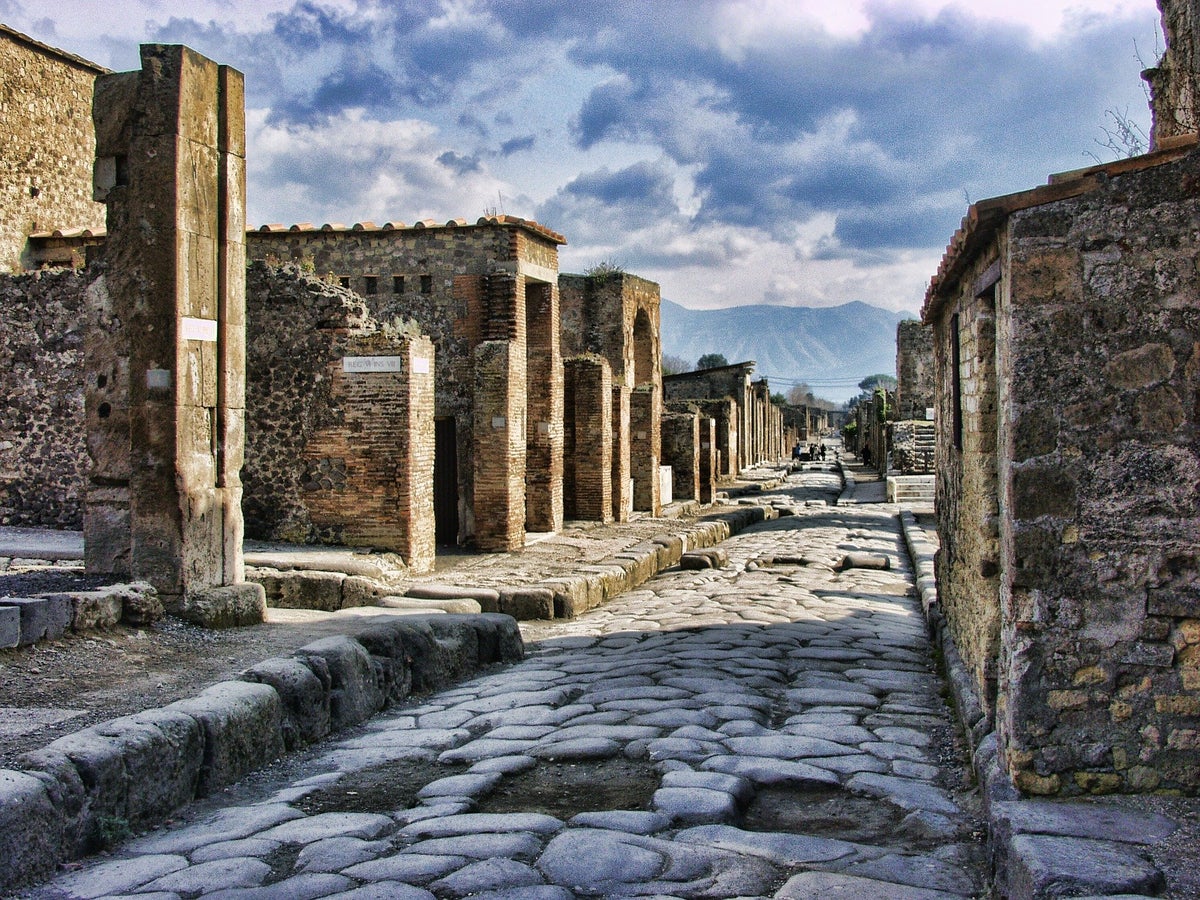
Top 5 Day Trips From Rome
What was once the most important harbor city in Ancient Rome is now an important archeological site and popular tourist destination. Located just 19 miles west of Rome, Ostia’s main arterial street is home to a street show of houses, shops, baths, and taverns. The city is also home to a Jewish synagogue, a Christian Basilica, and a wealth of Persian temples.
You can get to the ancient harbor city by taking the 20-minute journey from the metro Line B station of Piramide to Ostia Antica using the Roma Lido commuter train. The Roma Lido line runs from around 5:30 a.m. until 11:30 p.m., and you can reach Ostia using a travel card costing from as little as $2 (€1.50), depending on the time and duration of your visit.
The ancient city of Pompeii was famously buried by the 79 A.D. eruption of Mount Vesuvius. Visitors come from all over the world to see the perfect example of ancient Roman communities anywhere in Italy . Ruins include the Antiquarium, the Forum, the Terme Stabiane, the House of Menander, the Amphitheater, and the Nuovi Scavi (New Excavations), among others.
Pompeii is 133 miles from Rome, and the train journey from the city takes around 1 hour and 50 minutes. You can reach Pompeii Scavi-Villa dei Misteri station using the Circumvesuviana line that departs from the main Roma Termini station. Ticket prices start from as little as $19 (€17) depending on the time of travel.
Hadrian’s Villa is a UNESCO World Heritage Site and an impressive archaeological complex located in Tivoli, 18 miles east of Rome. Considered to be the most remarkable and extravagant example of an ancient Roman Villa , it was built for Emperor Hadrian when he decided that he no longer wanted to reside in the city of Rome itself.
The giant structure contains a variety of interesting structures including the Nymph Stadium, the Poecile, the Camopus, the Philosophers’ Room, Piazza d’oro, the Grandi Terme, and the Piccole Terme.
You can reach the Villa by taking the Trenitalia line from Tiburtina Station (also on the metro B line) and enjoy a 40-minute ride on the Avezzano bound line. Get off at Tivoli Station to visit the Villa and surrounding attractions. Tickets cost from around $6 (€5).
The pretty, hilltop town of Orvieto is one of the most ancient cities in Italy, and home to some of the most important vineyards in the country . Visitors make the journey from Rome out into the Umbrian countryside to admire the impressive Piazze del Duomo, explore the grottos and rock formation of underground Orvieto, peek into the well at Pozzo di San Patrizio, relax by the fountains at Fortezza dell’Albornoz, and sample the fantastic wines at Decugnano dei Barbi.
The train journey from the city of Rome to Orvieto takes around 1 hour 30 minutes, and you can pick up the Trentitalia Line from Roma Termini. Tickets start from around $8 (€7) for a single journey.
Naples is a UNESCO World Heritage site that dates back as far as 470 B.C. It is also home to 3 amazing castles: Ovo Castle with its imposing fortress, Castel Nuovo with its Medieval towers and Renaissance arch, and the Castel Sant’Elmo with its former prison. Visitors also come to see the Royal Palace of Naples, the Palazzo Reale, and a wealth of historic churches and cathedrals.
Naples is around 140 miles from Rome, so expect a 2-3 hour train journey to reach the city from Rome. The Frecciarossa Express runs from Roma Termini to Napoli Centrale every 20 minutes at peak times, and ticket prices start from $26 (€23), one-way.
How to Stay Safe in Rome
Rome is an enchanting city that can reel you in from the moment you take your first steps out on to the cobbled streets. Whether you are enjoying a drink in one of the many piazzas, taking in the incredible architecture, or simply enjoying some retail therapy, it can be easy to get carried away here.
While Rome is not necessarily any more or less dangerous for tourists than any other European city, it can be easy to become distracted. Follow our advice on how to stay safe in The Eternal City, and breathe it all in without worrying about your belongings.
Rome does have a high number of pickpockets operating in the main tourist areas during the high season. Roman pickpockets are very skilled and have numerous tricks to help relieve you of your belongings. Be aware of distraction techniques such as flower sellers, gangs of children, and even ladies in distress, and be sure to keep your bag in front of you at all times.
This is common sense for any large town or city, and it is just as important here as it is anywhere else. Keep your wallet, phone, and cards locked safely away in your purse, fanny pack, or shoulder bag, and do not flaunt them when you need to use them. Better still, use a money belt or body pouch for days out in the city, to help you keep your belongings safely by your side at all times.
Urban spaces, riverbanks, and deserted piazzas may look romantic in the daylight, but they can become menacing and oppressive when the night falls. Some streets around Termini and Piazza Vittorio, in particular, are not safe for strolling tourists after dark. Likewise, some stretches of the river are not as safe at night as they would be during the day.
If your plane ticket, passport, personal ID, or other important document goes astray while you travel, it can make things extremely difficult for you. If you are able to make and store electronic copies of all of your important documents, either by email or your smartphone camera, you will always have a back up should you need them.
Should the worst happen, you will probably want to call the police. Make a note of the following telephone numbers and keep them safely with you while you travel:
- General Emergency: 113
- Police (Carabinieri): 112
- Fire (Vigili del fuoco): 115
We aren’t telling you how to dress with this one, simply suggesting that you keep your maps, travel cameras , and large amounts of cash out of sight while you are on the road. This will make you look more like a local and less like a tourist.
Most hotels will offer a safe facility in their guest rooms. These are important because it means your belongings are safe and sound and you don’t need to take all of your stuff with you.
Rome is perhaps one of the most beautiful and romantic cities in the world. With so much history right on your doorstep, it can be challenging to take it all in the first time you visit.
From the historic architecture and works of art to modern-day fine dining and upscale shopping, Rome really is a city that has it all.
Frequently Asked Questions
Is rome safe.
Rome is as safe as any European city but you should be extra vigilant of pickpockets in tourist areas. Avoid carrying your valuables on your back, consider using a money belt, or better yet, only take the bare minimum out with you and leave the rest in your hotel safe.
Can you do Rome in 3 days?
There is a lot to see and do in Rome but you can certainly see the highlights over a weekend. Luckily most major sights and attractions are quite close together. While it comes down to personal preference the following are not to be missed:
- Spanish Steps
- St. Peter’s Basilica
- Vatican City
What are the best day trips from Rome?
There are quite a few places that are within easy reach of Rome and if you’re willing to travel an hour or 2 each way, these can be visited within a day.
- Hadrian’s Villa
Was this page helpful?
About Amar Hussain
Amar is an avid traveler and tester of products. He has spent the last 13 years traveling all 7 continents and has put the products to the test on each of them. He has contributed to publications including Forbes, the Huffington Post, and more.
INSIDERS ONLY: UP PULSE ™

Get the latest travel tips, crucial news, flight & hotel deal alerts...
Plus — expert strategies to maximize your points & miles by joining our (free) newsletter.
We respect your privacy . This site is protected by reCAPTCHA. Google's privacy policy and terms of service apply.
Related Posts
![travel around rome The Ultimate Guide to Buying the Best Travel Insurance [For You]](https://upgradedpoints.com/wp-content/uploads/2018/09/Travel-insurance-tag-on-luggage.jpg?auto=webp&disable=upscale&width=1200)
UP's Bonus Valuation
This bonus value is an estimated valuation calculated by UP after analyzing redemption options, transfer partners, award availability and how much UP would pay to buy these points.
Rome Transportation 101: How to Get Around in Rome
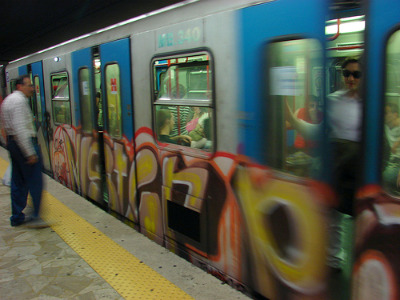
How to Use Public Transportation in Rome
There are several ways to get your body around Rome to see the sights, not to mention getting to and from your hotel or hostel in Rome . They vary in terms of cost and speed, so you’ll have to figure out which one balances the two to your satisfaction. >> Find out whether one of the Rome discount passes that include transportation will save you money on your trip.
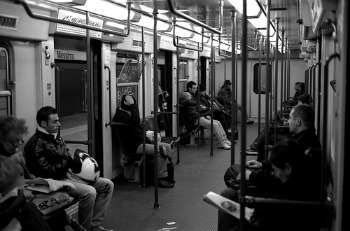
- BIG – Integrated Daily Ticket – Good for 24 hours from validation, €4
- BTI – Integrated Tourist Ticket – Good for 3 days from validation, €11
- CIS – Integrated Weekly Ticket – Good for 7 days from validation, €16
There are monthly and annual passes, too, but those are more geared toward residents. If you’re a lucky person and you’re staying longer than a week, then definitely ask about the monthly or annual tickets! All of the tickets that work on the Rome Metro also work on other forms of public transportation in Rome – the buses and the trams – so that makes it easy to switch back and forth depending on what’s close by and what’s most convenient. When riding the Rome Metro, especially when it’s busy and crowded, you’re well-advised to keep a close eye on your belongings – from your purse to your camera to your wallet. Of course, this is something you should do regardless, whenever you’re in a crowded and unfamiliar place, but it bears repeating for the subway in Rome.
Buses in Rome

You can buy bus tickets at most news stands in Rome as well as most tobacco shops, and if the bus stop you’re at is big enough there will also be automated ticket machines at the bus stop where you can buy tickets. These are the same tickets you’ll use on the Metro, so that means you can also buy them at the automated ticket vending machines in the Metro stations in Rome. Remember to validate your ticket when you board the bus – there are usually machines at the front and the back of the bus, and sometimes in the middle as well – by inserting the ticket into the machine until it gets a date/time stamp. These stamps not only indicate what time you got on the bus (and started the clock ticking on your 75 minutes, if you’re using a single-use ticket), they also cleverly tell you what time that ticket expires. You’ll hear about people who buy one ticket and never bother to validate it, playing the “dumb tourist” card if/when they get stopped by the transportation police, but if you risk it and you get caught you could be facing a €50 (or more) fine. In my opinion, it’s just not worth the risk. Buy whatever ticket makes sense for your visit to Rome, and validate it when you board the bus. The same safety warning I mentioned above about riding Rome’s Metro also goes for the buses, especially the tourist routes and especially at busy times. For more information, check the official site of the Rome transportation company , ATAC. And the folks at Venere have a few tips about bus travel in Rome, too.
Trams in Rome
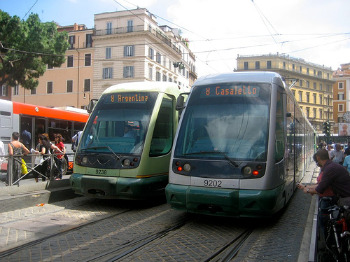
Taxis in Rome
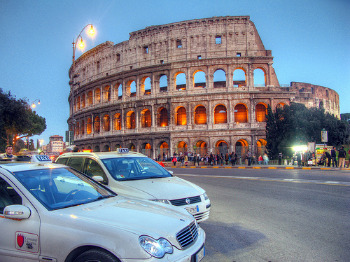
Become a Member and get free shipping on your orders!
SIGN UP FOR 10% OFF ON YOUR FIRST ORDER

- Log in or Sign up
- Mother's Day
- Exclusive Ceramics
- Citrus Collection
- Giadzy Pasta
- Giada's Essentials
- Limited Edition
- Subscriptions
- Recipe Boxes
- Pasta Night
- Gluten-Free
- Easy Cooking
- Short Pasta
- Sauces & Passatas
- Whole & Sun-Dried
- Spices & Herbs
- Rice & Grains
- Spreads & Preserves
- Jams & Honeys
- Breads & Crackers
- Truffles from Alba
- Chocolate & Candy
- The Magazine
- The Membership

How To Get Around In Rome: The Public Transportation Guide

Planning a trip to the eternal city and unsure of how to get around? From where to find taxis and how to use the train, this is the guide for you!
While walking is certainly the best way to travel around the historical center of the city, there are a variety of other options at your disposal. From how to travel from the airport to easily accessible day trips, we’ve got your transportation questions covered.

How do I get to the center of Rome from Fiumicino Airport?
Fiumicino airport is located about 40 minutes away from the center of Rome. There are many different ways that you can choose to travel into the city center! Here are some options, listed from least expensive to most expensive.
$ Take the Bus
There are two bus companies that travel from Fiumicino airport to central Rome. The SIT bus costs €7 and will take you from airport terminal 3 either to Termini Station (Rome’s central train station) or near the Vatican. The Terravision bus costs €6 and travels from terminal 3 to Termini in 50 minutes. Both websites give detailed information on timetables and fares and you can either buy tickets online, ahead of time, or look for the SIT and Terravision ticket counters when you pick up your luggage.
$$ Take the Train
The Leonardo Express train travels between Fiumicino airport and Termini station every 15 minutes. For €14, you’ll reach central Rome in just 32 minutes! To look at train times and purchase tickets ahead of time, visit the Trenitalia website . You can also buy tickets from one of the train kiosks located near the baggage claim when you land in Rome. Follow airport signs for the train ( treno in Italian), scan your ticket, and begin your Italian adventure!
$$$ Take a Taxi
Taxi stands are located right when you exit the airport. Simply get in line, tell the attendant how many people and luggage bags will be in the taxi, and you’ll catch one in no time! Set at a fixed price of €50, a taxi will take you straight from the airport to wherever you need to go within central Rome. This is definitely the recommended option for families or anyone that wants to spend for ease of travel.

What public transportation is available in Rome?
The Metro (Roman Subway)
The Roman Metro has two lines (line A and line B), with a third line (line C) currently under construction. If the place that you’re traveling within Rome happens to be on one of these lines, the Metro is a great option. It is easy and affordable! A 100-minute, one-way BIT ticket with unlimited transfers costs €1.50 and can be used for all forms of public transportation (subway, bus, and tram). If you are planning on utilizing public transportation a lot, you can opt for a 24, 48, or 72 hour pass, costing €7, €12.50, and €18 respectively. You can buy tickets using the kiosk at any Metro station or use your credit card to just tap&go ! Read more about Metro ticket options here .
Major Sites You Can Access Via Metro:
- Termini Central Train Station: It has it’s own stop on line A and line B!
- The Vatican Museums: A 5-10 minute walk from Metro stop “Cipro” on line A.
- St. Peter’s Basilica: A 5-10 walk from Metro stop “Ottaviano” on line A.
- The Spanish Steps: Located right outside Metro stop “Spagna” on line A.
- The Trevi Fountain: A 10-15 minute walk from Metro stops “Spagna” or “Barberini” on line A.
- Piazza del Popolo: A 5-minute walk from Metro stop “Flaminio” on line A.
- The Colosseum, Roman Forum, & Palatine Hill: Located right outside Metro stop “Colosseo” on line B.
Because the Metro only has two fully operating lines at this time, many Romans use the bus on a daily basis. But, be warned: the bus is not the most reliable option when it comes to traveling places in a timely manner! The same BIT tickets that are used for the Metro can be used for the bus, so you can purchase bus tickets ahead of time at any Metro kiosk. If you find yourself needing to take the bus, you won’t show your ticket to the bus driver when you get on, but instead validate it using one of the validation machines on the bus. Make sure that you both have a ticket and validate it or you could be charged a hefty fine! Need to take the bus last minute, but don’t have a ticket? Check out TicketAppy , an app that allows you to buy and use public transportation tickets in Rome right from your phone!
Trying to get to the Trastevere neighborhood from the center of the city? The tram could be for you! Rome has six above ground tram lines that run through the city, but tram 8, which runs from Piazza Venezia to Trastevere, is often the most convenient one for visitors to Rome. The same 100-minute BIT tickets and validation rules as the bus apply for the tram! Check out the full tram map here .
Hours of Operation
Buses and Trams: Everyday 5:30am-12am
Metro: Sunday-Thursday 5:30am-11:30pm
Friday & Saturday 5:30am-1:30am
***For traveling between 12am-5:30am, there are a variety of night bus options .

How do I find a taxi?
For traveling further distances in the city, a taxi can be a great option! Just be aware that a car may not be able to enter certain streets in centro storico ! You can find a taxi by calling a taxi company, flagging one down at a taxi stand, or by using an app.
In Rome, you’ll have the best luck getting a taxi, not by flagging one down, but by going to a taxi stand. There are taxi stands located all over the city, usually near main tourist attractions! Look for an orange sign that says “Taxi”. Here are a few convenient ones to note:
- Near Chiesa Nuova: Via della Chiesa Nuova
- Near Piazza Navona: Piazza delle Cinque Lune, 33
- Near the Trevi Fountain: Piazza di S.Silvestro, 19
- Near the Spanish Steps: Piazza di Spagna, 42
- Trastevere Neighborhood: Piazza Giuseppe Gioachino Belli, 2
- Near St. Peter’s Basilica: Via della Traspontina, 3 or Piazza del Risorgimento, 32/33
- Prati Neighborhood: Piazza Cavour, 17
The FreeNow App
Want to call a taxi using an app? Download the FreeNow app ! Similar to companies like Uber and Lyft, this app will allow you to order a taxi to and from a specific location, quote a price, as well as update you on the status of arrival.
Can I take a day trip from Rome without a car?
Assolutamente! There are tons of great day trip spots from Rome that you can reach by train! Here are a few of our favorites:
- Tivoli: A wonderful town only 45 minutes away by train with three fantastic sites to see: Villa Adriana, Villa D'Este, and Villa Gregoriana. Check out our full guide here !
- Orvieto: We adore this hilltop town in Umbria! With an incredible duomo , gorgeous views, vineyards nearby, and only 1 hour and 30 minutes from Rome, Orvieto is not to be missed.
- Bracciano: This breathtaking medieval town is perched on Lake Bracciano and is just an hour train ride away. Wander the cobblestone streets of its centro storico , visit the Orsini-Odescalchi Castle, or walk down the hill to the idyllic lakeside beach!
- Ostia Antica: Most people have heard of visiting Pompeii, but have you heard of Ostia Antica? This well-preserved ancient Roman city is a true marvel to see. The best part? You can reach it by public transportation! Take the Rome-Lido suburban train line from the Piramide Station (on the Metro B line) and 30 minutes later, you’ll be at the Ostia Antica stop.
- The beach: Want to visit the beach? Take the same Rome-Lido suburban train line that you would take to Ostia Antica, but get off at Lido-Centro to reach Ostia Beach (only 35 minutes from Rome). Willing to go a bit further? Santa Marinella Beach can be reached by train in about an hour!
For all train ticket prices and schedules, visit Trenitalia’s website and check out our tips for navigating train travel in Italy. Need more tips and tricks for your trip? Check out Giada's Guide to Rome !

Michele Becker is a writer, teacher, and Italy fanatic based in Boston, Massachusetts. Michele's expertise lies in ancient Italian history, food traditions, and Roman life, having lived in Rome multiple times. When she isn't researching Italy's best restaurants, planning her next trip, or writing, you can find Michele color coordinating her myriad of cookbooks.
Shop The Story

Pecorino Romano DOP Cheese

Artichoke Spread

Taralli Cacio e Pepe

Soft Amaretti Cookies in Rome Tin
More articles.

17 April 2024 - By Michele Becker
Meet the Dangerous Beauties That Gave Sorrento Its Name

03 April 2024 - By Michele Becker
How to Travel by Ferry Along the Amalfi Coast

15 March 2024 - By Giada
What Giada Ate in Austin During South by Southwest

13 March 2024 - By Jill Manassee
Lecco is the Perfect Place to Enjoy the Local Side of Lake Como

11 March 2024 - By Regan Hofmann
The Most Beautiful Villas on Lake Como You Can Visit

04 March 2024 - By Jaclyn DeGiorgio
Resta di Como, the Northern Italian Easter Bread You’ve Never Heard Of

21 February 2024 - By Michele Becker
5 Dishes You Must Try in Lake Como

13 February 2024 - By Regan Hofmann
The Local’s Guide to the Most Romantic Places in Italy

06 February 2024 - By Regan Hofmann
Spend Valentine’s Day in Verona, Italy’s Most Romantic City
© 2024 Giadzy Privacy Policy Terms of Use Giadzy is a registered trademark. All rights reserved.
Join us and get nice things
Free stuff and general goodness
*By completing this form you're signing up to receive our emails and can unsubscribe at any time.

Rome was called the “ Eternal City ” by the ancient Romans because they believed that no matter what happened in the rest of the world, the city of Rome would always remain standing . Exploring the city center by foot surrounded by glorious monuments and colossal remains takes you back in time to the “glory that was Rome”.
Rome Travel Guide
- General Information
- Top Attractions
- Getting to Rome
- Public Transport
- Money-saving tips
- Where to Eat
- Where to Stay
- 3-Day Itinerary
Why visit Rome?
With its unparalleled history, Rome is the third most visited city in Europe and the fourteenth worldwide. It attracts visitors from all over the world who are impatient to discover the city’s impressive monuments and archaeological sites ; not to mention its renowned cuisine and its lively atmosphere.
When exploring the Colosseum , visitors will easily imagine how the gladiators fought for their lives in the arena, cheered by the crowd. In the Circus Maximus , travelers will picture the chariots crashing into each other in order to be first in the race, and in the Roman Forum visualize what the Roman public life was like.
Looking for accommodation?
If you haven’t booked your accommodation yet, we suggest visiting our search engine , where you’ll find all types of hotels, hostels, and apartments with the best rates guaranteed . You can get up to a 75% discount and pay once you get to your destination.
- Accommodation in Rome - find the best deals
top activities
Vatican Museums & Sistine Chapel Guided Tour Skip the endless queues for the Vatican Museums and the Sistine Chapel—explore the most iconic landmarks in the Vatican City accompanied by an expert guide .
Colosseum Tour + Gladiator's Entrance When in Rome, don’t miss the eternal Colosseum! Access the arena through the Gladiator’s Gate, the entrance used by the ancient Roman fighters.
Sistine Chapel, Vatican Museums + St Peter's Basilica On this tour, you'll get access to the Sistine Chapel first thing in the morning, avoiding all the crowds . We'll also visit St Peter's Basilica .
Colosseum, Roman Forum & Palatine Hill Tour Travel back in time to Ancient Rome and discover the Colosseum, the Roman Forum, and Palatine Hill on this guided tour with priority access !
Pompeii & Naples Day Trip Set off on a full day trip and discover the ruins of Pompeii , followed by a panoramic tour of Naples , one of the world's oldest constantly populated cities.
Rome Ciampino Airport Shuttle Bus With this shuttle service between Ciampino Airport and Rome, you'll be in the centre of the Italian capital in less than an hour. The eternal city awaits you!
Audience With Pope Francis An audience with Pope Francis is a unique spiritual experience . Your guide will take care of everything, so you can go relaxed.
St Peter's Basilica Guided Tour + Dome Climb Enjoy the best views of Rome by climbing the 320 steps leading up to the dome of St. Peter's . We'll also visit the interior of the Basilica!
Trastevere Food Tour Feast your eyes and stomach during a 3-hour food tour in Trastevere, one of Rome’s most bohemian neighborhoods and sample the delicious Italian gastronomy.
Borghese Gallery Guided Tour Discover the extraordinary collection of paintings and sculptures housed in the Borghese Gallery , one of Rome's must-see art museums .
Day Trip to Venice by High Speed Train Experience a day trip from Rome to Venice on a high-speed train and explore its beautiful canals and historic centre at your own pace.
Rome Catacombs Tour & Appian Way Visit the catacombs of Rome with an expert English-speaking guide during a 3-hour half day-trip, also discovering the fascinating Villa di Massenzio.
Rome Fiumicino Airport Shuttle Bus Are you travelling to Rome? Book this shuttle bus between Fiumicino Airport and Rome so you can get into the city centre comfortably and quickly.
Florence & Pisa Day Trip Discover two incredible jewels in Tuscany on our Florence & Pisa Day Trip from Rome. You'll see the Duomo , the Ponte Vecchio and the Leaning Tower .
Ostia Antica Half-Day Tour from Rome Discover the legacy of the Imperial City on a guided tour of Ostia Antica, an ancient harbor town only 30 km from Rome. Travel back in time with this tour!
Papal Audience & Vatican Museums Tour Enjoy this unique experience of the Holy See with this combination tour which includes an audience with Pope Francis and a visit to the Vatican Museums .
Visit the largest Roman amphitheater in the world on this guided tour of the Colosseum. An absolute must if you're in the Italian capital!
Rome Bike Tour Tour the Italian capital on two wheels whilst you enjoy an electric bike tour of the Colosseum, the Pantheon, the Roman Forum and much more .
Rome Sightseeing Cruise on the Tiber River Take a sightseeing cruise along the Tiber River and enjoy spectacular 360º views of Rome from the water. You can hop on and off as many times as you want!
The Three Tenors Concert The church of St. Paul's Within the Walls in Rome opens its doors to you to offer you the show The Three Tenors. Enjoy an unforgettable opera concerto.
This tourist bus is the perfect way to discover Rome . You can choose different routes with numerous stops and hop on and off as many times as you want!
Set off on a day trip from Rome across the Italian countryside to discover the birthplace of St Francis in the charming town of Assisi .
The Four Seasons by Antonio Vivaldi With this classical music concert, you'll experience all Four Seasons of the famous Antonio Vivaldi . An unforgettable concert in an incomparable setting!
Castel Sant'Angelo Tour + Terrace Access A refuge for popes and an ancient Roman mausoleum , Castel Sant'Angelo harbours great secrets. On this guided tour we'll unveil its most hidden mysteries.
Welcome to Rome Tickets Immerse yourself in Rome's thrilling history when you buy a ticket for the fascinating Welcome to Rome multimedia experience .
Castel Sant'Angelo Ticket + Audio Guide Explore the intriguing history of Castel Sant'Angelo with this admission ticket + audio guide. Uncover the mysteries of one of Rome's most cryptic monuments !
Italian Pizza Workshop Visit Rome and enjoy a delicious pizza made with your own hands . Try this Italian Pizza Workshop and learn how to make one of the country's most famous dishes.
Lake Albano Kayak Tour If you're in Rome and want to escape from the hustle and bustle of the big city , join us on this kayak tour on Lake Albano .
Italian Pasta & Tiramisu Workshop If you love Italian cuisine, then don't miss out on this Italian Pasta and Tiramisu Workshop . You'll learn how to make some staple Italian dishes!
Rome Night Tour On this night tour of Rome , we'll visit the most iconic piazzas , streets and monuments of the Italian capital when the city comes to life at dusk.
Palazzo Santa Chiara Opera Concert Treat yourself to a unique experience during your stay in Rome when you attend a fantastic opera concert at the Palazzo Santa Chiara .
La Traviata with Ballet Entrance Ticket Enjoy one of the most famous operas of all time in the magical setting of the St Paul's Within the Walls Church with this La Traviata Ballet Entrance Ticket.
Private Walking Tour of Rome Explore the Eternal City's most iconic sights accompanied by an expert guide just for you and your partner, family or friends. Discover the best of Rome !
Rome Mysteries & Legends Free Tour Wandering ghosts and enigmas in Caravaggio's works ... Discover the hidden side of the city with this free tour of Rome's mysteries and legends.
Rome Squares and Fountains Guided Tour Set off on a walking guided tour of Rome and discover some of its iconic landmarks, such as the Fontana di Trevi, Piazza di Spagna, and Piazza Navona .
Mostra di Leonardo Ticket Discover some of the most amazing inventions by the Italian genius Leonardo da Vinci with this ticket to the Mostra di Leonardo museum.
Trastevere and Jewish Ghetto Tour Enjoy a walking guided tour of Trastevere and the Jewish Ghetto and soak up the neighborhood’s bohemian atmosphere with numerous landmarks to visit.
OMNIA Rome & Vatican Card The OMNIA Card is a sightseeing pass that includes priority access to Rome’s main attractions like the Colosseum, Roman Forum, and Vatican City .
Go City: Rome Explorer Pass The Go City: Roma Explorer Pass tourist card gives you access to the main attractions in the Italian capital, such as the Sistine Chapel and the Colosseum.
The impressive dome of the Pantheon of Agrippa has fascinated the whole world for centuries. Discover it with this guided tour of Ancient Rome .
St. Peter's Basilica Tickets: Dome Access + Audioguide Secure your ticket to St. Peter's Basilica for an experience that includes access to its magnificent dome and a self-guided tour with an English audio guide .
Baths of Caracalla & Circus Maximus Guided Tour Go back in time on this walking tour of the Bath of Caracalla, the most luxurious thermae of the Roman Empire . Then marvel at the remains of the Circus Maximus.
Capitoline Museum Guided Tour Marvel at one of Rome’s most important museums , the Capitoline Museums, followed by a visit to Piazza del Campidoglio on top of the Capitoline Hill.
Day Trip to Siena, San Gimignano and Chianti On this tour to Siena, San Gimignano and Chianti , we'll discover the beautiful region of Tuscany - including medieval towns, and a visit to a wine cellar!
Basilicas Tour and Secret Underground Catacombs Discover some of the most symbolic sites in Christian history: the Catacombs and two of the world's most important Basilicas on this tour of the Eternal City.
Rome Tuk Tuk Tour Tour Rome in the most comfortable way on this tuk tuk tour. We'll explore its seven hills and learn tons of historical fun facts about the eternal city.
Rome Photo Tour Discover the most Instagrammable locations in the Italian capital and show off your trip with this Rome Photo Tour. Benvenuti a Roma !
Tiber River Cruise with Appetizer Discover Rome from a privileged perspective as you relax with this Tiber River Cruise with Appetizer. You'll see symbolic places such as the Umberto I Bridge.
Rome Private Tour with Driver Fall in love with Rome with this private tour with driver. Choose your route, and enjoy a comfortable tour solely for you and your travel companions.
Hadrian's Villa and Villa d'Este Day Trip Visit the two treasures of Tivoli on this day trip: Hadrian's Villa, Roman Emperor's retreat, and Villa d'Este, a Renaissance mansion with magnificent gardens.
Rome Hard Rock Cafe Come to the Rome Hard Rock Cafe and enjoy an exquisite menu of American food in an emblematic place where the rhythm of rock is felt in every corner.
Rome Fascist History Tour discover the architecture designed in Rome at the time of Benito Mussolini's fascist dictatorship with this Rome Fascist History Tour.
Wine Tasting in Rome Italy is world-renowned for its tradition of wine-making. Indulge your senses on this wine tasting tour of Rome with an expert sommelier!
Bioparco di Roma Ticket With your ticket to the Bioparco of Rome you will discover this zoo located in the heart of the city, inside Villa Borghese, an ideal plan for families!
Janiculum, Trastevere and Jewish Quarter Guided Tour On this fascinating tour of the Gianicolo , Trastevere and the Jewish Quarter in Rome, we'll gain a truly unique perspective of the Italian capital.
Rome Street Art Tour Discover secrets and the most interesting glimpses throughout the most colourful district with this Rome Street Art Tour. Explore the captivating capital city!
Entrance to IKONO Rome Looking for a unique plan in the Italian capital? With a ticket to IKONO Rome , you'll get to explore this creative space and become a part of the art!
Roma World Entrance Ticket Don't miss out on your ticket to Roma World , a theme park in which you'll travel back in time to the ancient and powerful Roman Empire .
Cinecittà World Ticket With this entrance ticket to Cinecittà World you can visit real film sets and travel to the imaginary worlds of movies and TV series .
Rome Private Day Trips Explore the beautiful Italian cities of Naples, Pompeii, Ostia or Assisi with these Rome Private Day Trips. You'll have an exclusive guide just for your group.
Rome Layover Tour Take advantage of your time at Rome airport to explore the Italian capital with this Rome Layover Tour. You'll discover the charm of the beautiful Eternal City.
Private Photoshoot outside of the Colosseum Remember your trip to Rome forever with this private photoshoot outside the Colosseum - we'll make sure you look your best beside the iconic monument!
Florence Excursion by High Speed Train Known as the "City of Art", Florence is one of the most beautiful cities in the world. On this day trip, we'll tour its historic centre and the Uffizi Gallery.
Rome Pub Crawl Are you ready to discover the vibrant nightlife of the Italian capital ? Join us on this pub crawl through Rome and experience it for yourself!
Trevi Fountain and its Underground World On this tour of the Trevi Fountain and its underground world , we'll reveal the hidden treasures and history of the most fountain in Rome .
Ischia 5-Day Tour Are you in Rome? Join us to visit the most beautiful islands in the Napolitan archipelago on this 5-day tour of Ischia . You'll love it!
Private Tuk-Tuk Tour of Rome Would you like to see the Eternal City in the most comfortable way ? On this private tuk-tuk tour of Rome , we'll tour the capital of Italy in an exclusive group.
Rome Electric Tuk Tuk Tour Explore the Eternal City through an eco-conscious lens with our electric tuk tuk tour of Rome and roam the Italian capital's streets in a zero-emission vehicle!
Naples to Capri Tour: 2/3 Days Relax in southern Italy with this Naples to Capri Tour lasting 2/3 days. Discover Pompeii's incredible history, Sorrento's cuisine and Capri's beauty .
Roam the underbelly of Rome on this tour of its underground system . Walk the Appian Way and Caffarella and dive into the lesser-known side of the Eternal City !
5 Day Tour: The Best of Italy The best of Italy in just 5 days! Asisi, Siena, Florence, Bologna, Padua, Venice and Montepulciano are the cities we take in on the tour.
Rome: Angels and Demons, the Illuminati Adventure Quest Impersonate Robert Langdon himself for a day in this puzzle hunt in Rome: Angels and Demons , the Illuminati Hunt. The best way to explore the city!
Pompeii & Minori Tour: 3 Days Discover the impressive ruins of Pompeii , explore the Almafi Coast & enjoy 2 nights in Minori on this incredible 3-day tour.
Free Walking Tour of Rome The city of the Caesars, of Baroque and, of course, The Eternal City. Discover Rome with this free walking tour of the Italian capital .
Colosseum Guided Night Visit Visit one of Rome's most iconic monuments all lit up at the most magical time of day on our Colosseum Guided Night Visit at dusk .
Capri Tour: 2/3 Days Be captivated by the glamour of the Italian island with this Capri Tour lasting 2 or 3 days. Explore the fascinating Mediterranean cave, the Blue Grotto.
Pontifical Villas of Castel Gandolfo Day Trip From Pope Alexander VII to Benedict XVI , numerous popes have spent the holidays at the Pontifical Villas of Castel Gandolfo . Explore its links with the Vatican!
Vatican Gardens + Vatican Museums & Sistine Chapel Ticket Discover the green lung of Vatican City on this tour of its gardens. You'll also visit the Sistine Chapel and take a self-guided tour of the Vatican Museums.
Capri Day Trip Like the writers and artists before you, you'll fall in love with Capri on this unmissable tour. Discover the island's myths, legends and Blue Grotto .
Ponza Island Day Trip Enjoy a day trip from Rome to Ponza Island . Cruise along the waters, feel the breeze in your hair and cool off with a dip in the Tyrrhenian Sea!
Colosseum Private Tour Discover the World Heritage Site and one of the Seven Wonders of the World with this Colosseum Private Tour . Explore the Roman site with an exclusive guide.
Vatican Museums Private Tour Step into the legacy of the Italian city-state on this Vatican Private Tour. Visit the Vatican Museums and the Sistine Chapel with just your family or friends!
The most complete guide of Rome
This guide has been written by travelers like yourself and it's designed to help you plan your stay in Rome, so that you get the most out of the city as possible, whether you're staying for 2 days or a month. Find out what the top attractions and the best places to eat are, which museums are worthwhile, and where to stay in Rome. If you’re traveling on a budget, we have also an article on how to save money while visiting this fascinating city, and the daily costs , so that you're prepared before getting to Italy.
The information provided in this guide was updated in January 2023 . If you find a mistake or would like to make a suggestion, please do not hesitate to contact us .

Our travel guides
- top attractions
- where to stay
- and much more
- Where to Stay
- Where to Eat
- Best Time to Visit Rome
- Top 10 Tips for Rome
- Bathrooms in Rome
- What to Pack & What to Wear
Money Matters
Getting Around
Getting to Rome
- Learn Italian
- Can You Travel to Rome Right Now?
- Italy Green Pass - do you need one?
- Rome Coronavirus News & Updates
- Rome & Vatican Tours
- Italy Tours
- Transfers & Transport
- Sign up & get a FREE ebook Subscribe Today!
- Romewise Home Page
Rome transportation - how to get around

By Elyssa Bernard
Dec 13, 2023
The Rome Transportation system makes it easy to get around the city - find out how to get tickets, how to get in and around Rome, whether kids ride free, and much more.
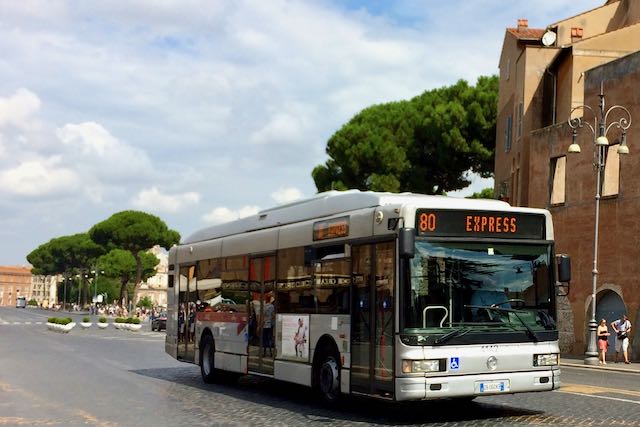
Rome transportation options
One of the most important things that can affect your visit to Rome is deciding how you will get around.
Walking is always my first choice, because there is so much to see on foot, and also because I love the exercise.
And, Rome is pretty compact and you can walk easily from monument to monument, piazza to piazza. Plus you get to peek into doorways along the way.
But it's not always feasible to walk as a means of sight-seeing in Rome, due to weather, tiredness, trying to fit in a lot of stuff in a day, hurt knees, little ones, etc.
Other than walking, here are the best ways to get around Rome:
- ATAC & Cotral city transport (bus, metro, tram)
Hop on / Hop off bus
Private car hire, vespa / motorcycle.
- Electric scooter sharing
- Horse-driven carriage
Finally, here's how to know how to get where you want to go in Rome:
- How to know how to go - apps and websites for getting the best directions
No matter what season you visit Rome, here are 4 things never to leave at home:

Disclosure: If you make a purchase through a link on this page, I may receive a small commission - at no extra cost to you. Thank you for supporting my site!
Public Transportation - ATAC & Cotral
Rome's public transportation is run by ATAC ( Azienda Tramvie ed Autobus del Comune di Roma ). Once you open the site, you can choose English from the language menu at the top.
The ATAC system includes the Metro (underground/subway), Bus , and Tram .
ATAC is complimented in certain areas of the city by Cotral, a private company, who offer bus and overground train services. The best example is the train that takes you to Ostia Antica / Ostia Lido (Beach).
ATAC & Cotral Tickets
You can get a single-use ticket, a daily ticket, 3-day ticket, or longer.
At the end of 2023, ATAC and Cotral introduced new ticket machines at all metro stations, major bus stops and other key locations where you can purchase rechargeable/reloadable tickets.
The aim of these is to reduce the number of single use tickets (and therefore the card they are printed on) being issued.
While a positive step forward for sustainability, this has meant that purchasing single-use tickets at Tabacco shops and news kiosks, as was the norm until recently, has become more difficult.
I'd recommend getting yourself a rechargeable ticket on your first day in Rome, and top it up as and when you need it, keeping it safe for the duration of your trip!

If you purchase any of the above tickets you can use them on the Cotral Rome network (even if they are labelled as ATAC most of the time!).
Note that you can also use your debit/credit card on 'tap and go' sensors at most metro stations, avoiding needing to purchase a ticket.
Children under 10 ride free on all ATAC transportation, and must be accompanied by an adult.
Do this , or risk getting fined...
You must validate your ticket on any public transport journey or risk being fined by ATAC/Cotral inspectors.
At Metro stations this is easy to do; you'll need to enter your ticket in the barriers when accessing the platforms, validating in the process.
On bus or trams you'll need to board and then put the ticket into the small machines often mounted on the handlebars at the front, middle and rear of the vehicle. The machine will stamp the time on your ticket, validating it.
If you do not do this and an inspector asks to see your ticket, you will likely be fined at least 60€. That's the cost of a good lunch or dinner, so not worth risk considering the cheapest ticket is only 1,50€!
Local tip: Some times its impossible to validate your ticket - maybe the barriers at a metro station are open, or a bus is too busy to reach the machine. In this case, write on the ticket the time you boarded your train/bus/tram - show this to an inspector if requested, who will accept this as a makeshift validation 👍
Rome Transportation - Metro
The Rome Metro or underground is an easy, quick way to get around parts of Rome.
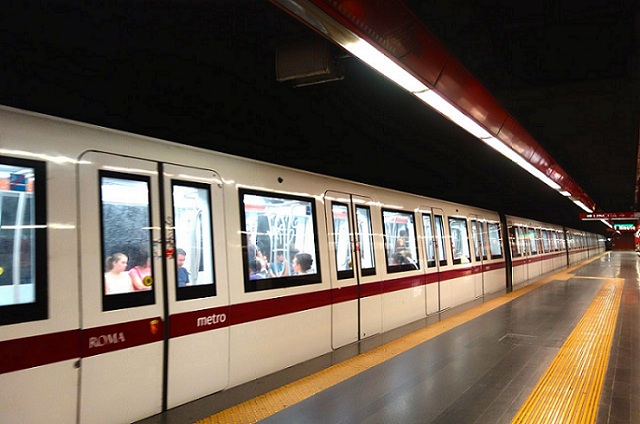
At least, the parts not full of underground Roman ruins !
The metro runs daily from early until late, with the exact timetable varying according to works and special events in the city.
Find out everything you need to know about riding the Rome Metro on my dedicated page .
🤙 Roaming in Rome? 📱
Get yourself an Italian eSIM for calls, messages and data when traveling here.
Save on data charges with plans from just 19€ from Holafly - our recommended eSIM provider!
Click here to get yours now and use code ROMEWISE to save 5%!
ROME TRANSPORTATION - bus
Rome has an extensive bus system , allowing you to get almost anywhere in Rome, even to many areas outside Rome.
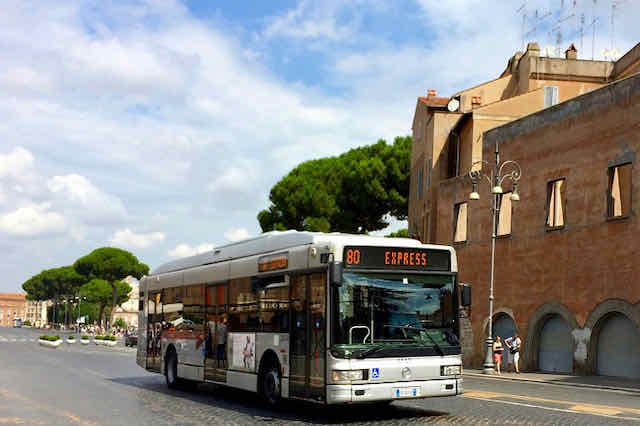
It's the slowest way to go, but it can be an adventure and/or scenic if the bus isn't too crowded.
ROME TRANSPORTATION - Tram
There are a limited number of trams in Rome , all part of the ATAC Rome public transportation system.
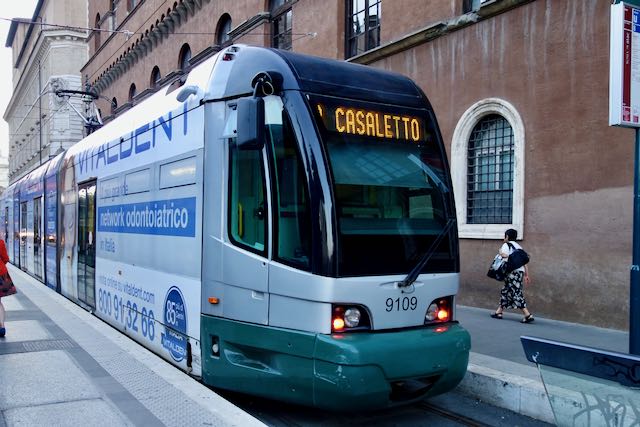
The trams are all in strategic spots, connecting to either a metro or bus stop, making it very easy to get quickly to locations the metro cannot always go, such as the auditorium or MAXXI museum .
The Rome ATAC tickets are not valid for the following means of Rome transportation :
- The Leonardo Express going between Rome Termini and Fiumicino airport .
- The trains that go between Rome and the port city of Civitavecchia .
- Any bus or trains going to either of Rome's airports .
- Hop-on /hop-off double decker buses , which are run by private companies - see below for more information on this
Many open-bus companies offer hop-on / hop-off service in Rome, and they all offer pretty much the same route.
You will see the main tourist attractions of Rome , such as the Colosseum , Vatican , Pantheon , Palatine Hill , etc.
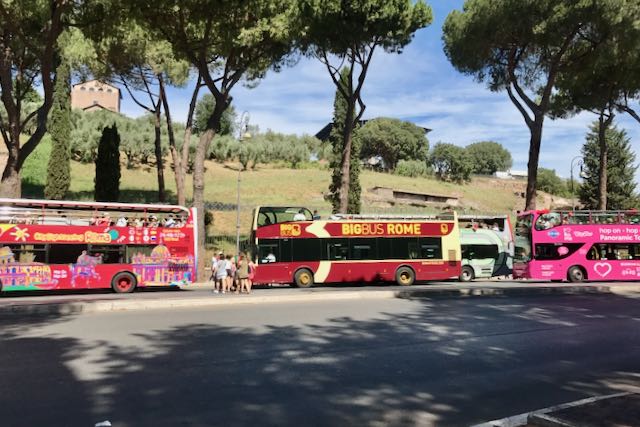
Because they are hop-on/hop-off, you could use this double decker bus both as a means of Rome transportation and also as a way to sight-see.
The hop-on/hop-off bus is also a great option if you want to take in the sights in a day and/or if you are short on time and just want to get an overview.
Click here to read my page about the the Hop-on Hop-off bus tours in Rome.
Click here to book your Hop-On/Hop-Off bus tickets .
I know that many visitors to Rome are wary of taking a taxi in Rome.
Unfortunately, there have been too many tales of people being ripped off by unscrupulous taxi drivers.
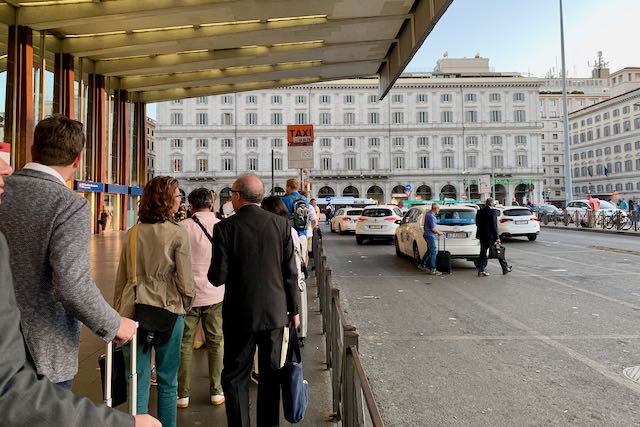
But I am here to tell you that most Rome taxi drivers are honest .
And there are ways to take a taxi and make sure you do not get hustled.
And taking a taxi in Rome can be a good thing when you are tired and hot and just want to get quickly back to your hotel or apartment .
For details on how and where to get a taxi, costs, and how not to get ripped off, visit my dedicated page about taking a taxi in Rome here .
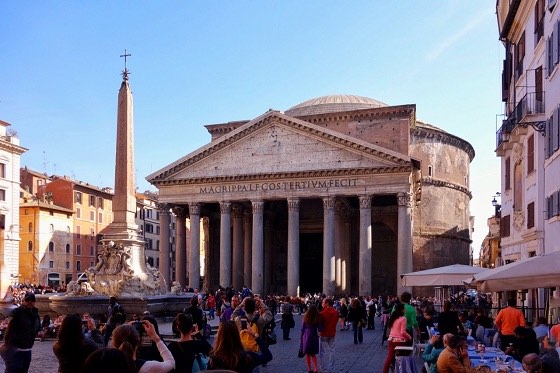
You may want to hire a private car while in Rome.
Typically, people book these to get between Rome and the airport or between Rome and the cruise port city, Civitavecchia .
Many people also opt for a private car hire to take a private tour in Rome , or to get them to other nearby spots such as Pompeii , the Amalfi Coast, Florence , etc.
The best way to hire a private car in Rome is to book in advance.
This way you know exactly what kind of car you are getting and you know the price in advance.
The worst way to take a private car anywhere in Rome is by picking up one as you would a taxi.
Unfortunately, here, again, you may get taken advantage of.
Click here to book your private car for airport transfer.
Click here to book your private car for Civitavecchia port transfer .
Click here to book a private tour of Rome with limo and driver .
Sorry but I must strongly urge you not to use a car as a way to get around Rome.
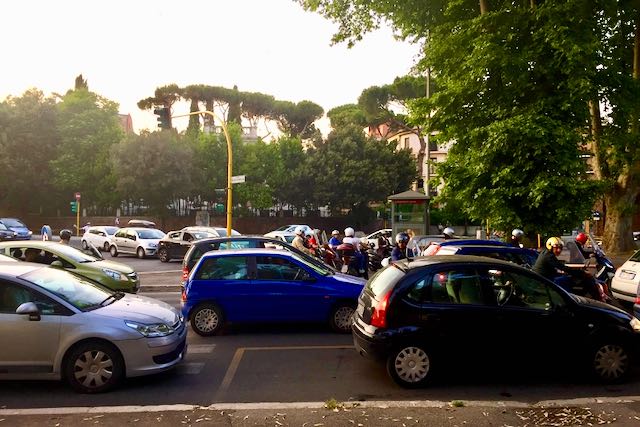
If you are renting a car and driving in or out of Rome, fine.
But there is no need for a car in Rome, it's not easy or cheap to park it, and you risk getting slapped with hefty fines for driving in restricted areas that you may not be able to recognize.
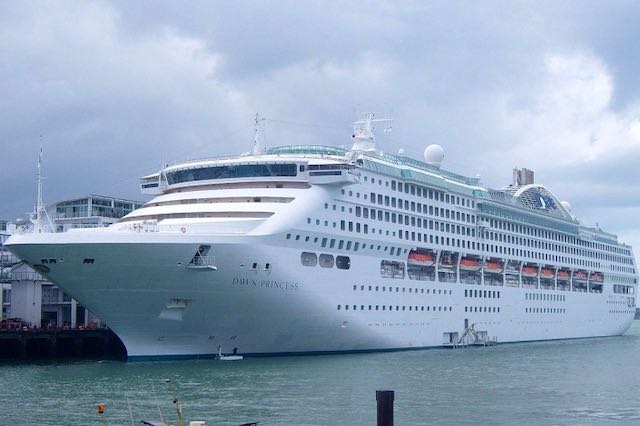
As a means of Rome transportation, you can rent your own Vespa (scooter) or motorcycle if you feel comfortable navigating Rome streets and traffic.

You can also take a tour of Rome on a Vespa /scooter.
This is one of the most fun ways to tour the city. It's easy, safe and allows you to cover a lot of ground. You will be a passenger and get to look and film as you go. You'll wear a helmet and the drivers go very slowly, but you also get that feeling of zipping around Rome as the Romans do.
Click here to rent a Vespa while in Rome .
Click here to book a Vespa tour of Rome !
Ready to plan your trip?
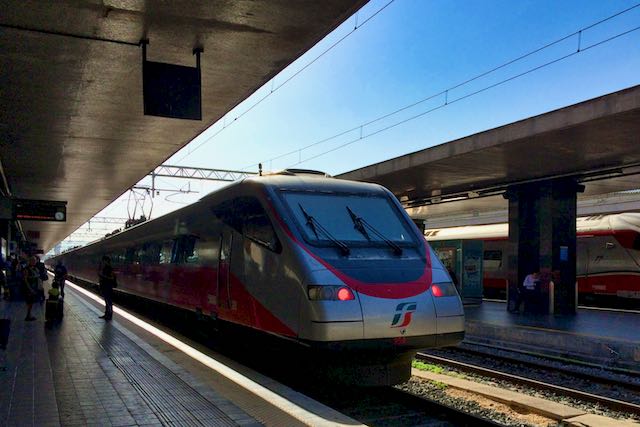
Bicycle - from e-bike sharing to rentals to tours
I have a bicycle but rarely use it as a means of Rome transportation, preferring to use it for a leisurely ride along the Appia Antica or along the Tiber.
But ever since the electric bike-sharing programs began and these bikes started popping up everywhere in Rome, I must say I find them quite useful.
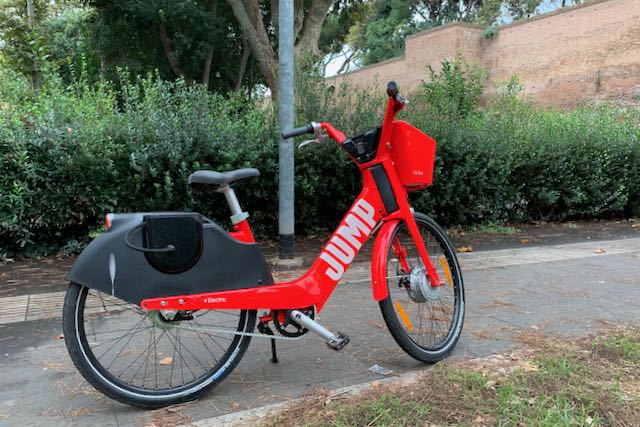
First of all, the bikes are electric which makes riding them a breeze even up small hills.
Second of all, you don't have to worry about where to park them (except of course you do have to make sure you do not park in a prohibited area. The app you use to rent the bike will let you know.)
All you need is the app for the product you want to rent. I have found you can download an app, sign up, and rent one of these electric bikes in a matter of minutes.
You could also choose to rent an electric bike for longer than just a one-time use, and enjoy it as a means of getting around Rome for a day or longer.
Beware, though, that they do not come with helmets so you are taking a risk. Drive slowly, obey traffic laws, and stay safe !
Click here to rent an e-bike .
Click here to book an e-bike tour along the Appia Antica .
You can also rent bicycles on the via Appia which is a very pleasant way to spend a Sunday (because on Sundays the Appia Antica is closed to car traffic).
🔐 Store your bags and luggage securely! 🧳
We're parterned with Radical Storage who have locations across Italy for you to keep your luggage safe before and after check-in, while on day trips and for everything else between 👌
Click here to book now and use code ROMEWISE to save 5%!
Electric scooter
Lately it's all the rage in Rome, and it seems in many cities around the globe as well, to rent an electric scooter or bicycle as a means of getting around Rome.
By rent I mean for one-time use.
There are many brands in Rome that rent these electric vehicles.
A big one is Uber , so if you already have an Uber account, you are set. They use Lime as their intermediary rental app so you'll need to download that if you don't have it already.
Many tour companies are now offering electric bike tours . This is really fantastic because you can see a lot while exercising but without it being too strenuous.
All you need is the appropriate app . Enter your details and payment method and you're good to go.
Segway can be a fun way to get around Rome but given that we barely have bike lanes in Rome, going around on a Segway may not be a very good option as a means of Rome transportation.
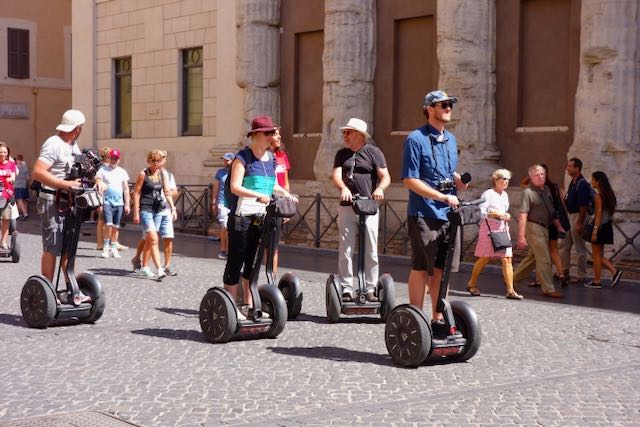
More than anything it could be a fun thing to rent one in the Villa Borghese park, or take a Rome Segway tour.
A golf cart is another comfortable, albeit limited, form of Rome transportation. You can rent a golf cart in the Villa Borghese at two locations - one at the Pincian hill and the other inside the park.
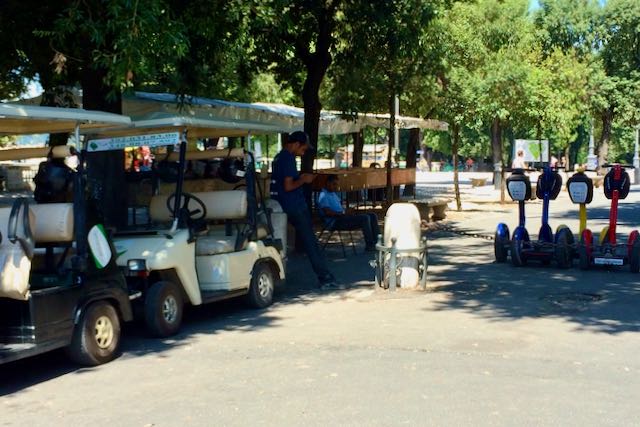
Rates range from around 25 Euros per hour.
You must be over 18 and possess a valid drivers' license.
The golf carts may be taken out of the park but if you are not comfortable driving around Rome, you will probably not want to use this as your means of Rome transportation.
At best, it could be a fun way to spend some time in the park.
Your best bet if you want to sight-see by golf cart is to take a tour and let someone else take you around.
Horse and carriage
Hiring a horse and driver to get around Rome is probably one of the least useful in terms of getting around.
It's more of a touristic experience that will allow you to enjoy a little bit of the sites from the comfort of a slow-moving, open-air carriage.
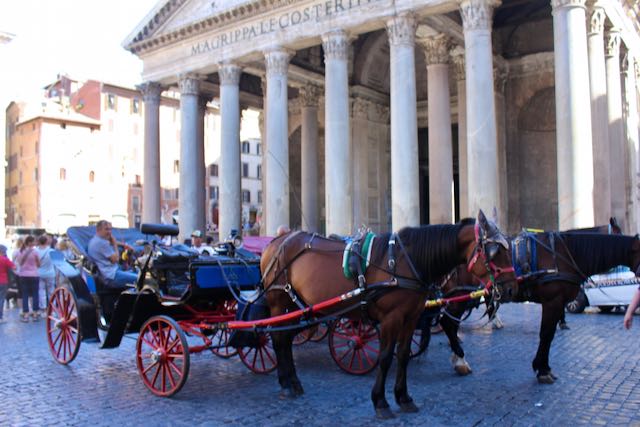
While it may seem romantic, it's also been fraught with controversy over the years.
Some horses have collapsed and even died and the city keeps banning the buggies, and is not currently issuing new licenses.
As of December 2020, the carriages are banned from city streets and may only operate in historic villas (like the Villa Borghese or Villa Celimontana) or public parks.
One final note - this is a very expensive form of Rome transportation so if you do it, negotiate the price in advance so you know what to expect.
How to know how to go - apps for transport in Rome
Wondering how to know how to get from point A to point B in Rome? There's an app for that!
Well, there are a few apps and also a few websites that can help with easy directions, whether you're walking, taking public transport in Rome, transport in Italy, or driving.
Public transportation apps for Rome
- Google maps - they are connected to Rome's ATAC transport system in Rome and also to other transport systems across Italy. Note however that the Metromare metro line from Rome to Ostia Antica and Lido di Ostia is not on Google Maps.
- Apple maps - if you are using an iPhone or other Apple device, you may want to use the built in Apple maps which is also connected to Rome's ATAC system as well as other Italy transport systems in other cities.
Taxi apps for Rome
Both of these apps are free and easy to use and allow you to pay with credit card. You can track where your taxi is while you wait for it:
- Free Now (previously mytaxi)
Directions in Rome and in Italy
Here are some of the best and easiest to use apps and websites for getting directions in Rome and in Italy:
- Rome2Rio - Also sometimes mis-named "rome to rio", this app is not about going from Rome to Rio per se. It's a great app that gives you complete directions literally from start to end, as in, "walk 20 feet to the end of the street. Wait for the bus, once off the bus, walk 2 blocks, then get the tram", etc. It will give you all the steps so you know truly how to get from point A to point B. It will give you options including public transportation, driving (with options for Uber/Lyft/similar or taxi, if applicable), local, regional, and international trains, flights , and more. It's a really complete direction system and easiest to use on a website where you can see the full map.
- Waze - Waze is similar to Google Maps and especially helpful when driving.
Want to know how to get from the Vatican to the Colosseum (or vice versa)?
Visit my dedicated page here.
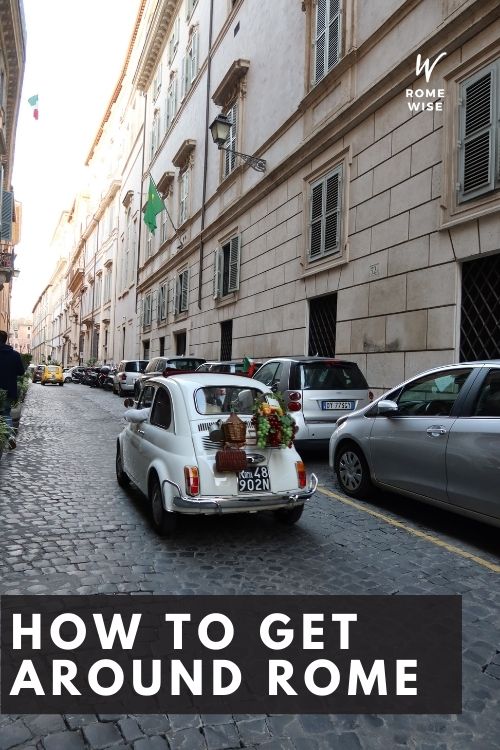
Get your 100% free Rome trip planner now!
Simply sign-up today for our free newsletter and get the Romewise Quick Start guide to Rome:
We are committed to respecting your data. Click for our Privacy Policy .
Comments? Questions? Suggestions?
Please come over to the private Romewise Facebook group and join in the conversation.
You will often find me there, happy to answer your questions / comments!
You will also meet other Rome lovers and experts, too.
What are you waiting for?
Come join in the fun !

Read here about our sponsorship policy
Top attractions and tours

- Colosseum - Don't miss visiting Rome's most iconic monument
- Vatican Museums - This is where the Sistine Chapel is
- Pantheon - Book ahead and skip the line
- Galleria Borghese - You'll need to book ahead for one of Rome's best museums
- Castel Sant'Angelo - See Rome's history through its architecture
- Rome City Pass - A great way to make your Rome visits easier
Disclosure : If you make a purchase through a link on this page, I may receive a small commission - at no extra cost to you. Thank you for supporting my site!
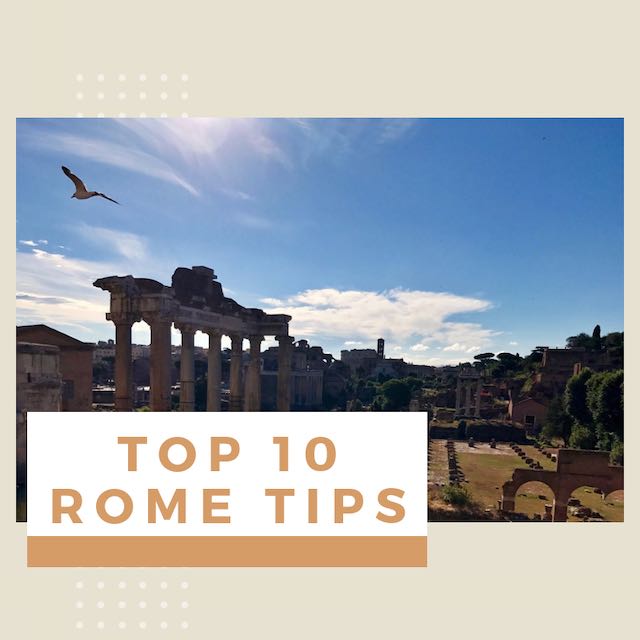
New to Romewise? Start Here
Get the most out of Romewise
Coming To Rome?
Weather in Rome
Accommodation
Already in Rome?
Things to Do
Home | About Me | Privacy Policy | Legal Disclaimer | Affiliate Disclosure | Contact Me
Copyright © 2009-2024 by Elyssa Bernard, Romewise.com | All Rights Reserved.

Places to Visit Near Rome – 10 off The Beaten Path Destinations
Written By: The Planet D
Updated On: January 23, 2024
The beauty of Rome is well known, but few know of its surrounding many villages. These places near Rome are forgotten by tourists and obscured by the brightness of the Italian Capital . Let this local guide take you to off the beaten path places to visit near Rome.
There are several places for a perfect day trip away from the bustling city of Rome. You can go hiking, dig into archeology or relax at the beach. And you’ll find plenty of beautiful scenes and stunning locations to snap photos and share with friends and family. No need to be a professional travel photographer ! here, just let the Italian landscape do the work for you.
Table of Contents
10 Places To Visit Near Rome
Going to Italy? Get the Lonely Planet Italy Travel Guide
1. Tivoli – Villa d’Este
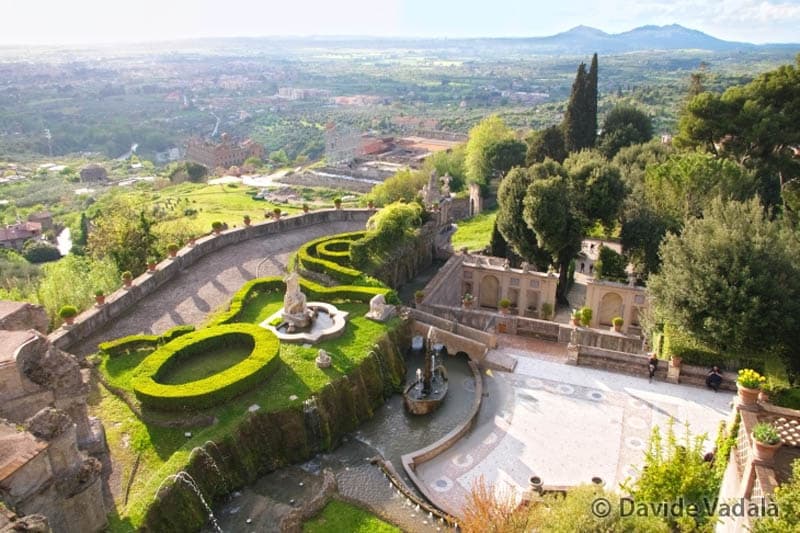
The town of Tivoli is just 30 km far from Rome and easily reachable by bus or train for the price of a Cappuccino. You’ll be amazed of so much beauty concentrated in a small town: the natural park of Villa Gregoriana, the Renaissance style Villa d’Este with its garden, and the ruins of the rural retreat of Emperor Adriano, Villa Adriana.
Tivoli is also famous for its thermal baths: the smell of its sulfurous water is so strong that sometimes it’s perceivable even from Rome. Villa d’Este was built during the 16 th century for the famous and wealthy family of “Este” and its mansion and gardens are part of the UNESCO world heritage list.
The garden will make you drop your jaws: it is decorated with a series of allegorical fountains, cascades and pools, with up to 100 water sprays in the same tank.
The big amount of water required is naturally supplied by the river “Aniene” without the use of any mechanical pump. The garden is built over a slope, thanks to the use of several terraces, overlooking the city of Rome.
Recommended Hotels in Tivoli
- Hotel Cristallo – Hotel Cristallo is conveniently located in Villa Adriana. It is equipped with a great restaurant with world class dining and gorgeous pool. Check out Availability & Prices Trip Advisor / Booking.com
- Grand Duca D’est – The Duca D’Este is just 400 m from the thermal baths. Surrounded by a garden, it offers free parking, a wellness centre and an outdoor pool. Check out Availability & Prices Trip Advisor / Booking.com
2. Tivoli – Villa Gregoriana
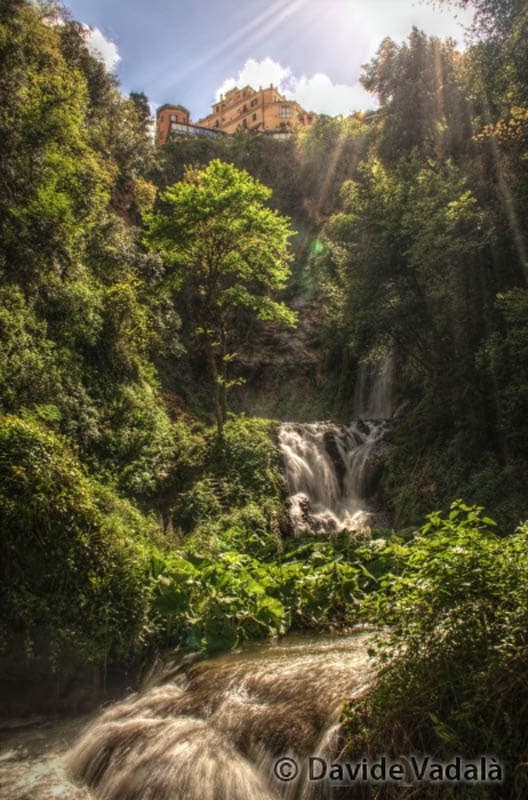
Compared to Villa d’Este, Villa Gregoriana has a much more natural feel: imagine luxurious vegetation growing on the steep slopes going down into the valley. It owes its existence to the river Aniene that passes close to town, before falling down with a 130 m (390 feet) waterfall.
The river was the cause of several floods in the 19th century but in the 19 th century was diverted and transformed into one of the best examples of “romantic garden”. Eventually, Villa Gregoriana sunk into oblivion for a long time, until it was restored, brought to its original splendor. It only reopened a decade ago.
At the top of the park, it’s still possible to see the ancient ruins of the temples from the Roman Acropolis.
Selected Day Tours from Rome
- Get Your Guide is a great site for day tours from Rome and discounts
- Day Tour of Villa d’Esta and Hadrian’s Villa, Tivoli – A full day tour to one of Italy’s most impressive villas. Hadrian’s villa dates back to the 2nd century, built by Emperor Hadrian. You’ll see imperial palaces, temples, theaters, and more. Villa d’Esta dates back to the Italian Renaissance and is renowned for its spectacular gardens and fountains.
- Private Limousine Tour – See Rome in style with this four-hour guided tour of the highlights of Rome. This premium limousine tour is also available from Rome to the Tyrrhenian sea between Ostia and Anzio/Nettuno.
- Ostia Antica Ruins – are a large archaeological site at the harbor city of Ancient Rome. There is time to explore the medieval neighborhood near the ruins as well.
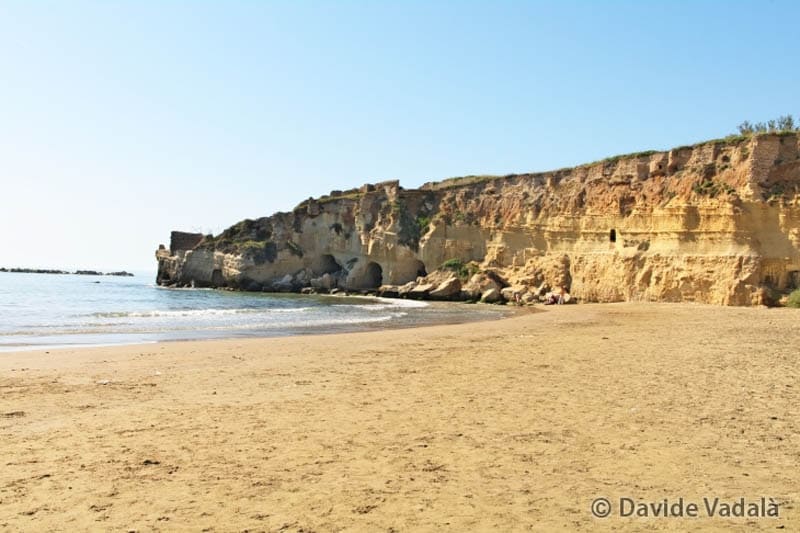
Rome is definitely not famous for his beaches and (non) crystalline water. But the closest beach is Ostia, about 30 km away.
During summer, local inhabitants invade the beaches of Ostia to escape the 40°C (104 Fahrenheit) temperatures. But if you are craving a dip in the sea, a good option is to go a little bit further to the town of Anzio. Anzio is a more picturesque setting with small cliffs, caves and plenty of Roman ruins directly on the beach.
After some beach time, you have the option to stroll to the center of the city, famous for its fish economy or even better the WWF nature reserve of “Tor Caldara” Tor Caldara is about 8 km far away from Anzio.
Recommended Hotels in Anzio
- Hotel L’Approdo, Anzio – Set on Anzio’s seafront just 150 metres from Anzio Colonia Train Station linking with Rome, Hotel L’Approdo is a stylish building with a hydromassage pool on the sea-view terrace Check out Availability & Prices Trip Advisor / Booking.com
- Grand Hotel Dei Cesari – Only 2 minutes walk from the beach, Grand Hotel Dei Cesari is on the Anzio seafront, 2 km from the town centre. It offers free parking, and free access to its private beach and swimming pool. Check out Availability & Prices Trip Advisor / Booking.com
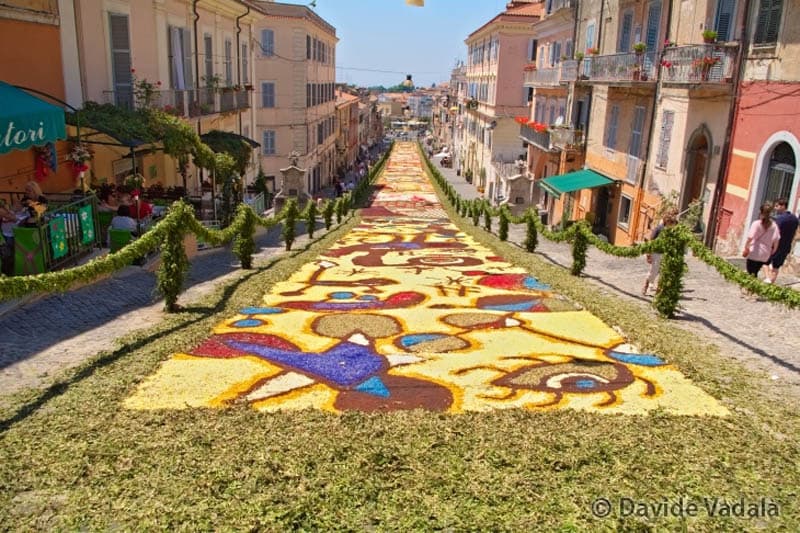
Genzano is a little town on the edge of a volcanic lake called “Lago di Nemi”. It has a nice historical center with tiny alleys and cobbled streets.
The highlight is the massive palace from the 18 th century with a beautiful view over the lake. But the main reason why you want to go there is the “Infiorata di Genzano”. It’s a religious festival that takes place every year during Corpus Domini celebration, in June.
The main street of the town is covered with 13 carpets of flowers representing religious or civil scenes. It is an event not to be missed! During the last day of the festival, the event ends with a parade of traditional costumes. Then it all ends with kids and revelers alike destroying the carpets, and starting a petal fight!
5. Lago della Duchessa
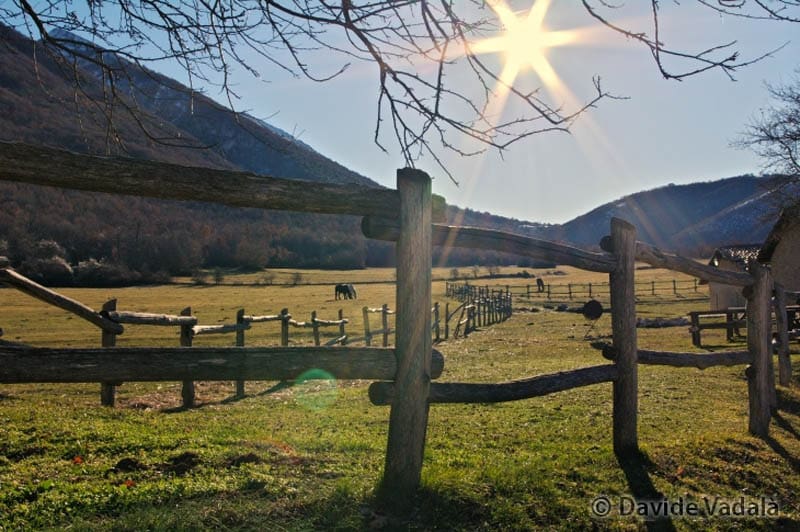
Literally, the “Lake of the Duchess”, Lago della Duchessa is a popular destination to go hiking not far outside of Rome.
It’s a mountain lake at an altitude of 1788 ( 5866 feet) meters above sea level, settled in a protected area that can be visited hiking during the warm season, or with snowshoes in winter. It’s an easy hike suitable also for not too experienced hikers.
Get the best vacation photographs with our Complete Travel Photography Gear Guide
6. Lago del Turano
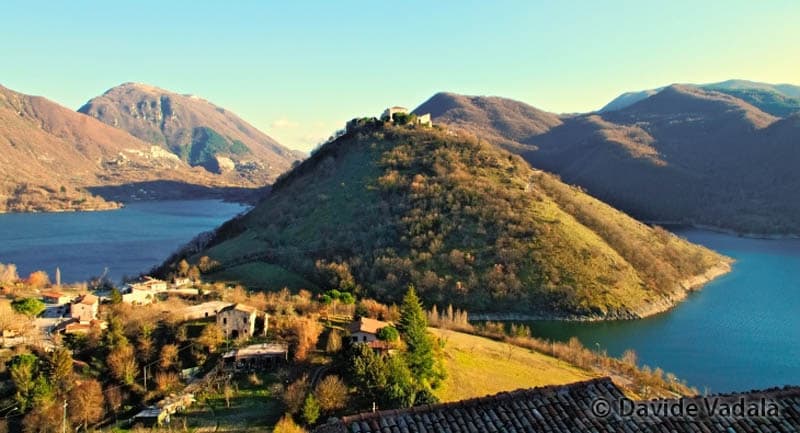
Lago del Turano is an artificial lake, built in 1939 as a reservoir for a hydroelectric plant. It’s a good destination for a summer day trip, sunbathing and relaxing on its shores. It’s a perfect choice for a lazy day.
A visit to the scenic villages of Castel di Tora and Colle di Tora is not to be missed. Get lost in the small alleyways and terraces until you find a beautiful view over the lake.
7. Ostia Antica
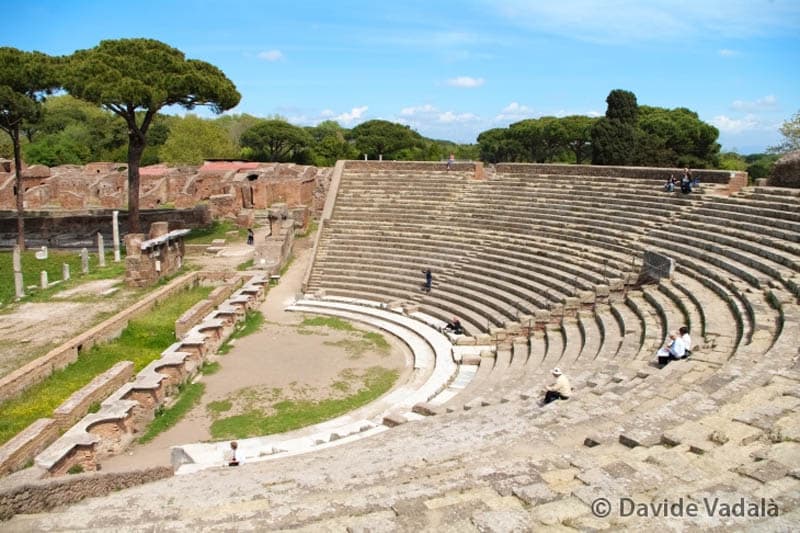
A smaller Pompei, but in the proximity of Rome, Ostia Antica was used as a seaport during Roman times. The first colony of the Roman Empire, it was an important commercial port center. During its biggest expansion, it had a population of 75 000 inhabitants.
Today it is located 3 km from the sea on the Tiber river. It’s very well preserved and it’s still possible to see many residences and public buildings. When you tour Ostia Antica, you’ll see thermal bath, amphitheater, gym, and the forum. I was most impressed with the beautiful mosaics decorating the floors of the city.
- Hot tip : walk looking at your feet!
- Italy is filled with UNESCO Sites check out the Complete Guide to UNESCO World Heritage Sites
8. Allumiere
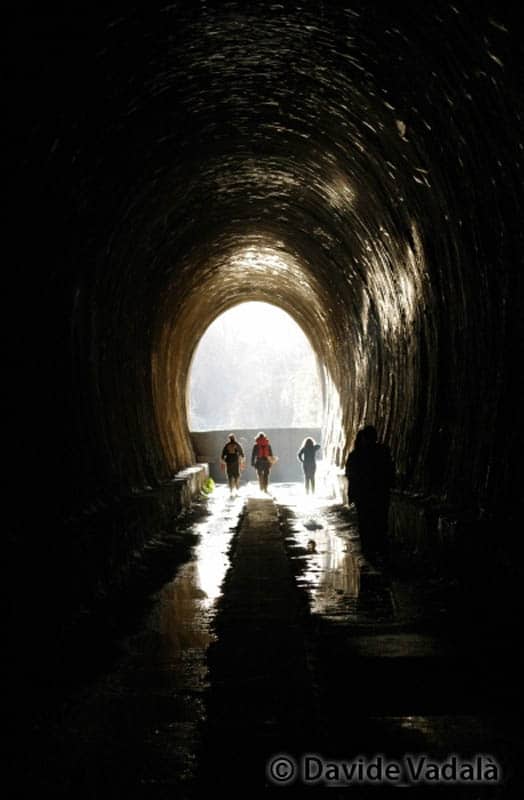
Allumiere takes its name from the potassium-alum extracted in the local mines. From here is an easy hike on a flat track following an abandoned railway that was blocked in 1961 by a landslide. The rails were never removed making it an easy hike. Just follow the rail.
It’s a good hike through nature taking you through abandoned train stations. You’ll pass through a tunnel with a peculiar micro-climate and fauna before walking over a big metal bridge. Being a flat route, it’s also a good option for cyclists, that can follow the whole abandoned railway track, that in this case is starting in Monteromano, and ending after about 50km in Civitavecchia.
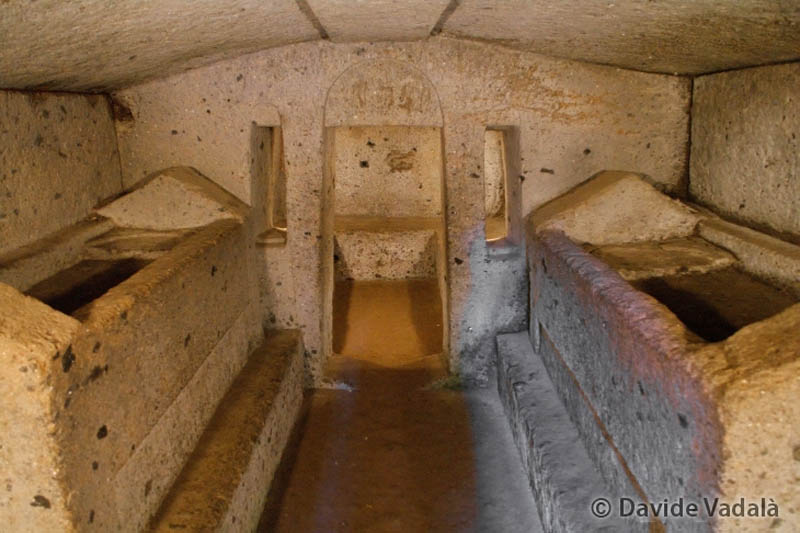
Even if in Rome everything is talking about the Roman Empire, there were populations established in the area way before the Roman Empire. One of the most important is the Etruscan civilization. It was active in the north of Latium and in the south of Tuscany .
In Cerveteri you must visit the UNESCO site of the Necropolis of the Banditaccia. This complex has more than 1000 tombs, dating back to the 9 th century BC. Many of the graves are mound shaped, and some burrow several stories underground.
The jewel of the Necropolis is the Tomb of the Reliefs, built in the 3rd century BC. Here you can peruse the interesting frescoes. A 3D video, that is part of the visit. It’s worth checking out to see a visual depiction of its history and the Etruscan population.
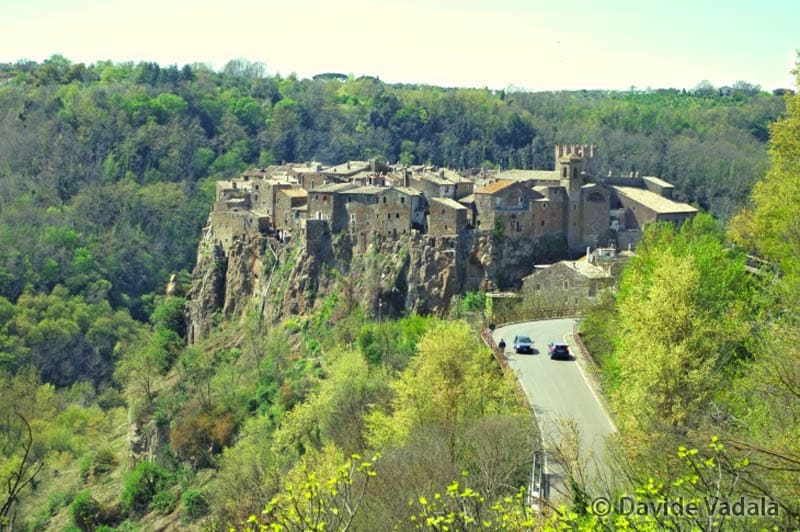
Calcata is one of my favorite places around Rome. Not only is it set in a scenic environment, standing over a cliff made of volcanic rock surrounded by green forests, but it houses a community of artists that took possession of the village.
Not long ago, this place was nearly abandoned because of stability issues and the risk of collapses. In 1960, some artists began to squat in the area and then began to buy and restore the properties in the historical center.
A visit to Calcata is all about the experience of getting lost in its winding streets and alleys and entering every single atelier. Nowadays the village is quite popular, some would say it’s “commercial.” So, if you want to experience the real spirit of Calcata, avoid the holidays when it’s packed with people.
Recommended Hotels in Rome
If you plan on just doing day trips from Rome, here are some hotel options for staying in Rome and visiting the cities mentioned above.
- Hotel Colosseum – Known for its rooftop bar overlooking the city and good location. Affordable with free breakfast and Wifi Check out Availability & Prices Trip Advisor / Booking.com
- Villa Spalletti Trivelli – Hotel Nacional is a beautiful old Historic Hotel. Minutes from downtown. A quick cab ride to Old Havana! Check out Availability & Prices Trip Advisor / Booking.com
- Where to Stay in Rome: The Best Ares and Neighborhoods
- 22 of The Best Things to do in Rome
- 3 Days in Rome: the Perfect itinerary
- Rome for Free: 20 Free and Cheap Rome Attractions
- Gladiator School in Rome
- The Ultimate One Day in Rome Itinerary: How To Maximize Your Visit
- Ancient Rome in Photos
Read all of our articles on Italy in our Italy Travel Guide
- 3 Days in Venice Itinerary
- The Best things to do on the Amalfi Coast
- 24 of the Best Things to do in Venice
- Top 10 Things to do in Florence
- The Leaning Tower of Pisa: Is it worth it?
- Hiking Cinque Terre: The 5 Villages Hike
Disclosure: There are some affiliate links in the post above, but these are all products we highly recommend. We won’t put anything on this page that we haven’t verified and/or personally used.
Travel Planning Resources
Looking to book your next trip? Why not use these resources that are tried and tested by yours truly.
Flights: Start planning your trip by finding the best flight deals on Skyscanner
Book your Hotel: Find the best prices on hotels with these two providers. If you are located in Europe use Booking.com and if you are anywhere else use TripAdvisor
Find Apartment Rentals: You will find the cheapest prices on apartment rentals with VRBO .
Travel Insurance: Don't leave home without it. Here is what we recommend:
- Allianz - Occasional Travelers.
- Medjet - Global air medical transport and travel security.
Need more help planning your trip? Make sure to check out our Resources Page where we highlight all the great companies that we trust when we are traveling.
You May Also Like
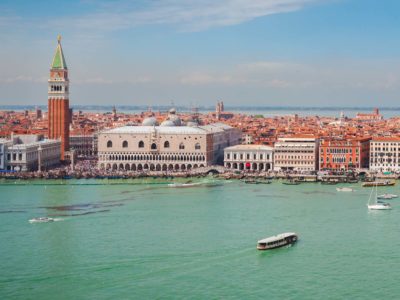
Where to Stay in Venice, Italy in 2024: 5 Best Areas for First-Time Visitors
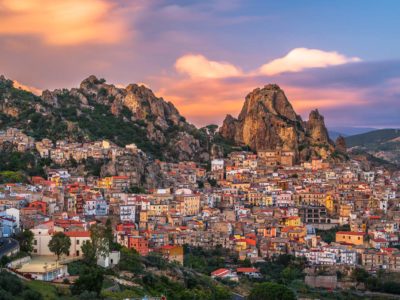
23 Best Things to Do In Sicily, Italy in 2024
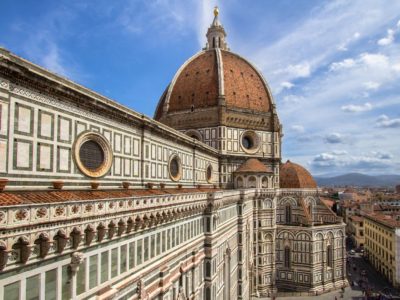
Best Florence In One Day Itinerary for 2024: How To See the Most In 24 Hours
About The Planet D
Dave Bouskill and Debra Corbeil are the owners and founders of The Planet D. After traveling to 115 countries, on all 7 continents over the past 13 years they have become one of the foremost experts in travel. Being recognized as top travel bloggers and influencers by the likes of Forbes Magazine , the Society of American Travel Writers and USA Today has allowed them to become leaders in their field.
Join thousands of others who get our monthly updates!
Leave a comment cancel reply.
Save my name, email, and website in this browser for the next time I comment.
31 thoughts on “Places to Visit Near Rome – 10 off The Beaten Path Destinations”
Tivoli Villa D’Este it’s amazing! I visited last year. Do you know some day trip tour from Rome to visit Calcata? Thank you for sharing.
Hi there! I am looking for an intimate setting for a wedding of just 15. Thoughts are of an intimate castle or villa where we can all stay for 3-5 days and have the wedding dinner there. We would love a lake setting. Do you have any recommendations?
Hello! I go to Rome every year and last year I discovered Frascati! It’s such an easy day trip from Rome and is famous for their slow-roasted pork or ‘porchetta’ and crisp, fresh white wine… We went on a food tour with The Old Frascati Wine Tour and really loved it! Buon Viaggio!
This is helpful! Taking my son to Rome in mid march. Weather for hiking? Considering cinqu terre. We don’t have much time do you think we should just stay closer to Rome and do some side trips?
We have 3-1/2 days in Rome. Is it worth it to take a high speed train to visit Pompeii for one of those days?
That depends on how much you want to see Pompeii. I always say that if there is something you really have your heart set on seeing, you should make the trip. You don’t want to go there and miss your once in a lifetime opportunity. You could do 2 days in Rome taking tours and sightseeing and then head over to Pompeii for the day. That said, Dave and I were just doing a road trip from the Amalfi Coast this past summer and drove to Pompeii. When we got there, we were turned off by the crowds and decided to move on. However, a very important note for me to add is that it hasn’t been my dream to see Pompeii. If I had my heart set on it, I would have made sure to go in no matter what. So, I guess I am not the biggest help here, but I say, if you want to see it, you should. I haven’t taken the high speed train, but if you can get there in back in a day, I think you should.
Yes. I recommend it. Very beautiful. Go early morning so you have more time there. Make sure you stay hydrated.
Calcata was a disappointment. Visited in June and it was very quiet and much smaller than expected. Be ware that the car park is a long hilly hot walk from the village which was deserted when we were there. Didn’t think it was worth the long journey. Tivoli Villa D’Este was lovely.
Have you read the story? Until a couple of years ago it was completely abandoned! So yeah it is quiet and small. Next time go to milano so you are not disappointed! If you knew a big more about its history maybe you would not have gone there with expectations of a modern metropolitan city.
Thank you so much Davide, this is just perfect. I have been to Rome 6 times now and am looking for more obscure day trips and hiking for my next visit. I will be there 24 Dec 17 to 6 Jan 18, so I will come well prepared but some of those hikes look excellent.
You should visit Tuscia, Viterbo province. It’s an amazing territory between Rome and Tuscany
Nice list! I thought there was already plenty of stuff to do within Rome, but seems like there’re much more to do around it. The carpet of flowers at the Infiorata di Genzano looks amazing! Thanks for sharing.
Any advice on how to get to Castel di Tora/ Lago del Turano via public transport from Rome ?
I’m there for 2 weeks and would love to see it.. D:
Many thanks, Mike.
We were in Rome last month. visited Calacata on a Sunday, very disappointed, smelt of cats (loads of them, plus excrement), quite a few visitors eating on the steps around, but felt most unwelcome as if the locals didn't approve of the visitors. Definitely needs a clean up and a more welcoming approach. loved Tivoli and Ostia Antica, highly recommend a look at both.
Thanks for the update Suzanne. Always good to know how places are as things can change quickly in the world of travel.
These are really Great places in Rome . Great Images and Good mixture of the story.Thanks for the tip because we hope to travel there next year. It’s good you walked away – I’m sure many more less seasoned travellers get caught into scams like these!
Great places that definitely deserve more attention. I was in Rome just recently and only know about 3 of these places. Unfortunately I only managed to get to one of them in my week there – Ostia Antica. Loved it!
I would also add the Frascati region to your list. It is full of vineyards and cute old wineries.
You are welcome to visit my blog for more information about my trip: http://www.travel-pb.com/search/label/Rome
Yes the Region of Frascati, called “Castelli” is very popular in particular to go and eat local food!
Amazing. I love Rome and have been there twice, but I haven’t seen these places. This gives me more to see when I go back! I can’t get enough of that city.
Really interesting post guys! Looking at a trip to Italy in the near future so very useful!
Oh its great to read your post. feel me like i was in Rome.
Great list indeed. I’d really like to go there when the Infiorata di Genzano is happening just to see those beautiful flower carpets.
Fabulous photos. I want to go to Rome, now! I’ve been before but only on a short trip and just took in the sights of the city, but now I’ll have to go back to explore some more!
I want to see them all! But if I only have time for one it’s going to be Villa d’Este. It looks magical!
We want to see them all too. Now we have a reason to go back to Rome, not to see it again, but to visit all these amazing places!
I think Tivoli in another country would be a top destination with Villa Adriana – Villa D’Este – Villa Gregoriana Thermal Baths. Unlucky it is so close to Rome!
Thanks for the advice. We are in Italy on our road trip so we need some spots to stop.
I really like the look of Calcata.
There are plenty of nice villages, google also for Civita di Bagnoregio!
Ostia Antica is a great choice. It’s like going to Pompeii but so close to Rome. I never heard of some of the others so I will have to check them out.
Also Villa Adriana (still in Tivoli) it’s a good alternative if you can’t make it to Pompei!
Ahh new theme. Looks good.

Passing Thru Travel
Discover Rome – A Comprehensive 12-Step Traveler’s Guide
Posted: February 28, 2024 | Last updated: February 28, 2024
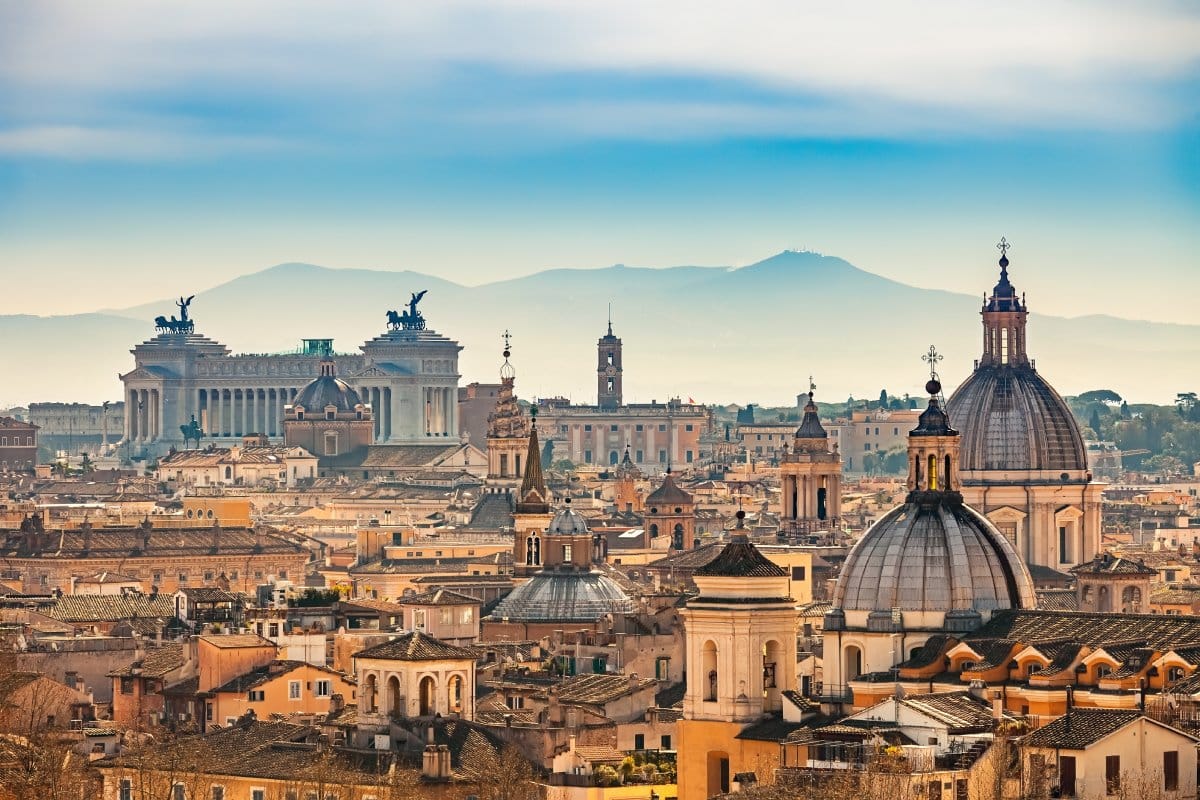
Rome, where history and modernity intertwine seamlessly, offers an unparalleled journey through time. Known as the Eternal City, Rome is a living museum boasting ancient ruins, Renaissance art, and vibrant street life. This guide will navigate you through Rome’s most iconic landmarks and hidden gems, ensuring a well-rounded experience of this timeless city. From the grandeur of the Colosseum to the charm of Trastevere’s narrow streets, get ready to explore the depths of Rome’s rich history and culture.

1. The Colosseum
The Colosseum, an enduring symbol of ancient Roman engineering and architecture, is a must-visit. Once the arena for gladiator battles, it now stands as a monument to Rome’s imperial past. Exploring the Colosseum, you can almost hear the roaring crowds’ echoes and gladiator swords’ clashing. Its massive structure and complex history make it a fascinating site for history enthusiasts and casual visitors.
Insider’s Tip: Purchase a combined ticket with entry to the Roman Forum and Palatine Hill to make the most of your visit.
How To Get There: The Colosseum is conveniently accessible via the Colosseo metro station.
Best Time To Travel: Visit during the off-peak seasons, in early spring or late fall, to avoid the crowds and extreme heat.
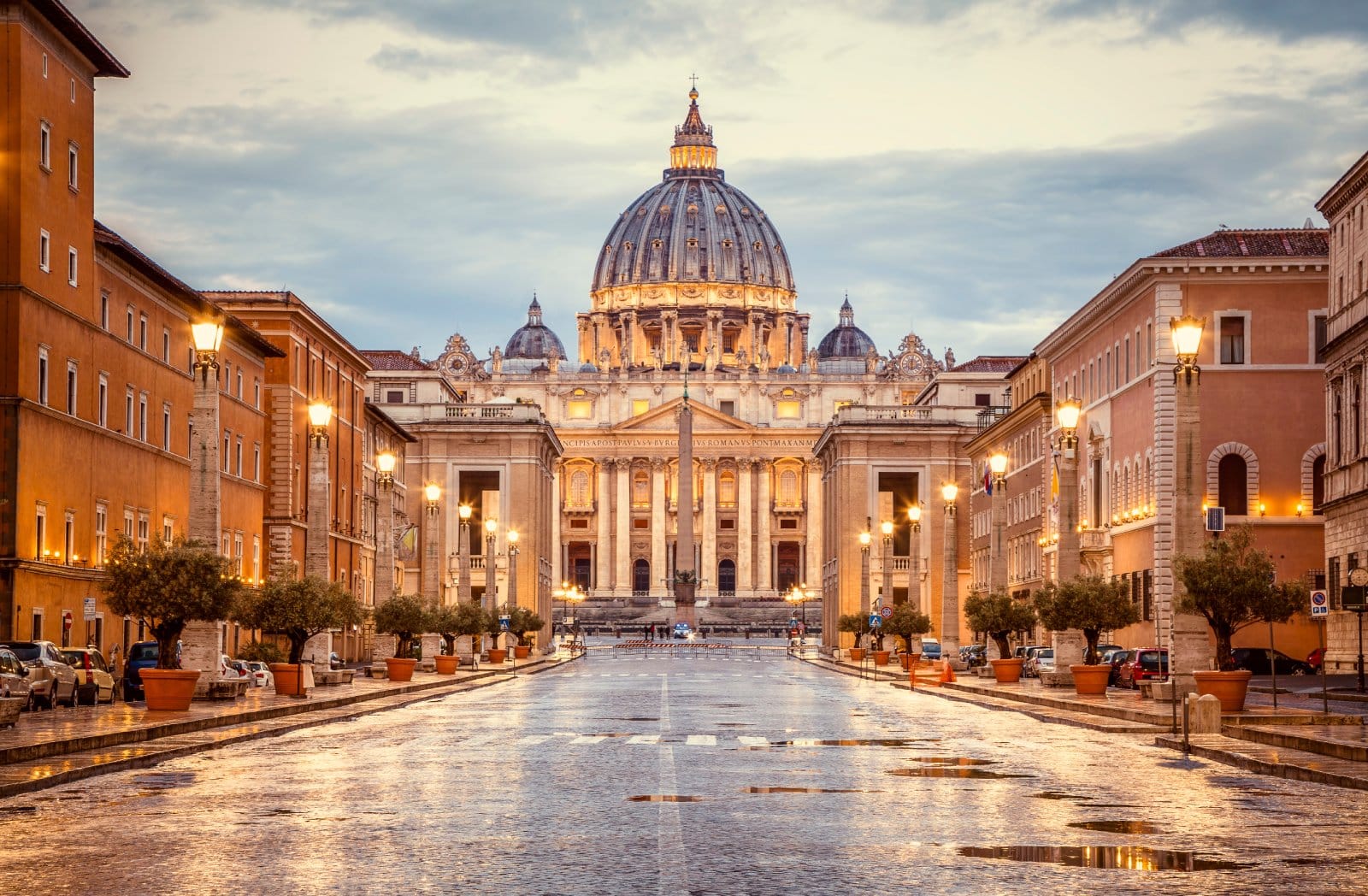
2. Vatican City
Vatican City, the heart of the Catholic world, is a sovereign state within Rome. Home to the Pope, the Vatican is also a treasure trove of artistic and cultural riches. The Vatican Museums house a vast collection of art and historical pieces, including the Sistine Chapel with Michelangelo’s famous ceiling. St. Peter’s Basilica, with its impressive dome designed by Michelangelo, is an architectural masterpiece offering panoramic views of Rome from its summit.
Insider’s Tip: Reserve a guided tour for early morning to access the Sistine Chapel before it opens to the general public.
How To Get There: Reach Vatican City via the Ottaviano metro station, followed by a short walk.
Best Time To Travel: Visit during the winter months to avoid long lines and crowded spaces.
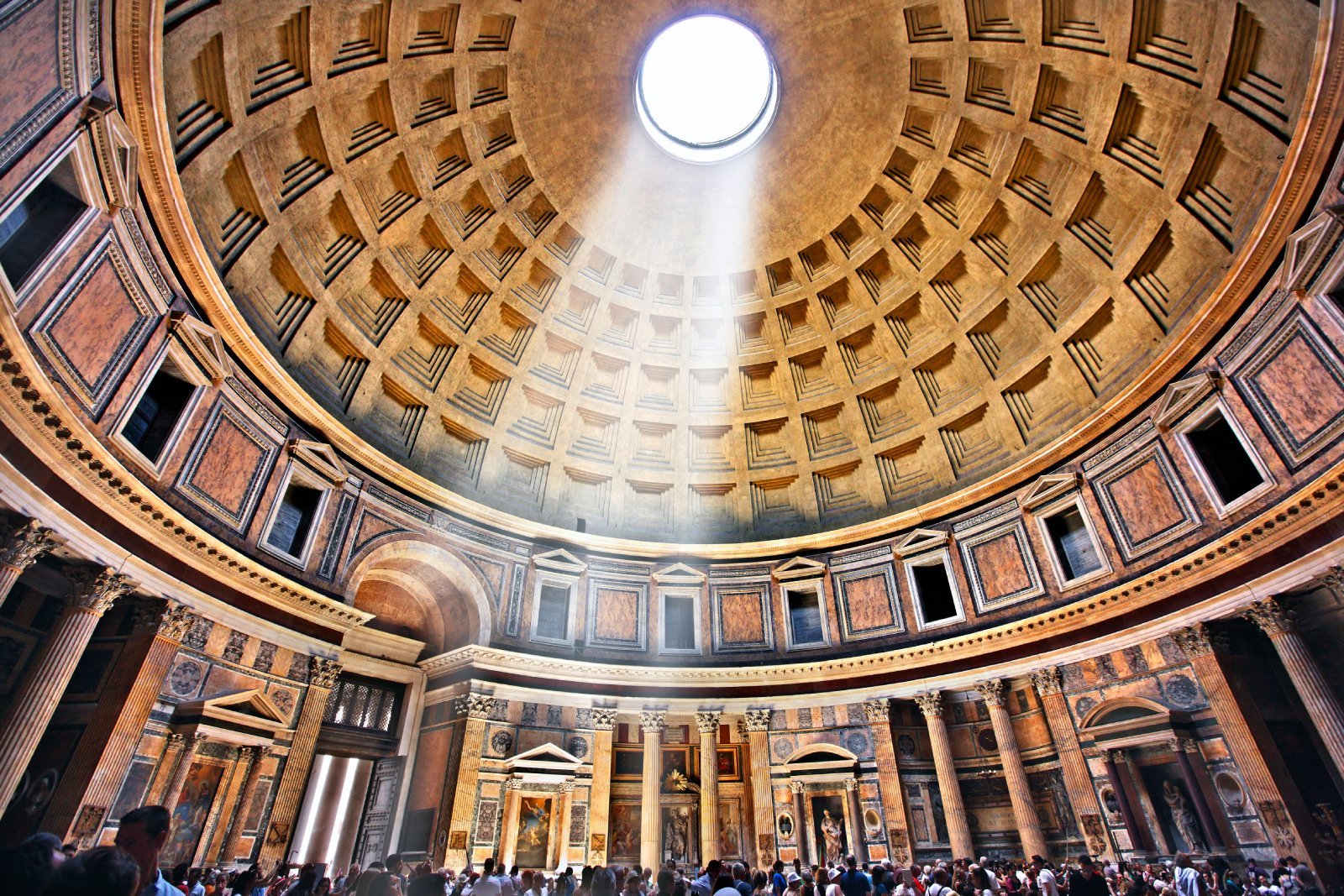
3. The Pantheon
The Pantheon, an impressive feat of ancient Roman architecture, is known for its perfectly proportioned dome, the largest unreinforced concrete dome in the world. Originally built as a temple to all gods, it now serves as a church and a tomb for notable figures, including the artist Raphael. The building’s harmonious proportions and the oculus, a circular opening at the dome’s apex, create a unique and awe-inspiring interior atmosphere.
Insider’s Tip: Visit on a rainy day to see the captivating sight of rain falling through the oculus and evaporating before it hits the ground.
How To Get There: The Pantheon is centrally located and best reached by foot from other nearby attractions like Piazza Navona.
Best Time To Travel: Early mornings or late afternoons are less crowded, offering a more serene experience.
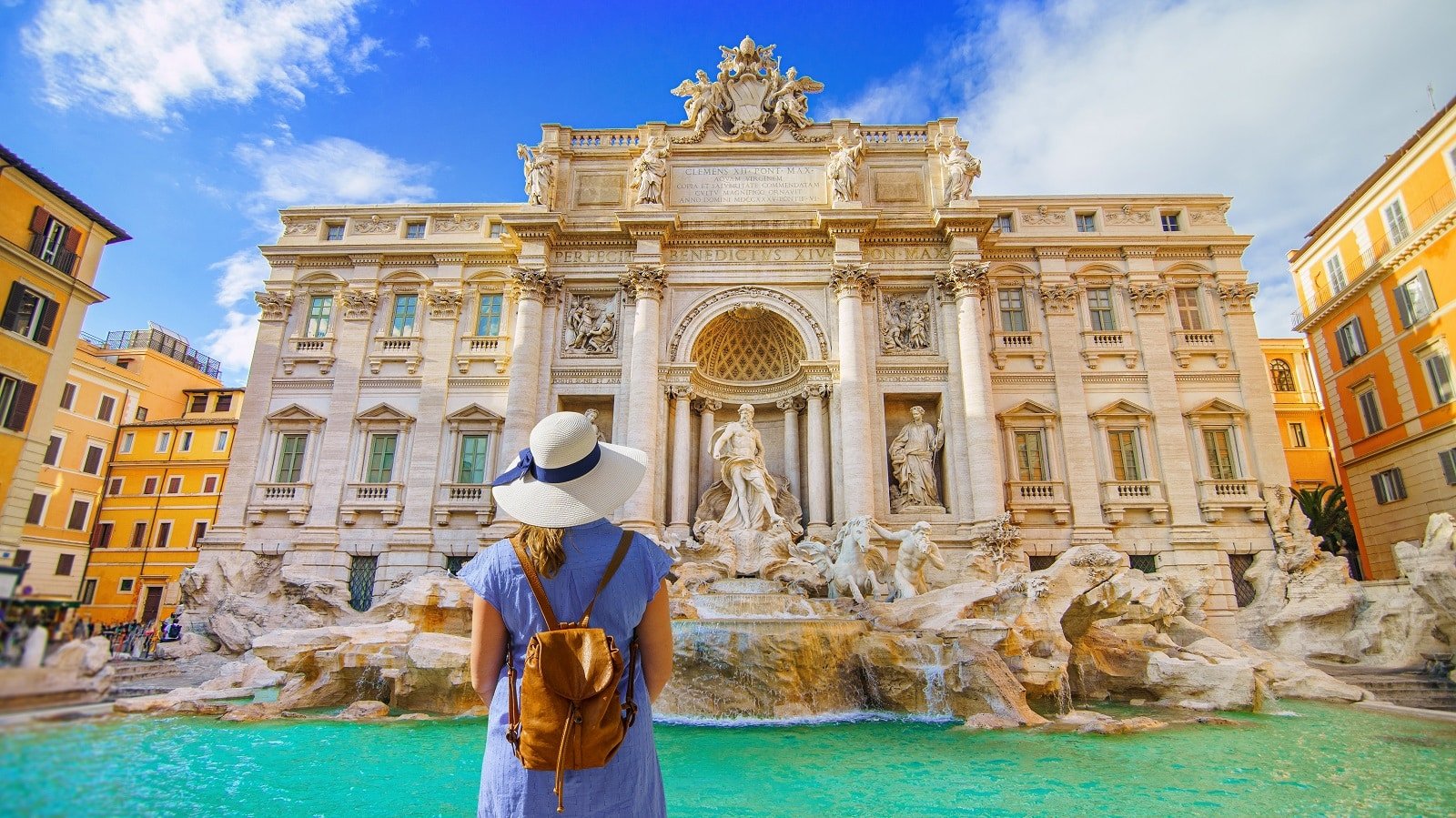
4. Trevi Fountain
The Trevi Fountain, an iconic baroque masterpiece, is not only a visual spectacle but also a testament to Rome’s historical relationship with water. The fountain, featuring the god Oceanus, stands at the end of the Aqua Virgo aqueduct and is one of the oldest water sources in Rome. According to legend, throwing a coin over your shoulder into the fountain ensures a return to Rome.
Insider’s Tip: Visit the fountain at night when it’s beautifully illuminated and less crowded.
How To Get There: The Trevi Fountain is within walking distance from the Barberini metro station.
Best Time To Travel: Early morning or late evening visits allow you to appreciate the fountain’s beauty without the crowds.
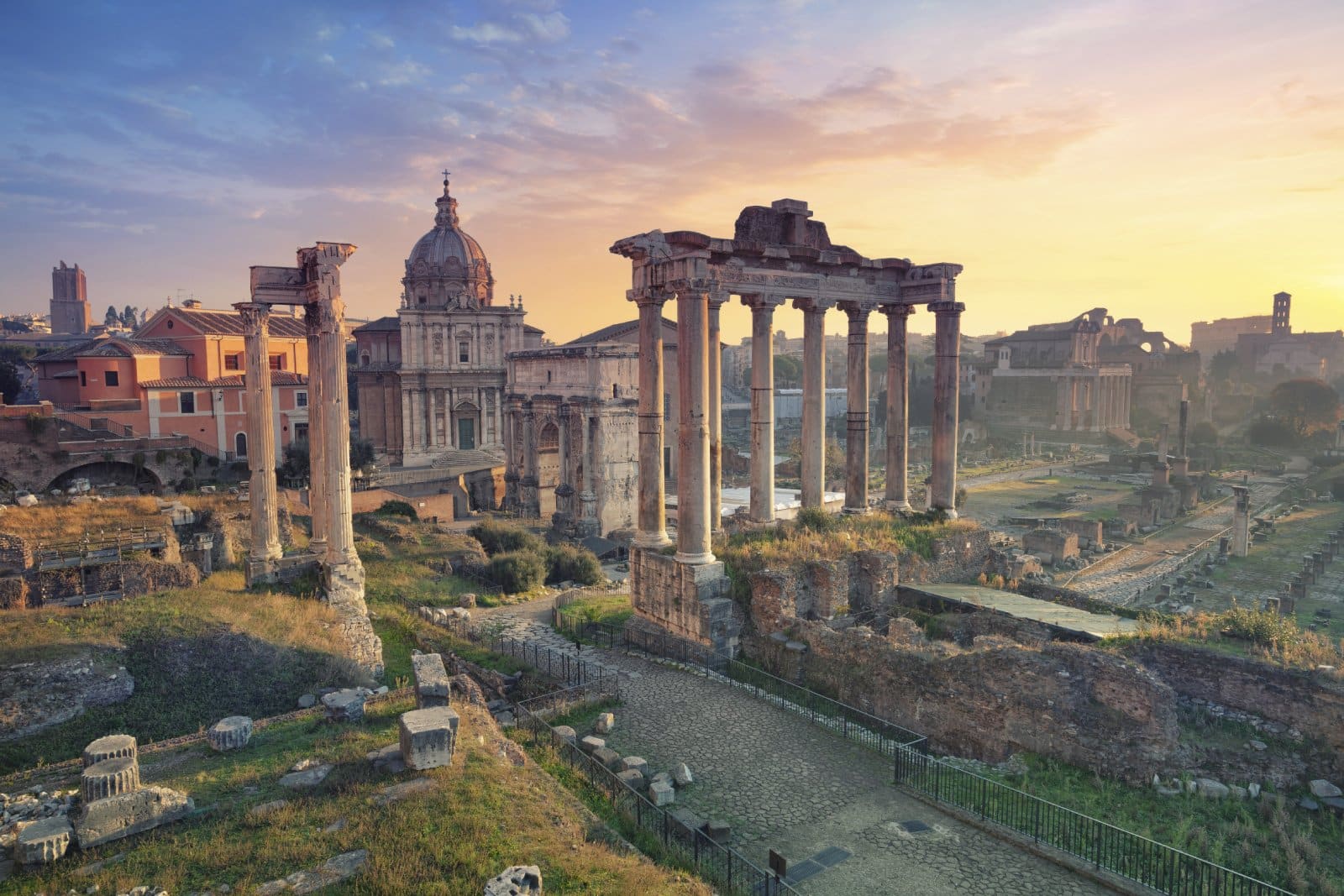
5. Roman Forum
Once the center of public and political life in ancient Rome, the Roman Forum is a sprawling complex of ruins. Walking through the Forum, you’re tracing the steps of Roman emperors and citizens amidst temples, arches, and government buildings that once defined the city’s daily life. The site offers a profound sense of history, as each ruin has its own story, contributing to the narrative of Rome’s glorious past. The Forum appeals to history buffs and anyone seeking to understand the depth of Rome’s historical significance.
Insider’s Tip: Climb the Palatine Hill for a panoramic view of the entire Forum area.
How To Get There: The Roman Forum is close to the Colosseum and can be accessed easily from the Colosseo metro station.
Best Time To Travel: Visit early in the morning to avoid the heat and crowds, especially in summer.
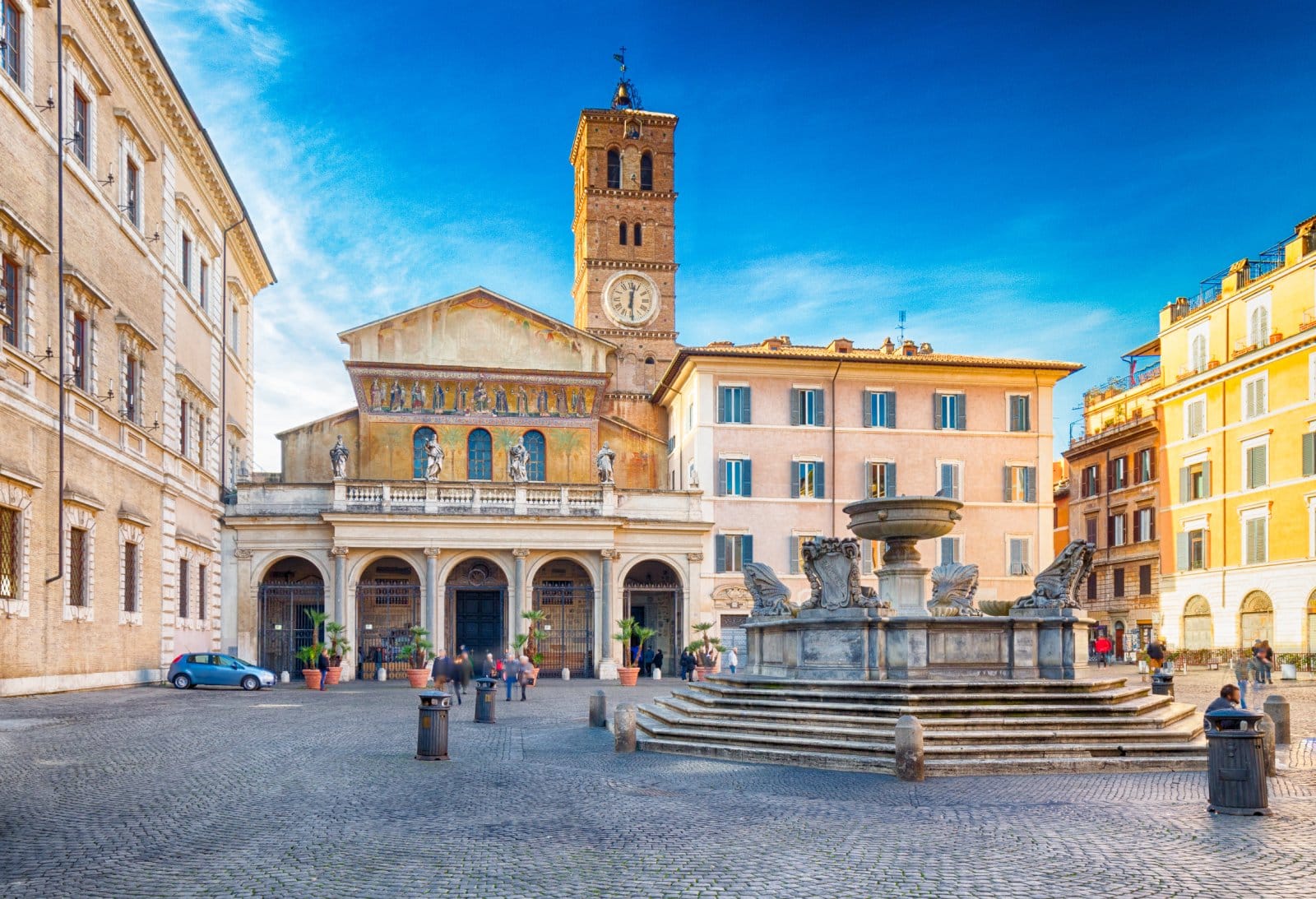
6. Trastevere
Trastevere, known for its narrow cobblestone streets and medieval charm, offers a glimpse into the more traditional side of Rome. This vibrant neighborhood, with its ivy-clad buildings, artisan shops, and trattorias, has a unique character and laid-back atmosphere. Walking through Trastevere, you’ll find hidden piazzas, historic churches, and local markets, each adding to the area’s enchanting appeal. It’s an ideal place to enjoy authentic Roman cuisine and experience the city’s lively nightlife.
Insider’s Tip: Dine at a local trattoria for a traditional Roman meal away from the tourist-heavy areas.
How To Get There: Trastevere is easily accessible by bus or tram, but exploring on foot from the city center offers a more immersive experience.
Best Time To Travel
Evening time is perfect for experiencing Trastevere’s lively atmosphere, while daytime offers a quieter exploration of the neighborhood.
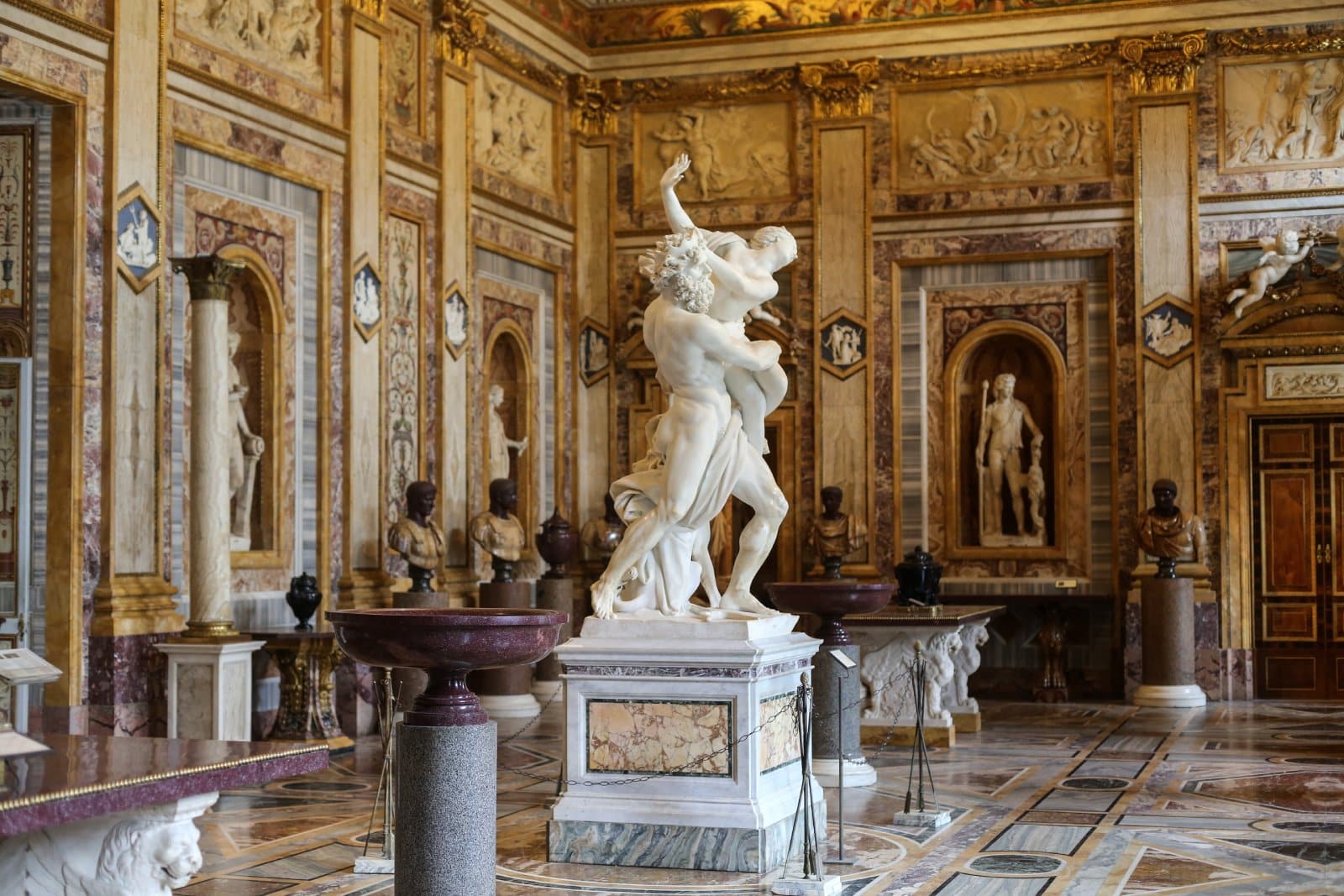
7. Galleria Borghese
The Galleria Borghese is one of Rome’s most remarkable art galleries, housing a substantial collection of sculptures and paintings. Located in the lush Borghese Park, the gallery includes masterpieces by artists such as Bernini, Caravaggio, and Raphael. The villa is an architectural sensation, and the surrounding gardens provide a peaceful retreat from the city’s hustle and bustle.
Insider’s Tip: Booking tickets in advance is essential, as the gallery limits the number of visitors to preserve the tranquil atmosphere.
How To Get There: The gallery is located in the Borghese Park, reachable by bus or a pleasant walk through the park from the city center.
Best Time To Travel: Weekday visits usually mean fewer visitors, providing a more intimate viewing experience.

8. Campo de’ Fiori Market
Campo de’ Fiori is a bustling marketplace by day and a lively social square by night. The market offers a range of fresh produce, flowers, spices, and Italian specialties, making it a colorful and sensory experience. Exploring the market, you’ll find everything from local cheeses and cured meats to artisanal pastas and oils. It’s not just a place for shopping; it’s a vibrant part of Roman life where locals and tourists mingle.
Insider’s Tip: Visit early in the morning to see the most lively market and get the best selection of fresh produce.
How To Get There: Campo de’ Fiori is centrally located and within walking distance from many major sites, including Piazza Navona.
Best Time To Travel: The market operates every morning except Sundays.
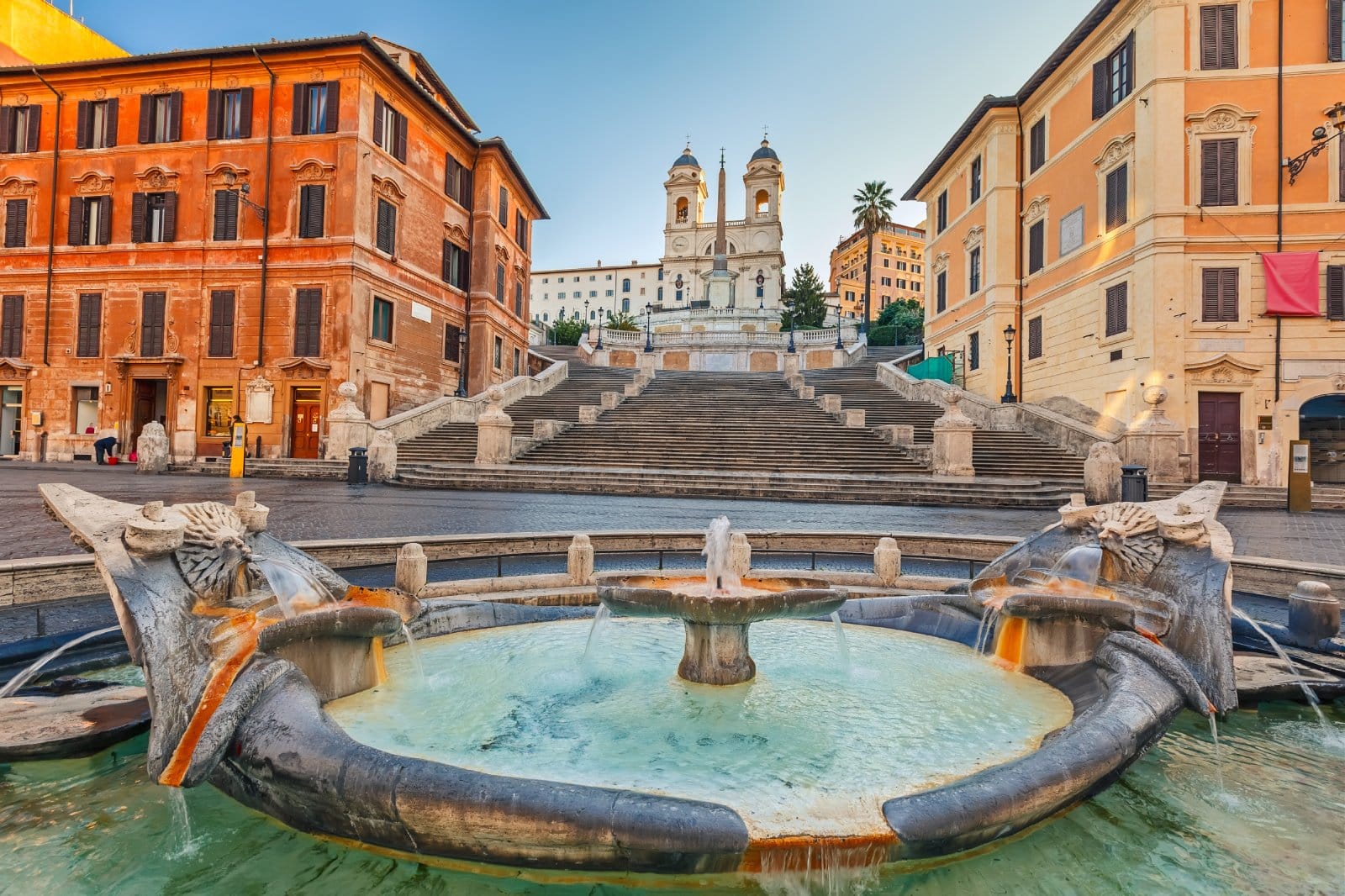
9. Spanish Steps
The Spanish Steps, an architectural and cultural icon of Rome, connect the Piazza di Spagna at the base with the Piazza Trinità dei Monti at the top. Climbing the steps offers a delightful view of the city’s rooftops. It is a popular spot for locals and tourists to gather. The steps are not just a passageway but a place to pause, enjoy the atmosphere, and people-watch.
Insider’s Tip: Visit during spring when the steps are adorned with beautiful flowers, enhancing their iconic charm.
How To Get There: The Spanish Steps are a short walk from the Spagna metro station, easily accessible from various parts of the city.
Best Time To Travel: Early mornings or late evenings offer a more peaceful experience, as the steps can be crowded during the day.
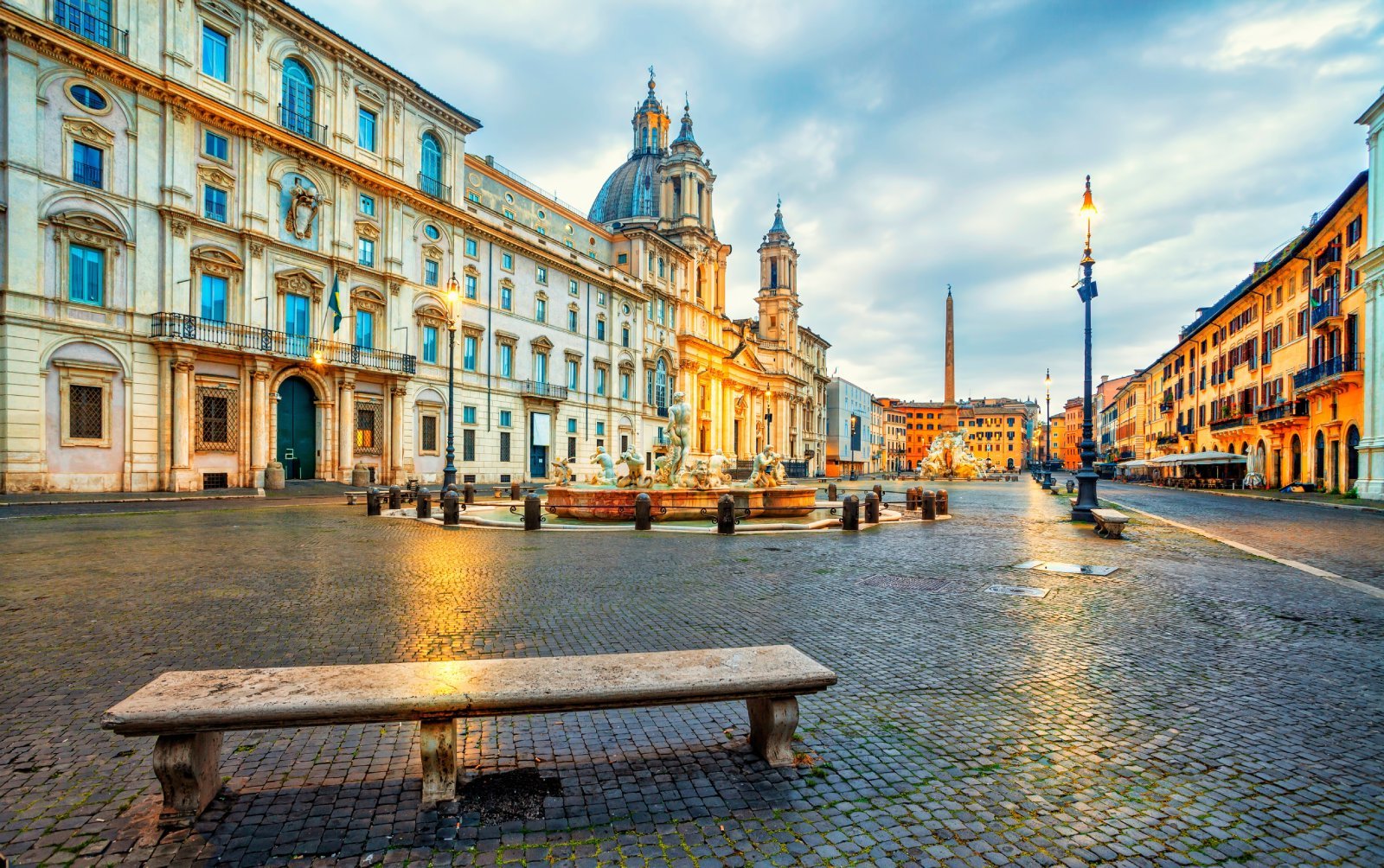
10. Piazza Navona
With its stunning Baroque architecture, Piazza Navona is one of Rome’s most famous squares. Once a Roman stadium, the piazza is lined with restaurants, gelaterias, and bustling cafes today. Its centerpiece is the Fountain of the Four Rivers, designed by Bernini, representing the world’s major rivers across four continents. The square is a feast for the eyes and a hub of artistic and cultural activity, often hosting street artists, painters, and musicians.
Insider’s Tip: Enjoy a coffee or aperitivo at one of the cafes surrounding the piazza for prime people-watching and a view of the fountains.
How To Get There: Piazza Navona is centrally located and best reached on foot from other nearby attractions in the city center.
Best Time To Travel: Visit in the late afternoon or early evening to enjoy the lively atmosphere and beautiful lighting.
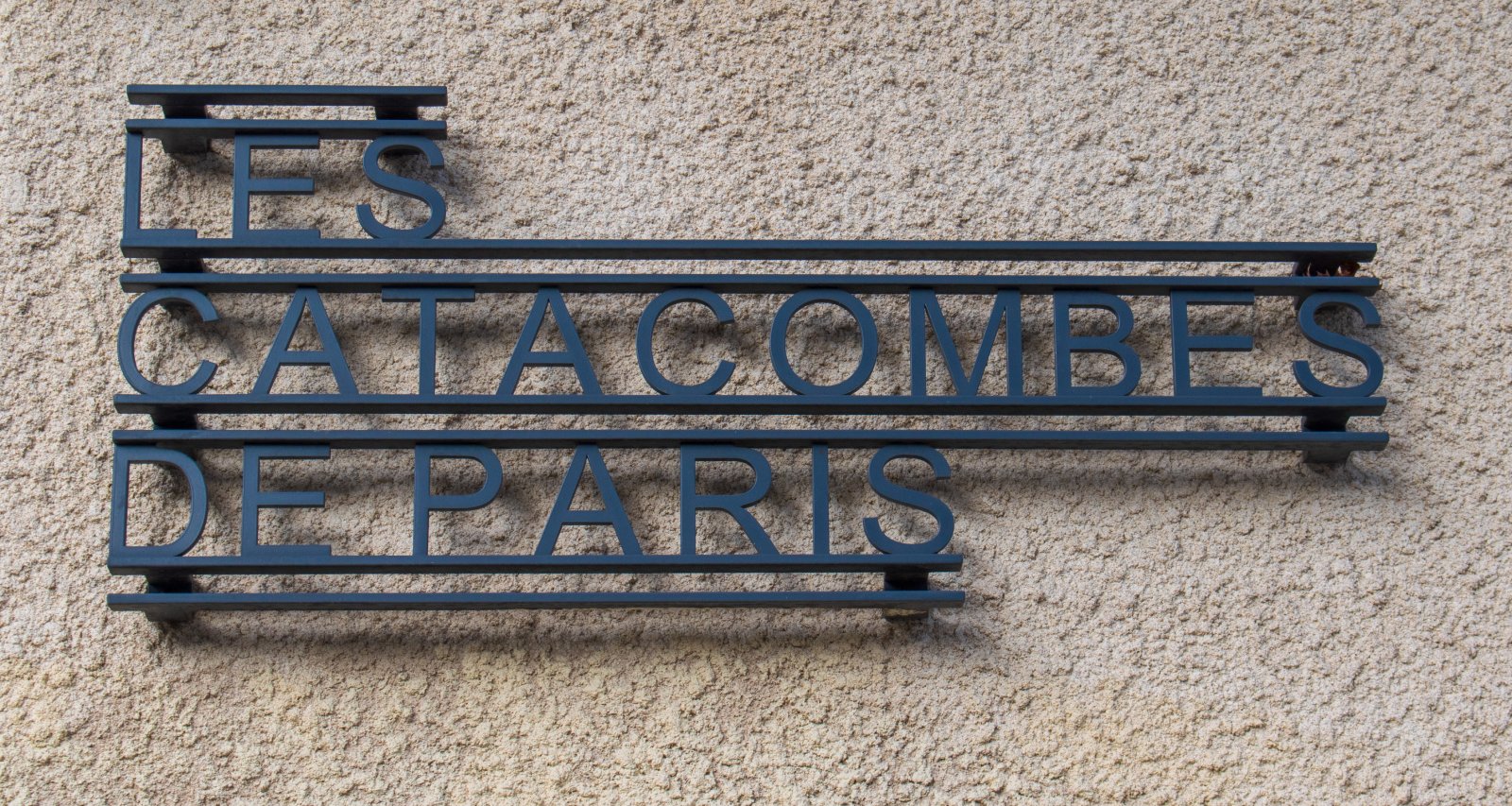
11. The Catacombs
Rome’s catacombs are ancient underground burial places that offer a unique glimpse into early Christian history and burial practices. The Catacombs of San Callisto and San Sebastiano are among the most visited, featuring miles of underground passageways and tombs. A guided tour of the catacombs provides insight into the fascinating and somewhat eerie world beneath Rome’s streets.
Insider’s Tip: Wear comfortable shoes as the tours involve walking through narrow and sometimes uneven passageways.
How To Get There: The catacombs are located outside the city center, accessible by bus or a combination of metro and bus.
Best Time To Travel: The catacombs maintain a cool temperature year-round, making them a good visit any time, but they are less crowded during the off-peak seasons.
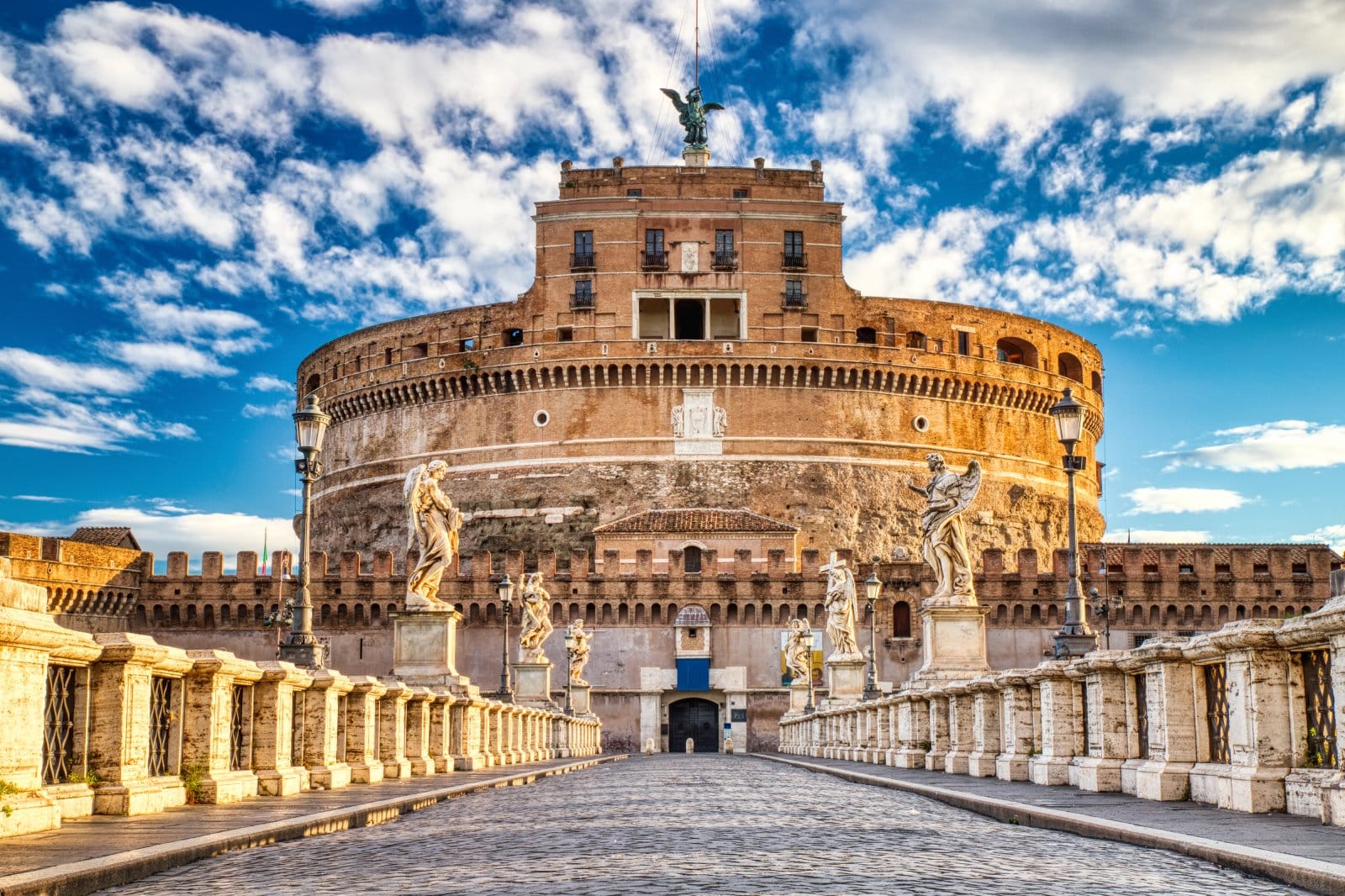
12. Castel Sant’Angelo
Castel Sant’Angelo, initially built as a mausoleum for Emperor Hadrian, has served various roles throughout history, including a fortress, a papal residence, and now a museum. The castle offers a rich history to explore, along with stunning views of the city and the Tiber River from its terrace. The bridge leading to the castle, Ponte Sant’Angelo, is adorned with beautiful angel statues and provides a picturesque approach to the fortress.
Insider’s Tip: Visit in the late afternoon to experience the sunset from the castle’s terrace, offering one of the best views in Rome.
How To Get There: The castle is within walking distance from Vatican City and is easily accessible by foot or public transport.
Best Time To Travel: Early morning or late afternoon visits are recommended to avoid crowds and to enjoy the view in the best light.
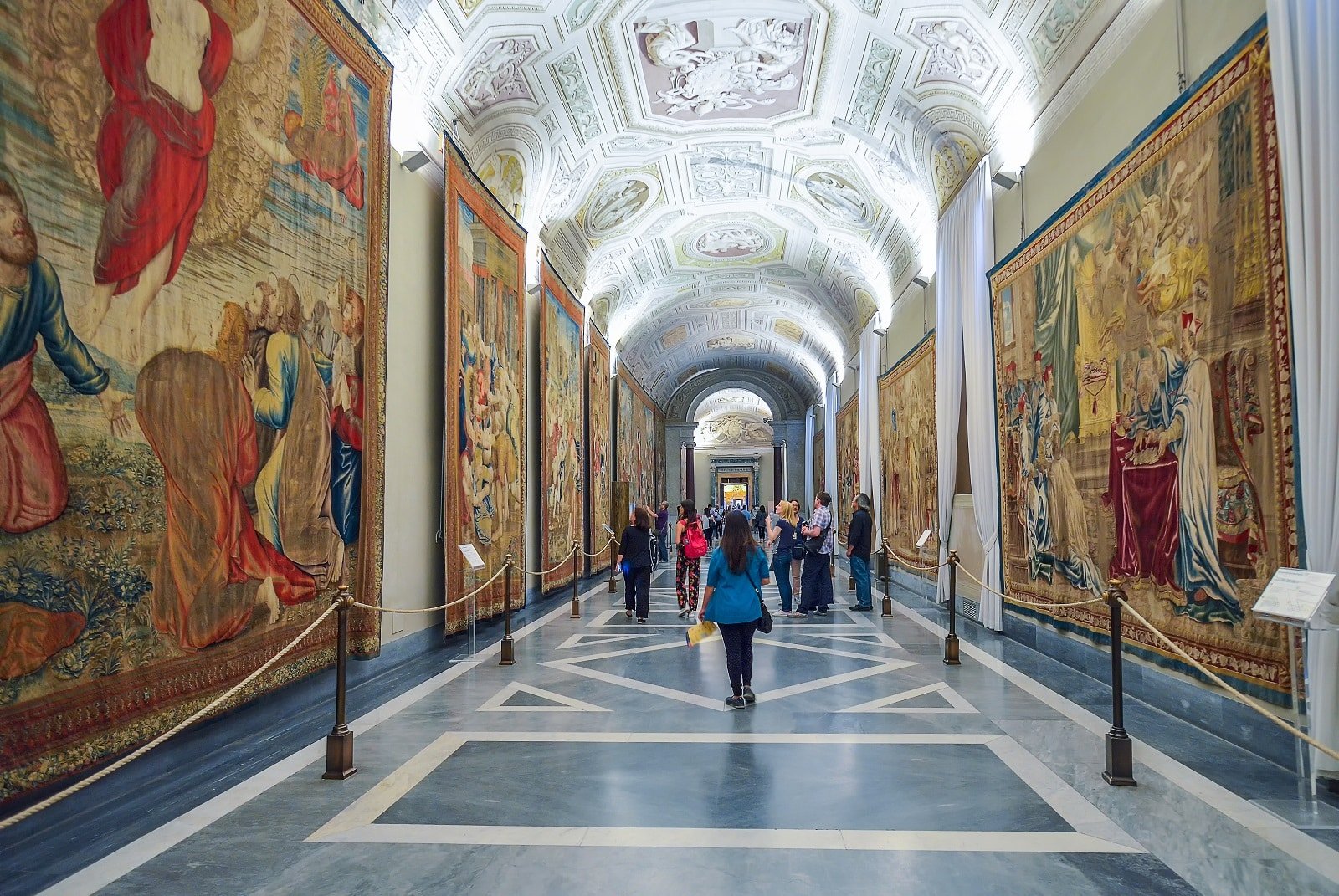
The Bottom Line
Rome is not just a city; it’s a living museum, a testament to the grandeur of human civilization. Each cobblestone street, ancient ruin, and magnificent artwork tells a story of a past era, inviting you to be a part of its ongoing narrative. As you wander through Rome, remember that you’re walking in the footsteps of emperors, artists, poets, and philosophers.
Your journey through this eternal city is an exploration into the heart of human history and creativity. Embrace each moment, savor each experience, and let Rome’s timeless beauty inspire and enchant you. Buon viaggio!
More Articles Like This…
Barcelona: Discover the Top 10 Beach Clubs
2024 Global City Travel Guide – Your Passport to the World’s Top Destination Cities
Exploring Khao Yai 2024 – A Hidden Gem of Thailand
The post Discover Rome – A Comprehensive 12-Step Traveler’s Guide republished on Passing Thru with permission from The Green Voyage .
Featured Image Credit: Shutterstock / S.Borisov.
For transparency, this content was partly developed with AI assistance and carefully curated by an experienced editor to be informative and ensure accuracy.
More for You
A 20-year LeBron James NBA Playoffs streak is over
The Simpsons Kills Off Longtime Character After 34 Years
Peyton Manning takes aim at Jets over Zach Wilson's failed tenure: 'It drives me crazy'
We Ordered 7 Fast-Food Breakfast Sandwiches to Find the Best One
15 High-Maintenance Luxury Cars That Will Drain Your Wallet
Scientists have discovered the maximum age a human can live to
3 lies women have been told about their bodies, according to a female doctor
Taylor Swift just dropped her newest video, ‘Fortnight,’ with Post Malone
Remove A Tree Stump With One Common Household Ingredient
Should you leave your laptop plugged in all the time?
Lakers News: Anthony Davis Appears To Point Blame in Tenth Consecutive Nuggets Loss
The best pizza place in 25 major US cities
The Factory Turbocharged Car With The Most Horsepower In 2024
Age at which you're officially old has changed
The Latest | Ex-publisher in hush money trial recalls Trump as 'very upset'
If You See Black Residue on Your Cast-Iron Skillet, This Is What It Means
Taco Bell brings back beloved menu item for limited time only
A viral essay about marriage spawned thousands of hate clicks — and exposed a harsh reality
Jayson Tatum Sums Up Celtics Loss To Heat With Blunt Remark
This type of supplement may increase heart disease risk, new study finds
35 Amazing Day Trips from Rome – Best Places to Visit nearby

- 56 Pinterest
Are you looking for the best day trips from Rome? Some cool places to visit for a day out of the city? You are in the right place! Beyond Rome lies a wealth of options for day trips and excursions. Some of the most rewarding tourist destinations can be reached within an hour, either by car, bus, or train.
Whether heading north or south from Italy’s capital, there’s plenty to see and do on a day excursion from Rome. From beautiful beaches to stunning monuments, vineyards to picturesque villages, discover 35 amazing places to visit from Rome – an eclectic mix of day tours out of Rome to meet every budget!
1 – Pompeii

Step into a time machine and take a trip back into the past to the ancient city of Pompeii. Explore the majestic homes as well as modest ones that have been perfectly restored and preserved or visit Roman shops that were once frequented by Pompeii’s citizens. In other parts of Pompeii, baths and brothels stand ready for exploration, while the Villa of Mysteries offers a bizarre experience with frescoes that have confused scholars for many years. Join in on the debate and try to interpret the preserved frescoes or walk through the ancient streets of the city to spot graffiti that can still be seen to this day on some of the city’s walls.
- Day tours from Rome to Pompeii
See also: The best Pompeii tours from Rome provide an immersive experience, revealing the rich history and culture of this iconic site.
2 – Naples

Naples is the gateway city to Mount Vesuvius and Pompeii and in actual fact, you can visit both places in one day. A city full of history and attractions to visit such as Castel Naples and National Archeological Museum. Also famous for being one of the most famous Italian city for pizza so you might be interested to join a food tour around Naples to get to know their cuisine. You won’t be disappointed.
- Excursions to Naples from Rome
3 – Mount Vesuvius

Depart for an extraordinary tour and h ead to the peak of Mount Vesuvius, one of Italy’s most popular tourist attractions. Discover the bay of Naples from another perspective with your volcanologist guide.
- Day trips from Rome to Vesuvius
4 – Caserta Royal Palace

Referred to as an Italian Versailles, this Royal Palace in Caserta is the largest in the world (UNESCO World Heritage). This royal palace has five floors, 1200 rooms, 34 stairs and 1742 windows. All its decoration, tapestry and frescoes are breathtaking. Make sure you book a guided tour if you decide to visit Casera Royal Palace for the day so you get a comprehensive guide of its history. If you are travelling there by train or car, you can book your tickets in advance to avoid the queue.
- Compare day trips to Caserta Royal Palace
5 – Venice

Experience one of the most romantic cities in the world. Heavily touristy but with fascinating architecture, canals to wander around on a gondola and stroll around the labyrinth of cobblestone streets, as well as its world-class museums. If you’re in Rome and want to travel to Venice you may want to travel there on a speed train to save up time. From Venice, you can visit some of the islands on a ferry like Burano, Murano, Torcello.

The main attraction in Venice Saint Mark’s Cathedrals Archdiocese of Venice is one of the most famous churches and one of the best-known examples of Italo-Byzantine architecture.
- Day tours out of Rome to Venice
6 – Calcata

Perched atop a rocky mountain, Calcata is one of the most beautiful and unique villages just 30 km from the city of Rome. Calcata makes an ideal excursion from Rome for those who are looking for something different to do whilst in Rome. Its bohemian atmosphere and medieval architecture are definitely enchanting.
7 – Monte Cassino

Famous for its monastery built by Saint Benedict in 529 for himself and the monks from Subiaco. Just a 2-hour drive from Rome, Montecassino Abbey has a lot of history to learn about. From when it was destroyed by the Langoboards and again during the wartime; to understand fully how much its monastery suffered, you can combine your day trip out of Rome with a tour of WWII battlefields in the Montecassino area.
Day Trips from Rome to Amalfi Coast

Fall in love with one of Italy’s most beautiful coasts on a day trip from Rome, where you will explore the enchanting town of Amalfi. Their beautiful narrow streets spill down the hill and their colourful houses are its true essence. You can also reach the beach and relax while enjoying some sun.
- Day Tours from Rome to Amalfi Coast
Hot tip: read our review of the best Amalfi Coast boat tours .
8 – Positano

You can also find Positano on the famous Amalfi Coast, perched on a hill which spills down to the water. It is a very popular destination so if you’re planning a day trip to Positano, it’s best if you schedule it during the spring season. As it’s in Amalfi Coast, consider taking a day tour out of Rome to Amalfi Coast and explore Positano and its other beautiful quaint towns.
9 – Sorrento

Overlooking the bay of Naples, Sorrento is a favourite holiday destination. There are not shortage of fun things to do in Sorrento . Apart from the beautiful scenery, it also offers museums and characteristic markets. You can experience the heart and soul of Piazza Taso where you will find many restaurants or go to the Marina Grande to eat some seafood. Sorrento has many places to explore and its scenery is beautiful. Due to its proximity to Naples, you may want to take a day trip from Rome to Naples and include Sorrento in your itinerary.
Day trips from Rome to Tuscany
Hot tip: Read more about the best things to do in Tuscany .

Interesting history, beautiful countryside and delicious food, Tuscany has a lot to offer. If you only have one day to visit somewhere outside of Rome, this day trip from Rome to Tuscany can be your best option. You get a guided visit of Siena, San Gimignano and Pisa. Explore the city of Siena and the cathedral, Chianti hills for a Tuscan lunch and wine tasting. Wander around the streets of San Gimignano and admire Pisa’s architecture. This type of day trip lasts for 12 hours approximately.
- Day tours from Rome to Tuscany
10 – Florence

Florence is a must-visit so make sure you add it to your itinerary. Florence is home to some of the most important Renaissance heritage highlights in the world such as Uffizi Gallery, the Bargello, Santa Maria Novella or the Santa Croce. Also, the library of San Lorenzo is a must-visit as it shows Michelangelo’s pure architecture. After all the museums and monuments that you will visit, you will be mesmerized.
- Day tours out of Rome to Florence
11 – Siena

The ancient city of Siena boasts of UNESCO World Heritage sites. It is famous for its Palio, a horse race which runs in Piazza del Campo two days a year; its medieval architecture, the Palazzo Civico with its stunning frescoes and Torre del Mangia, a 400-steps tower which has amazing views overlooking the city and its surroundings.

- Compare Siena day trips from Rome
12 – Pisa

You’ve probably seen thousands of pictures of The Leaning Tower of Pisa, as it is the icon of the city. But it’s not all just about the Leaning Tower, Pisa also has more than 20 historical sites like churches, museums, art galleries and more to explore. Wander around the old town and understand why Pisa is one of the most important cities in Italy, as it used to compete back in the days with Genoa and Venice as a maritime powerhouse.
- Compare Pisa day trips from Rome
13 – San Gimignano

San Gimignano is one of the most picturesque villages in Tuscany. It boasts 14 medieval towers, cobblestone streets to wander around in and admire the old medieval architecture of the buildings. It’s small enough to be visited on a day trip from nearby cities such as Siena, Florence and Rome.
- Compare San Gimignano day trips from Rome
14 – Livorno

On the western coast of Italy in Tuscany, Livorno is well-recognized to be similar to Venice. It’s surrounded by canals and it’s one of the oldest parts of the city. Here you can enjoy some local food, wandering around the city with its majestic squares, numerous bridges and architecture.
15 – Cortona

An old town with Etruscan origin easy to enjoy on foot and its beautiful surroundings. Set on an altitude of 600 metres, it has beautiful views. It offers many good restaurants and bars that serve typical dishes of Tuscany and its delicious wines. Near to the Lake Trasimeno, Montepulciano, Arezzo, Siena, Orvieto, San Gimignano and much more other beautiful villages. If you want to maximize your experience in Tuscany, include Cortona in your itinerary.
- Day Tours to Montepulciano and Cortona
16 – Arezzo

Birthplace of the famous Giorgio Vasari and Piero della Francesca, Arezzo is an open museum of their art. Nowadays it is an agriculture trade centre and has machine, clothing, jewellery and gold industries, also a touristic place in Tuscany. The piazza Granda is its main place to visit with many cafes and restaurants, pass by Arezzo’s cathedral, the Medici Fortress which offers a 360-view of Arezzo and the surrounding areas. Don’t miss their traditions where each of Arezzo’s neighbourhood has their own team of knights who joust twice a year in June and September.
17 – Capalbio

A beautiful gorgeous village in Southern Maremma that is an easy day trip from Rome. This charming city is best to visit in the summer season for its sandy beaches, its top places to visit is the Fortress of Aldobrandeschi and the Church of San Nicola. Capalbio is rich in history, natural vistas and long sandy beaches. This can be an ideal day trip from Rome if you want to get away from the hustle.
Day trips from Rome to Umbria region

Explore the Umbria region from Rome and discover everchanging, untouched landscapes in the green of stunning valley.
18 – Assisi

A small Umbrian town in central Italy, Assisi is a short drive away from Rome. It is best known for being the birthplace of Italy’s patron saint, St. Francis of Assisi, who is also one of the most popular Catholic saints in history. The main attraction of the town is the 13th-century Basilica di San Francesco, which houses sacred relics of St. Francis along with gorgeous frescoes depicting his life.
- Day Tours out of Rome to Assisi
19 – Orvieto

Sitting on a grand stone throne a thousand feet above the valley floor, the town of Orvieto in the Umbria region is an absolutely stunning day trip destination. Orvieto is the most striking and memorable of all of Italy’s hill towns and features a 13th-century cathedral and former papal residences as well as an extensive and intricate network of underground tunnels.
The town is separated into two distinct sections: the old-town on the hilltop and the relatively modern part of town below. While there are some points of interest in the new part of town, your time is best spent at the top of the hill where the lively Orvieto cathedral beckons.
Day trips from Rome nearby
20 – Tivoli

Just an hour away from Rome, the historic town of Tivoli is home to many UNESCO World Heritage Sites, such as Hadrian’s Villa and the Villa d’Este . They are composed of a large number of structures, lakes, libraries, temples and gardens. Not be missed are the Fountain of the Dragons, the Hundred Fountains and the Water Organ Fountain in the Villa d’Este.
- Compare Tivoli day trips from Rome
21 – Ancient Ostia

This ancient city was the main port of Rome and of major commercial importance. Nearly all of the city of Antica is an incredible excavation site which dates back to the 7 th century although there are some sites that are still uncovered and date back to the 3 rd century.
It’s must-visit attractions are Baths of Neptune, the theatre, Capitolium and Forum, Decumanus Maximus and much more… Make sure you visit Ostia Antica with a tour guide in order to get a comprehensive explanation of its rich history.
- Day trips from Rome to Ancient Ostia
22 – Castelli Romani

Castelli Romani is home to several beautiful towns. Great villas and palaces can be found all over the villages, as the area was once a favourite retreat for wealthy Roman residents in the past.
For those who are keen on tasting some of the region’s white wine, make sure to visit the town of Frascati. Meanwhile, the town of Castel Gandolfo is home to the Papal Palace and its magnificent garden. Other towns to visit include Velletri, home to an archaeological museum dating back to the Iron Age, Arricia, which is famous for its roast pork, and Albano Laziale, a town with a lengthy history.
Castel Gandolfo
Easily accessible side trip from Rome due to its proximity (40 minutes approximately). You can learn from history, art and culture in Castel Gandolfo by visiting the Pontifical Villas of Castel Gandolfo. Go up to the castle to enjoy the views over the Lake Albano. Castel Gandolfo has a lot to enjoy from so if you’re looking to visit more than just the typical attractions in Rome.
- Day trips to Castelli Romani from Rome
23 – Matera

It boasts very well preserved rock-cut settlements that are considered World Heritage. It is recognized for its caved houses on limestone rocks. If you’re looking for something different and unique, Matera will fulfil your expectations.

It is a city full of hidden treasures, museums, festivals, concerts and much more.
24 – Giardino di Ninfa

A great example of Italian medieval architecture, the Giardino di Ninfa is a park situated in Cisterna di Latina of central Italy. There are tour guides in this garden between the months of April and October only.

The availability to visit the garden is due to preserving the garden, the remains of a medieval castle, churches, clock towers, palazzos and plenty more to see.
25 – Cerveteri

Famous for its well-preserved Etruscan Necropolis, just a 50 minutes drive from Rome. Its main attraction is the Necropolis of the Etruscans but not only this, it also has many historical sites and cultural attractions: the Ruspoli Castle, Cerite National Museum where you can see artefacts from the necropolis, Piazza San Pietro and many other attractions.

Day Trips from Rome to Apulia region
26 – Apulia
Apulia is a region in Southern Italy towards the eastern coast which offers a lot of things to see. It has many UNESCO World Heritage such as Trulli in Alberobello, the castle of Frederick II in Castel del Monte, Longoboard sanctuary in Monte Sant’Angelo. It also has beautiful traditional houses full of history in Ostuni, baroque buildings and Romanesque-gothic churches all over this region.

The region of Apulia, in general, has a vibrant vibe so if you’re looking for relaxing on a beach, culture, art and tradition, you should come here. There are plenty of day trips from Rome to Apulia region where you can have a thorough tour of almost everything there is to see in Apulia.
Day Trips from Rome to the seaside, lakes and islands
27 – Capri

Escape to an island in the Tyrrhenian Sea for a day trip from Rome. Tours usually take you to Naples and from there they take you to Capri on a boat. In Capri you shouldn’t miss out on Blue Grotto, a small beautiful cave and Anacapri where you can get on a cableway. It’ll take you up to the top of Monte Solaro and have breathtaking views of the gulf of Naples and Salerno.
- Compare Capri day trips from Rome
See also: Best boat tours in Capri
28 – Ponza island

Ponza island is just off the coast of Italy south of Rome and north of Naples. Ponza has plenty of Etruscan, Roman and other remains. Most famous site in Ponza is probably the Roman Gallery which is a Roman tunnel that connects the town of Ponza to the beach of Chiaia di Luna. You can enjoy snorkelling and swimming in the clear blue sea and other many water activities.
- Ponza day trips from Rome
29 – Santa Marinella

If you’re visiting Rome in the summer and want to explore more than just city, Santa Marinella is a great place for a day trip to cool off, eat some fresh seafood and relax on the beach. Santa Marinella is a perfect seaside day trip from Rome, just 50 minutes away.
30 – Lake Trasimeno

One of the best things to do in Lake Trasimeno is a tour of the islands by ferry: Island Polvese and Island Maggiore. Not only this, but you can also go round the Lake Trasimeno by bike to explore the Lake quicker and enjoy the views. There are castles to visit, palaces and much more to explore perfect for relaxation and wander around. Since there are plenty of things to do, consider looking for day trips from Rome to Lake Trasimeno. You won’t regret it!
31 – Lake Martignano

Lake Martignano, a very calm lake to enjoy the peace and tranquillity. It is a perfect day trip from Rome to get away from the hustle. Not only you can spend the day, but you can also stay overnight at a campsite. You can visit the Agriturismo il Castoro where you can enjoy grass beach and hammocks to make your stay more comfortable, as well as a restaurant in the area to enjoy grilled meat.
32 – Lake Bracciano

Located in Bracciano, the Lake Bracciano is a volcanic lake which is characteristic for its clear waters. Many water activities can be enjoyed here like sailing, canoeing, scuba-diving. Lake Bracciano belongs to the Bracciano-Martignano Natural Park so it is well-preserved. You can visit Lake Bracciano on a day trip from Rome and visit the town of Bracciano whilst you’re there. The town of Bracciano has a medieval castle worth visiting.
- Compare Bracciano day trips from Rome
33 – Lake Vico

An unspoiled area in Lazio with fresh, clear and calm waters. The perfect place to enjoy some paddle boarding, kayaking around the lake and canoeing for adventurous travellers. In addition to a good variety of water activities, Lago di Vico has a lot of nature to explore and bird species to watch. It has plenty of treks to walk in and picnic tables to stop at and eat whilst being in total nature. You can find Lago di Vico just an hour and 20 minutes from Rome.
34 – Anzio

About 1 hour away from Rome, Anzio is a fishing port famous for its delicious fish plates and for being a significant site during World War II. It also has a harbour for ferries and hydroplanes to the islands of Ponza, Palmarola and Ventotene. You can combine a day trip from Rome to Anzio and Ponza islands if you’re feeling adventurous.
35 – Sperlonga

Its main attraction is the beach, Sperlonga is a famous summer destination for families. Famous for its grotto (cave) which has sculptures representing scenes of Odysseus. Not much more to see, Sperlonga is a destination to relax in, on its beaches, walk its promenade, go up its watchtower and visit its archaeological museum.
We hope this comprehensive guide helps you find out more about the many day trips from Rome. If you have any queries please do not hesitate in commenting below!
- Compare all day trips from Rome

6 Best Places To Stay in Rome in 2024
Updated : April 18, 2024
AAA Travel Editor, SMT
Table of contents.
- Centro Storico
Plan Your Trip to Rome With AAA
Rome has been a popular tourist destination since Caesar’s time, and it’s easy to understand why. The Eternal City’s rich history comes alive through its ancient landmarks, stunning museums and galleries, religious sites and spectacular food and culture. After a busy day experiencing the things to do in Rome , knowing the best places to stay in Rome can make or break your stay.
Whether you’re heading to Rome for a romantic getaway or to immerse yourself in the culture, we have the perfect place for you to stay. Read on to learn the six best places to stay in Rome, plus specific attractions and hotels in the area.
1. Centro Storico
Best For: First-time visitors who want to see it all
Centro Storico is the heart of the Eternal City in the oldest and most central part of Rome. Named a UNESCO World Heritage Site in 1980, its narrow streets are home to many of Rome’s most famous—and oldest—attractions.
Pack your walking shoes or hop on an electric bike tour to explore this area of the city, which has a lot of pedestrian-only areas. It tends to get crowded since it’s one of the most popular destinations in Italy, so be prepared to stand in lines to enter attractions and have other tourists in every photo you take.
Go with a plan, or just wander the narrow, cobblestone streets and pop into any cafe, boutique, museum or wine bar that sparks your interest.
Can’t Miss Attractions in Centro Storico:
- The Pantheon
- Piazza Navona
- Largo di Torre Argentina
- Trevi Fountain
- Piazza di Spagna
Popular Hotels in Centro Storico:
- Hotel Ponte Sisto
- 9Hotel Cesari
- Terrace Pantheon Relais
- Grand Hotel de La Minerve
2. Trastevere
Best for: Travelers wanting to experience Roman nightlife
Trastevere is a picturesque Medieval working-class neighborhood that’s now home to Roman nightlife. Its name comes from the Latin “tras tevere,” which means “beyond the Tiber,” and was once home to Julius Caesar’s villa Horti Caesaris , where he entertained Cleopatra.
Many narrow, winding streets are closed to cars, so the area feels quieter and like you’ve stepped back in time. As you stroll through the charming markets and little shops on cobblestone streets with vine-clad buildings, you’ll feel like a local.
During the day, visit the many historic churches and museums before sitting down for some of the best food in the city. At night, join the locals for lively nightlife, street performers, live music and al fresco dining.
Can’t Miss Attractions in Trastevere:
- Piazza di Santa Maria
- Basilica of Santa Maria (Basilica di Santa Maria)
- Villa Farnesina
- Ponte Sisto
- Corsini Palace (Palazzo Corsini)
- Piazzale Giuseppe Garibaldi
Hotels in Trastevere:
- Ventisei Scalini a Trastevere B&B
- B-B Hotel Roma Trastevere
- Sonder Trastevere
Best for: Travelers looking for a romantic stay
Once the slums of ancient Rome, Monti is now a hipster residential neighborhood bordered by the Colosseum and Via Nazionale. There aren’t as many cultural attractions in the area, so it’s quieter than some other neighborhoods while still being within walking distance of many major Roman attractions. It gives small village vibes nestled in the middle of the city, making it a great neighborhood if you’re looking for a quiet or romantic stay.
Monti is home to trendy and unique shops and nightlife popular with the locals. You won’t find many hotels, especially chain hotels, so you may need to book one of the many vacation rental apartments in the area instead. The nightlife means the area can get a bit noisy at night, but the cobblestone streets and local charm make it a popular place for romantic getaways.
Can’t Miss Attractions in Monti:
- Trajan’s Market (Mercati di Traiano)
- Basilica of Santa Maria Maggiore (Basilica Papale di Santa Maria Maggiore)
- Golden House of Nero (Domus Aurea)
- Roman Forum (Foro Romano)
- Colosseum
Hotels in Monti:
- Hotel Palazzo Manfredi
- Hotel Raffaello, Sure Hotel Collection by Best Western
- Mercure Roma Centro Colosseo
- DoubleTree by Hilton Rome Monti
Best for: Travelers with families or older travelers
Prati, located just outside the city center north of the Vatican, is an elegant residential area of Rome. During the day, it’s filled with business people and lawyers who work at one of the offices or tribunal courts in the area. You’ll also see locals shopping at the blend of high-end and affordable shops along the Via Cola di Rienzo. At night, the neighborhood transforms into a social scene, with live music, wine bars and restaurants with tables spilling into the street.
The family-friendly neighborhood is predominantly white-collar residential, so there aren’t a lot of major attractions, meaning you won’t be surrounded by as many tourists as you would be in other areas of Rome. You are within walking distance of the Vatican and have access to plenty of transportation to get you to any major attraction you want to visit during your stay.
Can’t Miss Attractions in Prati:
- Saint Angelo Bridge Methodist Church (Chiesa Metodista di Ponte Sant’Angelo)
- Castel Sant’Angelo National Museum (Museo Nazionale di Castel Sant’Angelo)
- Sant’Angelo Bridge (Ponte Sant’Angelo)
- Tiber River (Fiume Tevere)
- Via Cola di Rienzo
- Vatican Museums (Musei Vaticani )
- St. Peter’s Basilica (Basilica di San Pietro)
Hotels in Prati:
- Hotel Orazio Palace
- Atlante Star Hotel
- Le Meridien Visconti Rome
- Atlante Garden Hotel
5. Esquilino
Best for: Travelers on a budget
The largest of Rome’s seven hills is home to Esquilino, one of the oldest neighborhoods in Rome. Known for its beautiful churches and monuments, Equilino is a multicultural hub for the city thanks to its large immigrant population (be sure to check out the area’s Chinese, Ethiopian and Indian restaurants).
Esquilino is a popular neighborhood for travelers on a budget. It’s quieter than Centro Storico, but you can still get to most of the major attractions in Rome on foot if you don’t mind a bit of a walk. The Roma Termini makes getting around Rome easy for travelers, and there are great restaurants in the area, including Fassi Gelataria, the oldest gelateria in Rome.
Parts of Esquilino are a bit run-down, and you’ll want to watch out for pickpockets (especially near Termini), but you’ll be safe during the day, no matter where you are in the neighborhood.
Can’t Miss Attractions in Esquilino:
- Basilica di Santa Prassede
- Oppian Hill Park (Parco del Colle Oppio)
- Porta Maggiore
- Rome Opera House (Teatro dell’Opera di Roma)
Hotels in Esquilino:
- Hotel Artemide
- Hotel Nord Nuova Roma
- SHG Hotel Porta Maggiore
6. Testaccio
Best for: Travelers interested in food and seeing authentic Italy
The historically working-class neighborhood of Testaccio was once the site of the shipyards of ancient Rome, then home to the city’s slaughterhouse. Now, the neighborhood south of Aventine Hill is a bustling destination with a party reputation thanks to its many discoteques and street parties.
The area isn’t touristy, so you’ll see Italian parents shopping at the local market while their kids play in the piazza. The area is the origin spot for many of Rome’s famous dishes, and you can’t go wrong with any restaurant you pass.
Explore the beautiful street art, excellent restaurants and one of the best produce markets in Rome at the Mercato Testaccio. While you can walk to a handful of the major attractions, such as the Colosseum, you’ll probably need to catch a bus or use the Metro to get to popular tourist spots.
Can’t Miss Attractions in Testaccio:
- The Original Taste of Testaccio Food Tour
- Testaccio Neighborhood Food and Market Tour
- Protestant Cemetery of Rome (Cimitero Acottolico di Roma)
Hotels in Testaccio:
- There aren’t many hotels in the Testaccio neighborhood, but there are plenty of apartments or Airbnbs you can rent short-term during your stay.
Planning an international trip can be overwhelming, but AAA Travel is here to help. Use Trip Canvas as the ultimate planning tool as you look for inspiration and book when you’re ready with AAA Travel Services . Plus, use your AAA membership to save when you stay with AAA Preferred Hotels or cruise with our cruise partners .
More Articles
Travel like an expert with aaa and trip canvas, get ideas from the pros.
As one of the largest travel agencies in North America, we have a wealth of recommendations to share! Browse our articles and videos for inspiration, or dive right in with preplanned AAA Road Trips, cruises and vacation tours.
Build and Research Your Options
Save and organize every aspect of your trip including cruises, hotels, activities, transportation and more. Book hotels confidently using our AAA Diamond Designations and verified reviews.
Book Everything in One Place
From cruises to day tours, buy all parts of your vacation in one transaction, or work with our nationwide network of AAA Travel Agents to secure the trip of your dreams!

IMAGES
VIDEO
COMMENTS
A guide to transportation and tickets for Rome, the Eternal City. Learn about the metro, tram, bus, and walking options, as well as the best time to visit and the history of the city's public transport system. Find tips and tricks to get around Rome with ease and convenience.
Getting around Rome by bike or scooter. Image: Graham Glover (Left), Gabriella Clare Marino (Right) / Unsplash. Best for: Adventurous travelers on a budget. Price: From $17 per day. Cycling in Rome is a great way to get around the city, especially as the Centro Storico is mostly car-free.
Learn about the main means of transportation in Rome, such as metro, bus, tram, urban railway and taxi, and how to buy tickets and travel cards. Find out the advantages and disadvantages of each mode of transport and the main attractions they serve.
Learn the best ways to get around Rome depending on your location, destination, and budget. Compare walking, bus, metro, tram, train, taxi, and driving options with tips and examples.
The best way to around Rome: inner city transport guide - Walking around Rome. Exploring Rome by public bus or tram. How to get around Rome by metro. Moving around Rome by hop-on hop-off buses. Exploring Rome by Golf Cart Tour. Exploring Rome by Vespa. Moving around Rome by bike. Getting around Rome by E-bike.
Essential Information About Rome's Public Transportation. Hours: Buses, trams, and commuter trains operate daily from 5:30 a.m. to midnight, with limited night bus service available. The Metro is open from 5:30 a.m. to 11:30 p.m., Monday through Friday and Sunday (until 1:30 AM on Saturdays). Key Routes: Some key bus routes for tourist: 40 (St ...
Cars in Rome: Driving in Rome isn't advisable— the traffic is chaotic in the best of terms and drivers are insane. Rome Taxis: Taxis are an option but tend to be more expensive. Public Transport: Opt for wandering around on foot (the most romantic way to discover the hidden corners of the city) or use the impressive public system of buses ...
Travel Tip: You might find shorter lines if you visit the most popular attractions in the early afternoon when most people are at lunch. Getting Around . Rome has an extensive public transportation system that consists of the Metro (subway), buses, trams, and three suburban railway lines (FS). Convenient and relatively inexpensive, the network ...
Overview: how to see Rome in 5 days. Day 1: Colosseum, Altare Alla Patria & Trevi Fountain. Day 2: Vatican Museums, Chapel Sistine & St Peter's Basilica. Day 3: Roman Forum, Pantheon & Piazza Navona. Day 4: Trastevere, Piazza Santa Maria & Janiculum Hill. Day 5: Piazza di Spagna, Piazza del Popolo & Villa Borghese.
The Metro runs every day from 5:30 am to 11:30 pm. The A Line connects the northwest part of Rome with the southeast part of the city and began service in 1980. The A Line currently has 27 stations with terminals at Battistini and Anagnina. The A Line is distinguished by the color orange.
Getting Around in Rome. Tweet. Rome Metro - by Phillip Capper (creative commons) Rome is a sprawling beast of a city, and its marquee attractions lie dotted all over the map - so even if you're intent on walking to get to most of the sights, you'd be smart to get acquainted with Rome's public transportation system as well.
The Roma Pass allows unlimited travel on Rome's public transportation network and gives you skip-the-line admission and discounted rates to many of the must-see sights in Rome; ... Though it is convenient to get around Rome and the majority of must-see attractions in the city by public transport, you should also consider a few alternative ...
The best way to get around Rome is on foot. And because many of the best attractions are clustered together in traffic-free zones, walking makes the most sense. However, some places, like Vatican ...
Tickets are valid for all forms of public transportation in Rome (bus, metro, tram and local train). 8. Take your bus ticket straight to the beach. Speaking of public transportation, your €1.50 ...
Rome's public transportation system consists of buses, trams, metro, and train lines conveniently connecting every corner of Rome. Although Rome is a very walkable city, sometimes you need to rest your feet up or travel a little further afield. Public transport is a great, cost-effective way to get around the Eternal City - here's what ...
Best Way To Get Around Rome. Getting Around Rome: Walking. Getting Around Rome: Bus. Getting Around Rome: Train. Getting Around Rome: Metro (subway) Getting Around Rome: Tram. Getting Around Rome: Taxi. Getting Around Rome: Car Rental. Getting Around Rome: Private Transfer.
This is a fantastic way to tour around the historic sites of Rome! These vintage Fiat 500 cars set off in convoy, and you will spend 3 hours driving around Rome. You'll travel where some larger tour buses cannot access and cruise along the Tiber River. For just $142 (€128) you can be seated inside one of these iconic open-top vintage cars.
Rome's Metro lines only intersect at one point - Termini Station. Each Metro stop is marked by a square, red sign with a white M on it. Single-use Metro tickets cost €1 each, good for 75 minutes from when you validate the ticket, and you can buy them at Metro stops, tobacco shops, and news stands.
There are two bus companies that travel from Fiumicino airport to central Rome. The SIT bus costs €7 and will take you from airport terminal 3 either to Termini Station (Rome's central train station) or near the Vatican. The Terravision bus costs €6 and travels from terminal 3 to Termini in 50 minutes.
This guide has been written by travelers like yourself and it's designed to help you plan your stay in Rome, so that you get the most out of the city as possible, whether you're staying for 2 days or a month. Find out what the top attractions and the best places to eat are, which museums are worthwhile, and where to stay in Rome. If you're traveling on a budget, we have also an article on ...
As a means of Rome transportation, you can rent your own Vespa (scooter) or motorcycle if you feel comfortable navigating Rome streets and traffic. You can also take a tour of Rome on a Vespa/scooter. This is one of the most fun ways to tour the city. It's easy, safe and allows you to cover a lot of ground.
Ostia Antica Ruins - are a large archaeological site at the harbor city of Ancient Rome. There is time to explore the medieval neighborhood near the ruins as well. 3. Anzio. Things to do Outside Rome: Visit Anzio. Rome is definitely not famous for his beaches and (non) crystalline water.
1. The Colosseum. The Colosseum, an enduring symbol of ancient Roman engineering and architecture, is a must-visit. Once the arena for gladiator battles, it now stands as a monument to Rome's ...
13 - San Gimignano. San Gimignano is one of the most picturesque villages in Tuscany. It boasts 14 medieval towers, cobblestone streets to wander around in and admire the old medieval architecture of the buildings. It's small enough to be visited on a day trip from nearby cities such as Siena, Florence and Rome.
Read on to learn the six best places to stay in Rome, plus specific attractions and hotels in the area. 1. Centro Storico. Getty Images / Fani Kurti. Best For: First-time visitors who want to see it all. Centro Storico is the heart of the Eternal City in the oldest and most central part of Rome.
The Rome to Alba train travel takes about 5 hours and 33 minutes, no matter when you leave. What are the Rome to Alba train times and schedule? If you're travelling on a weekday, you'll find the earliest train to Alba leaving Rome at around 05:10 and the last train leaving at around 00:09 .